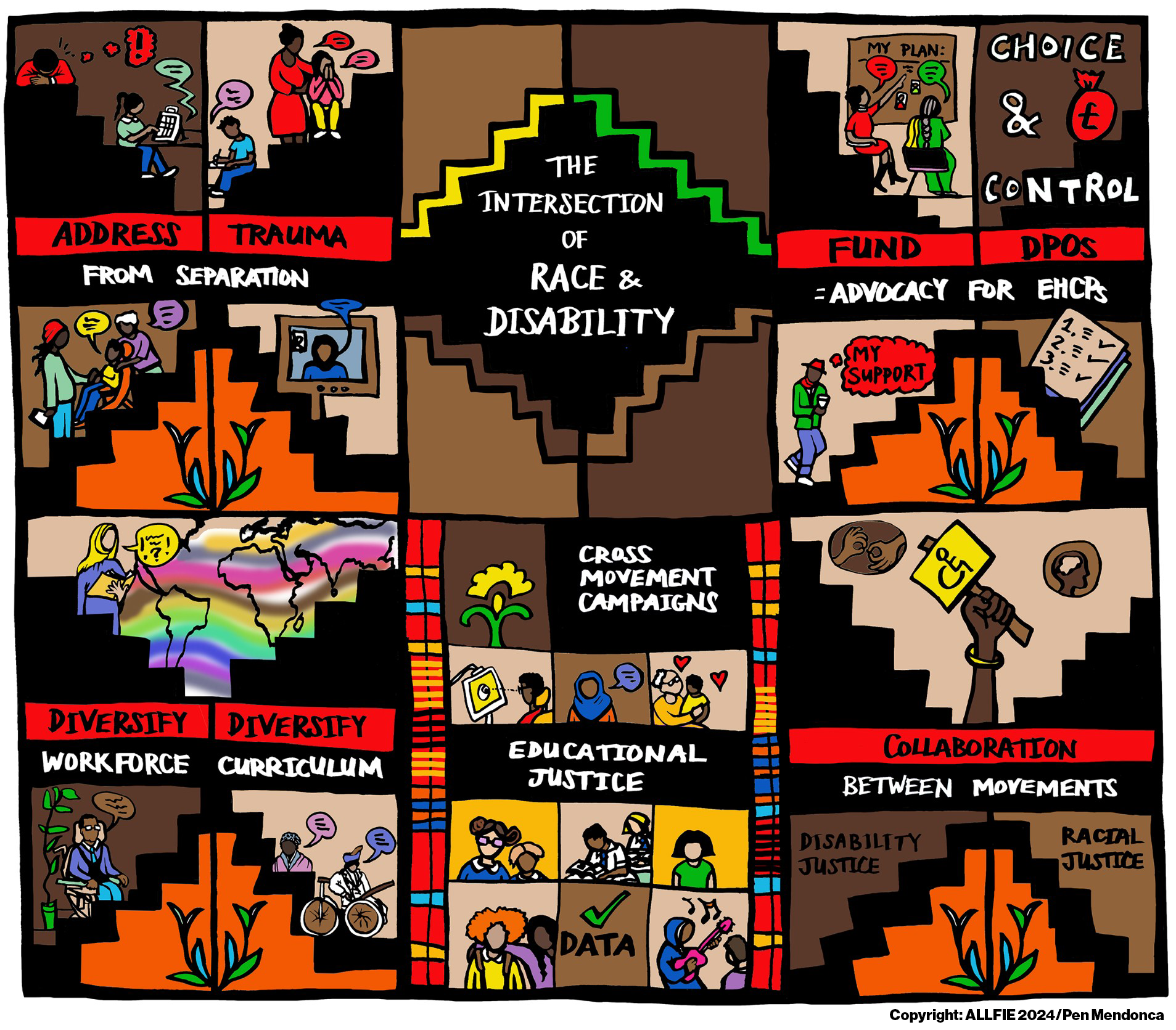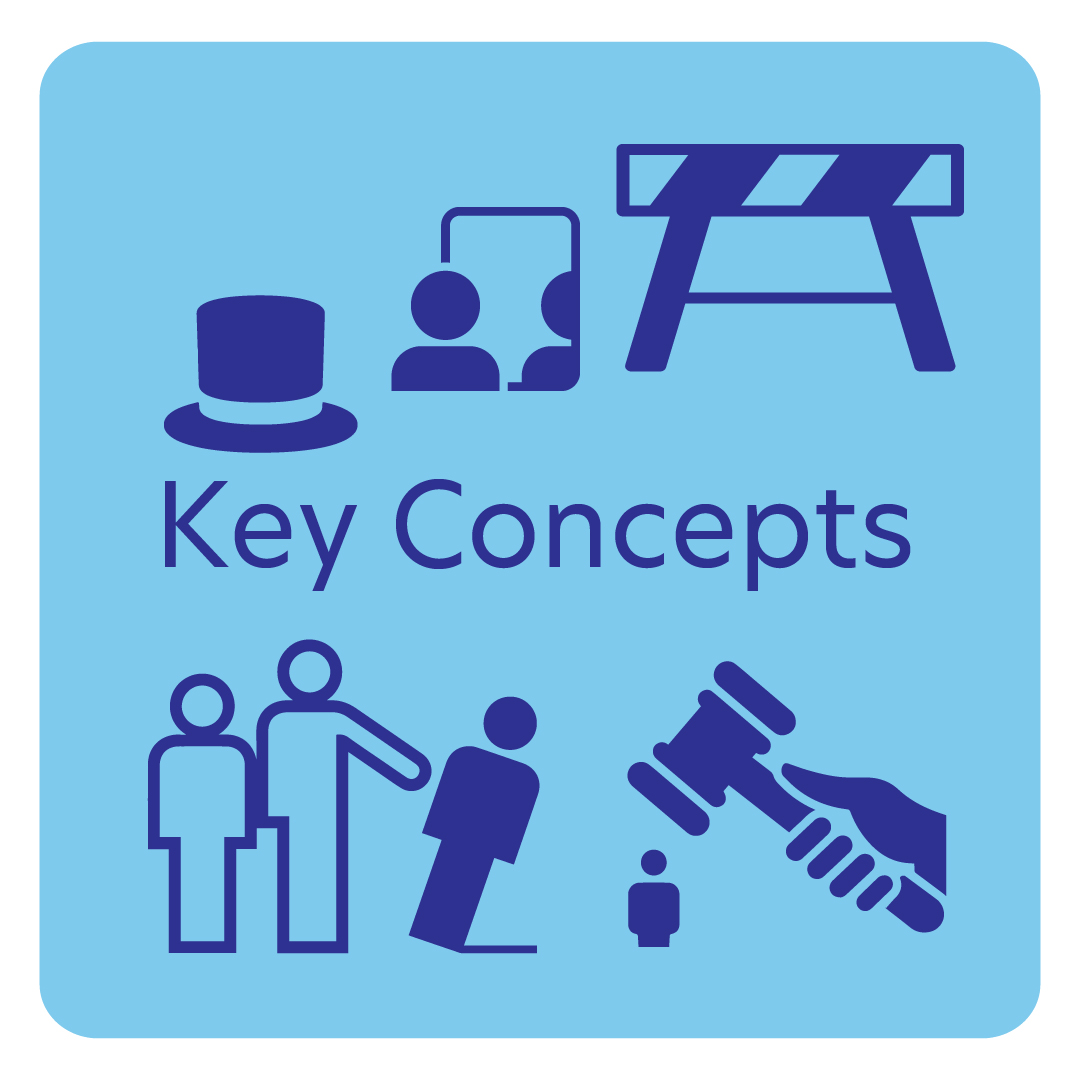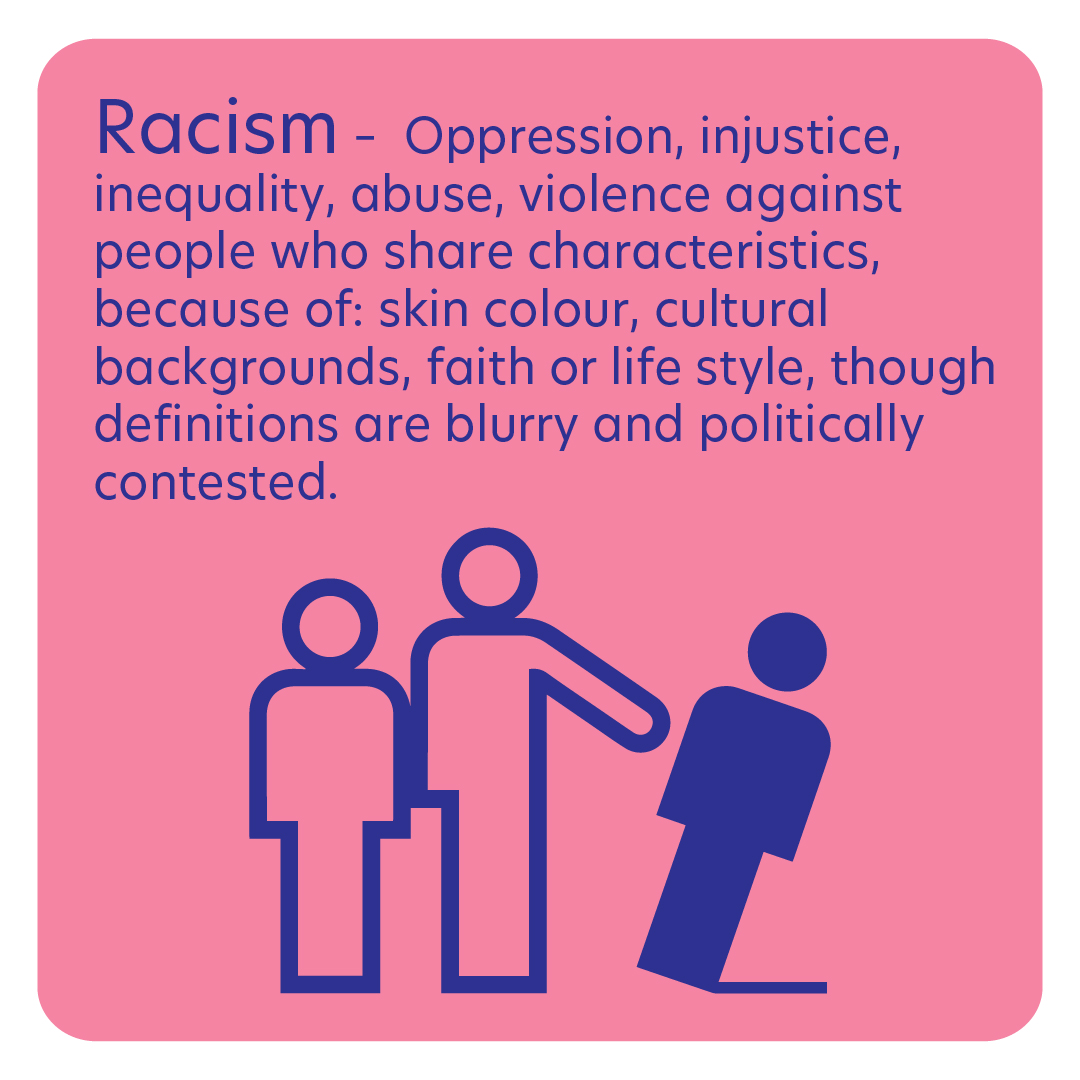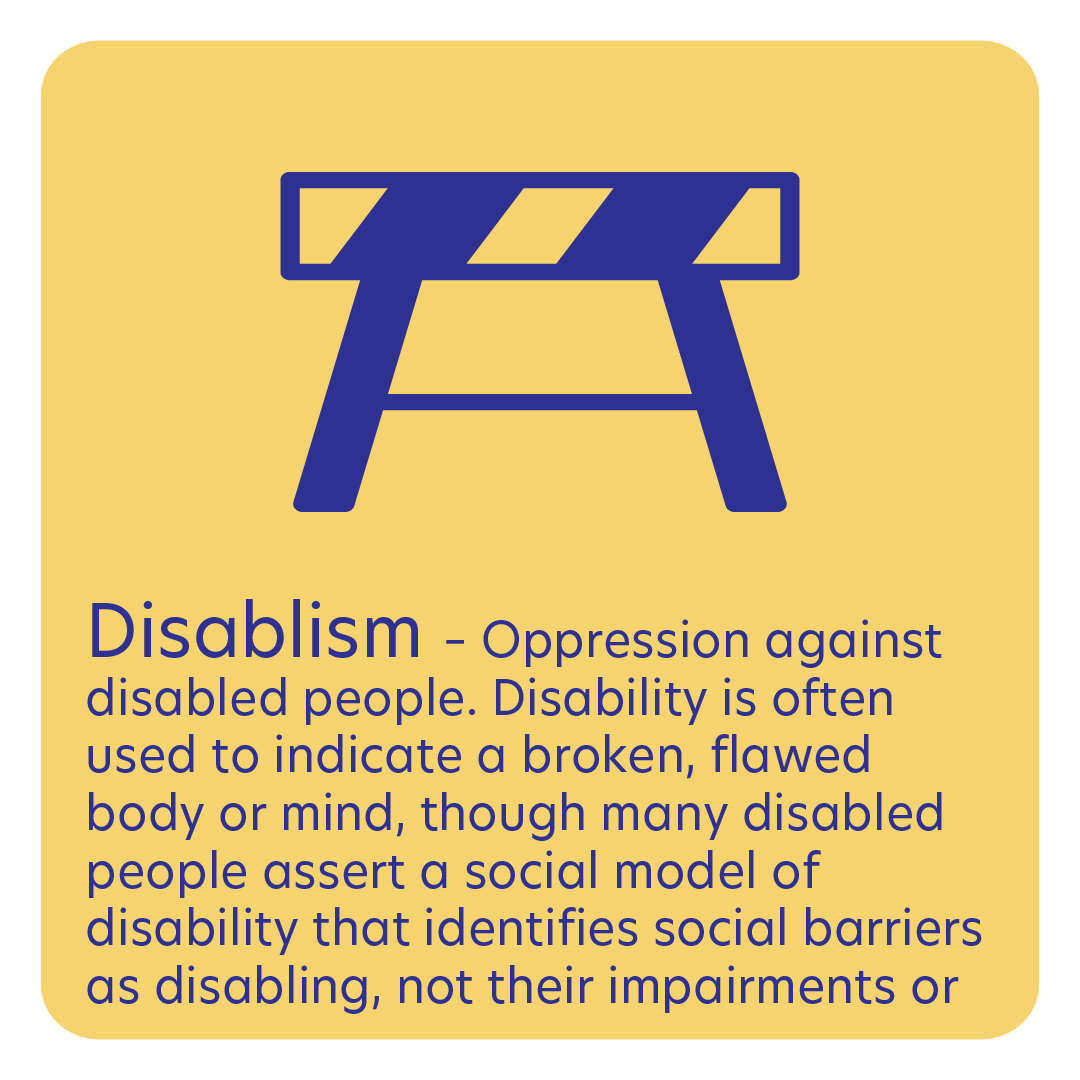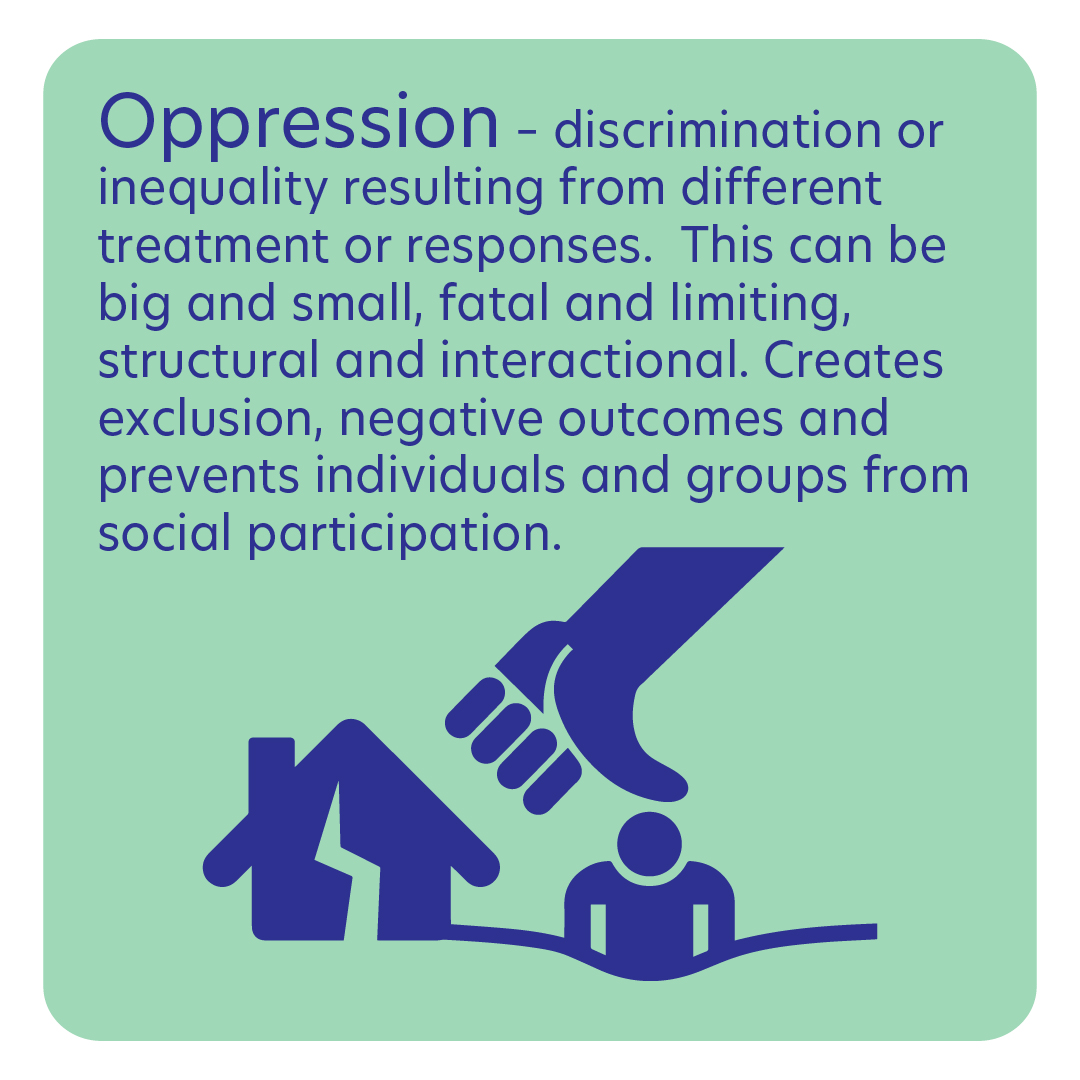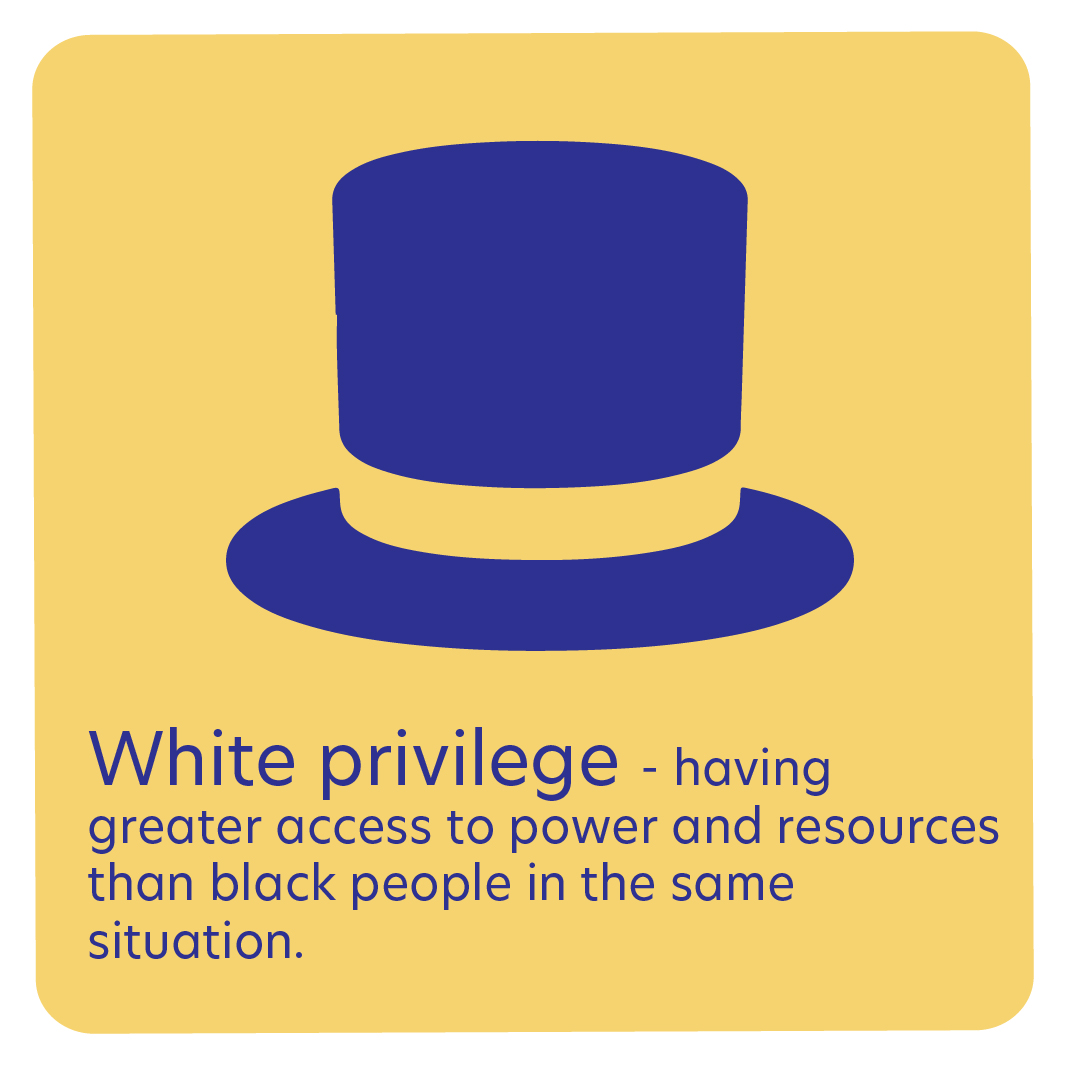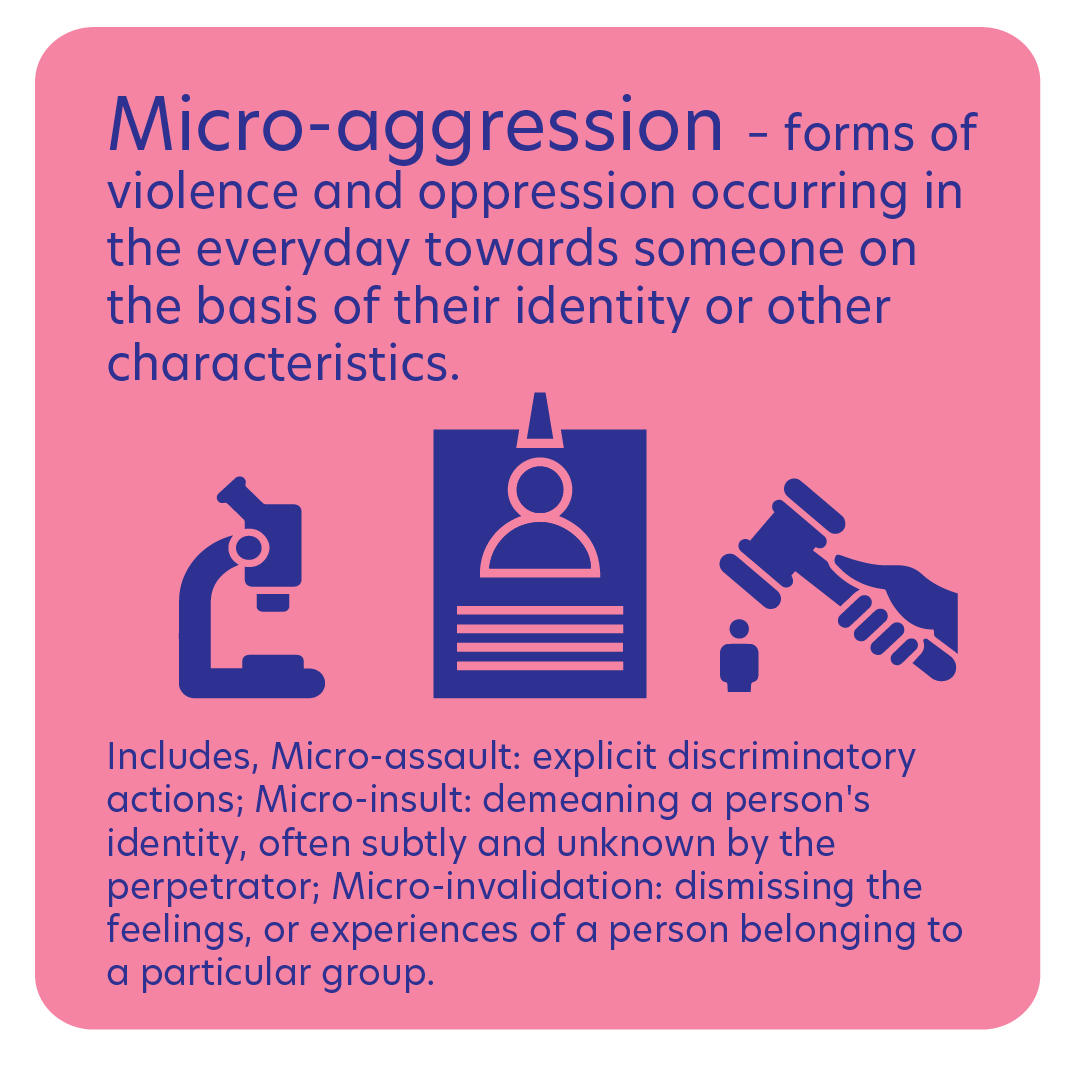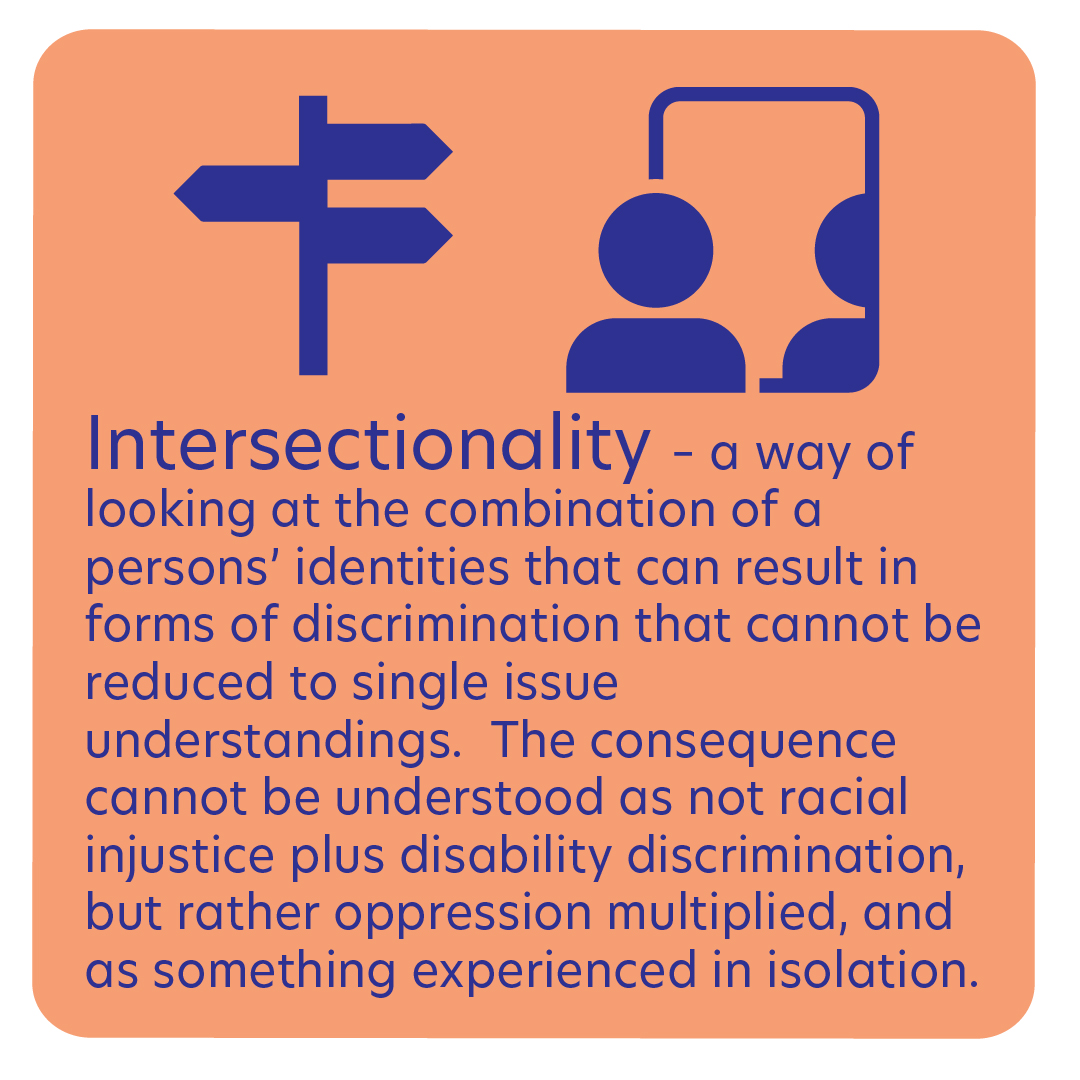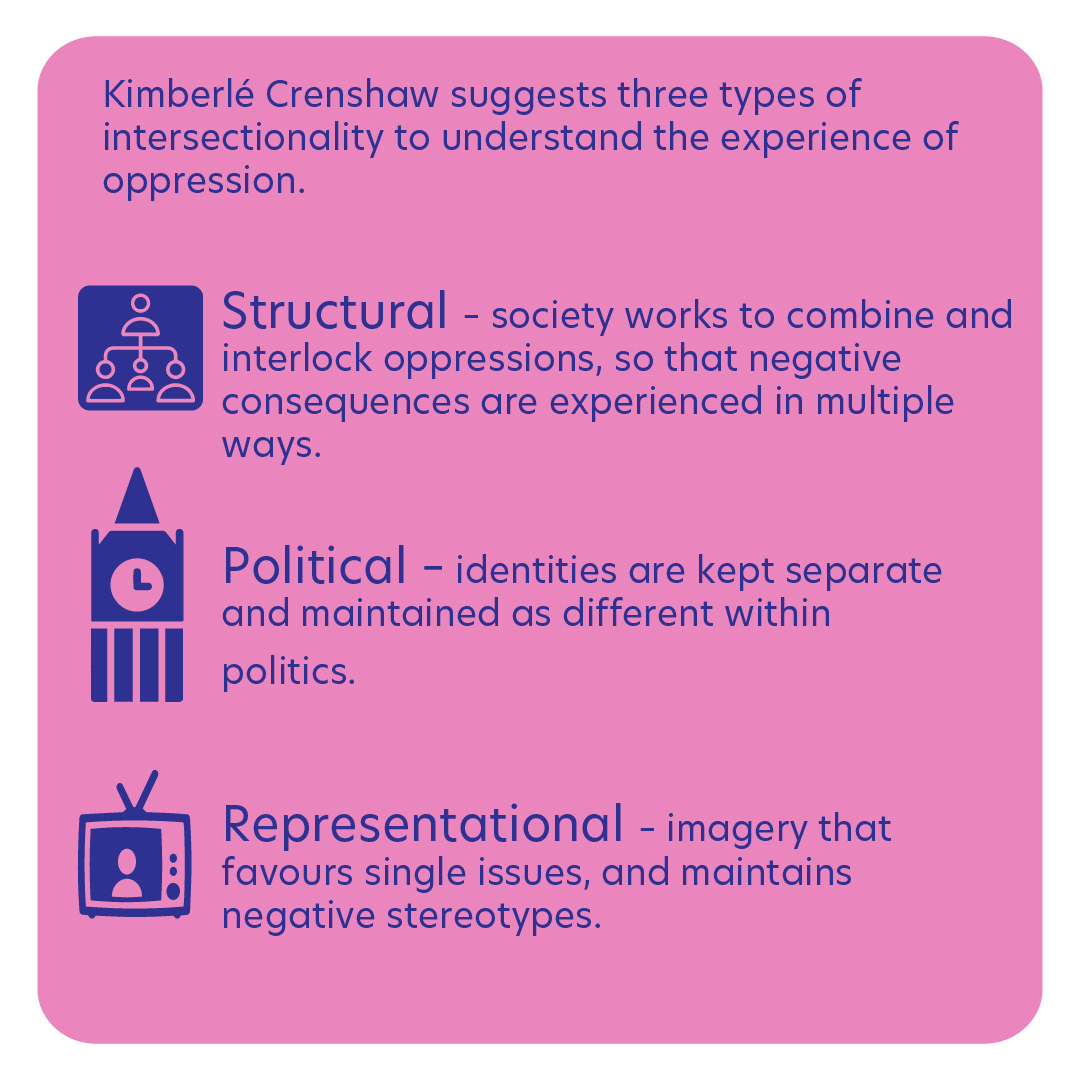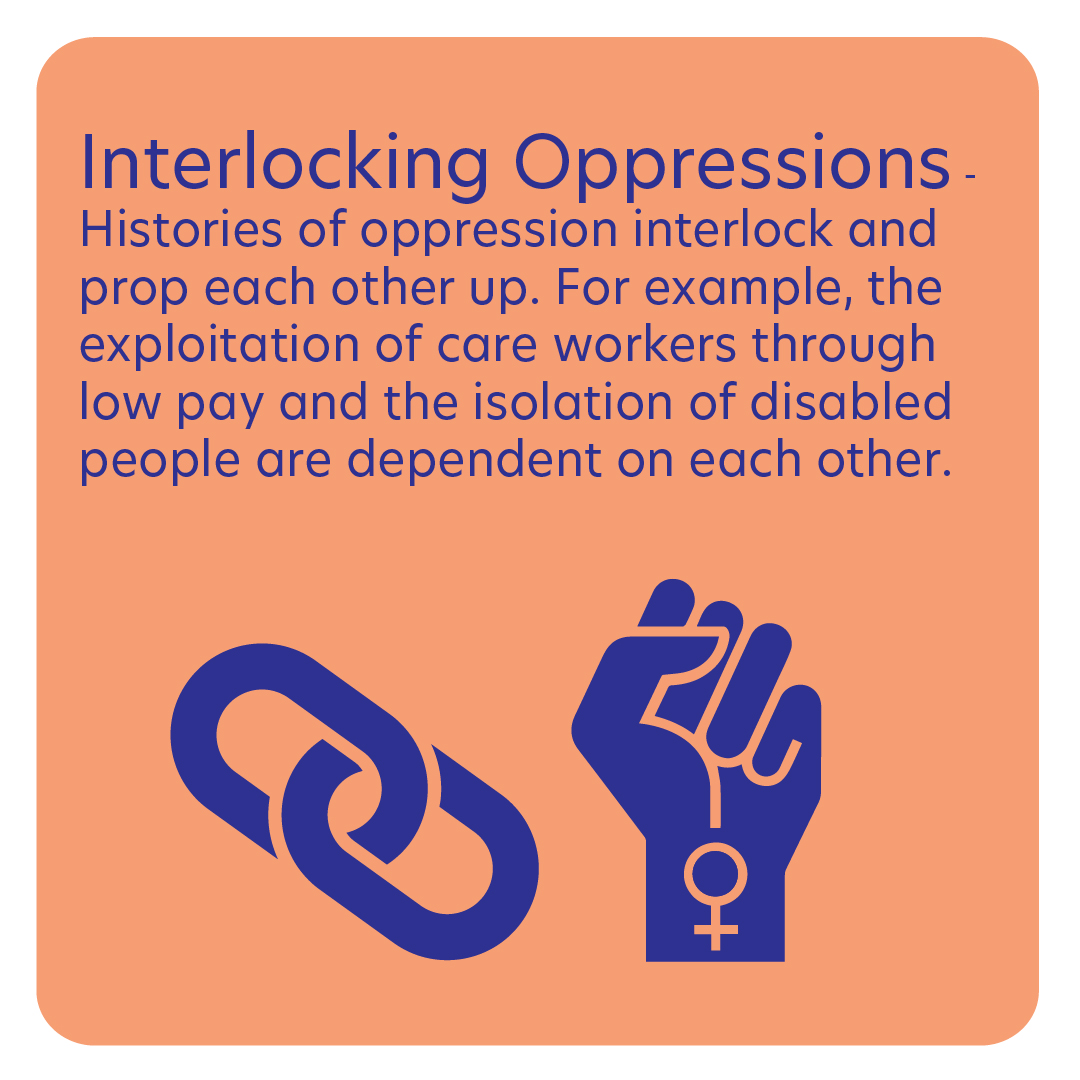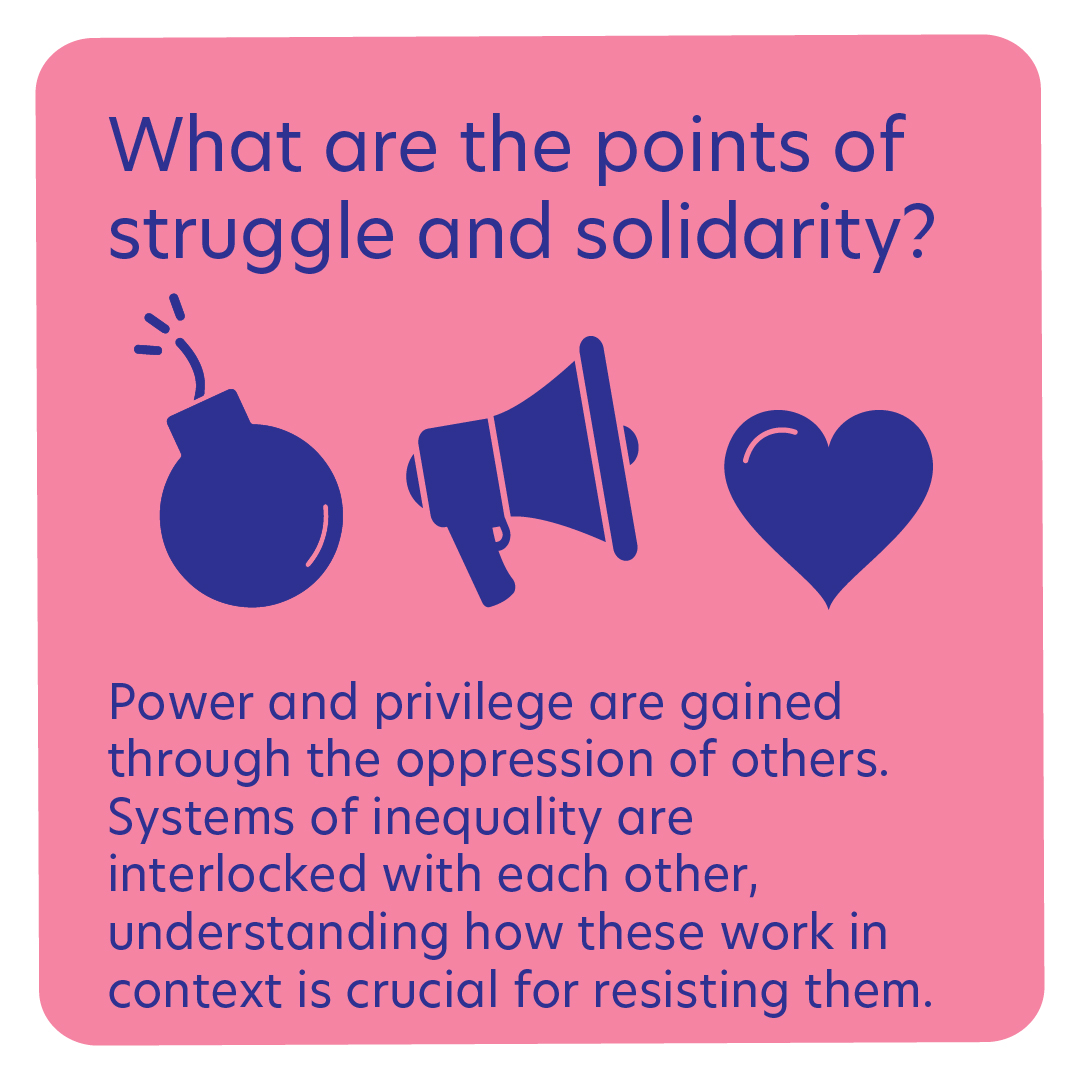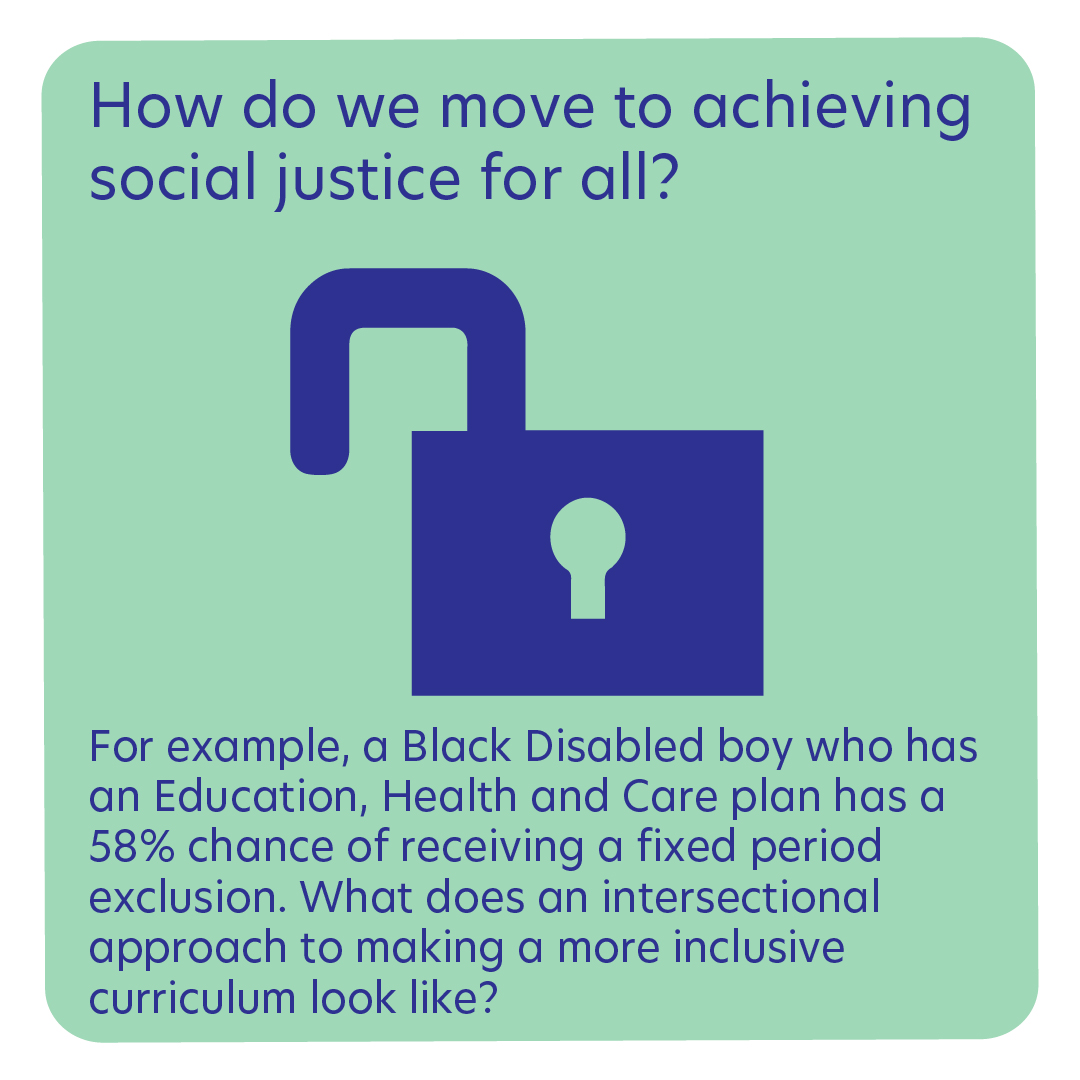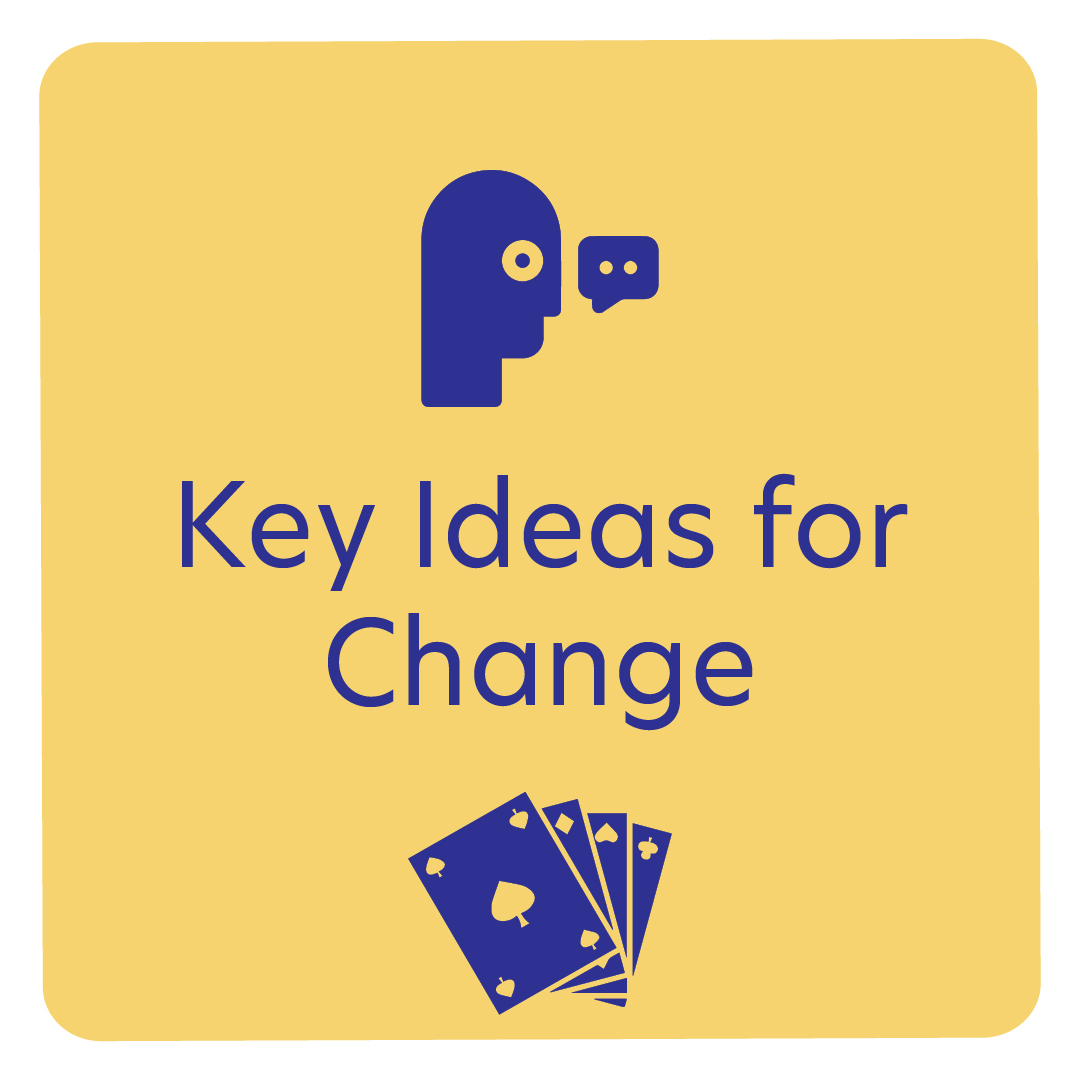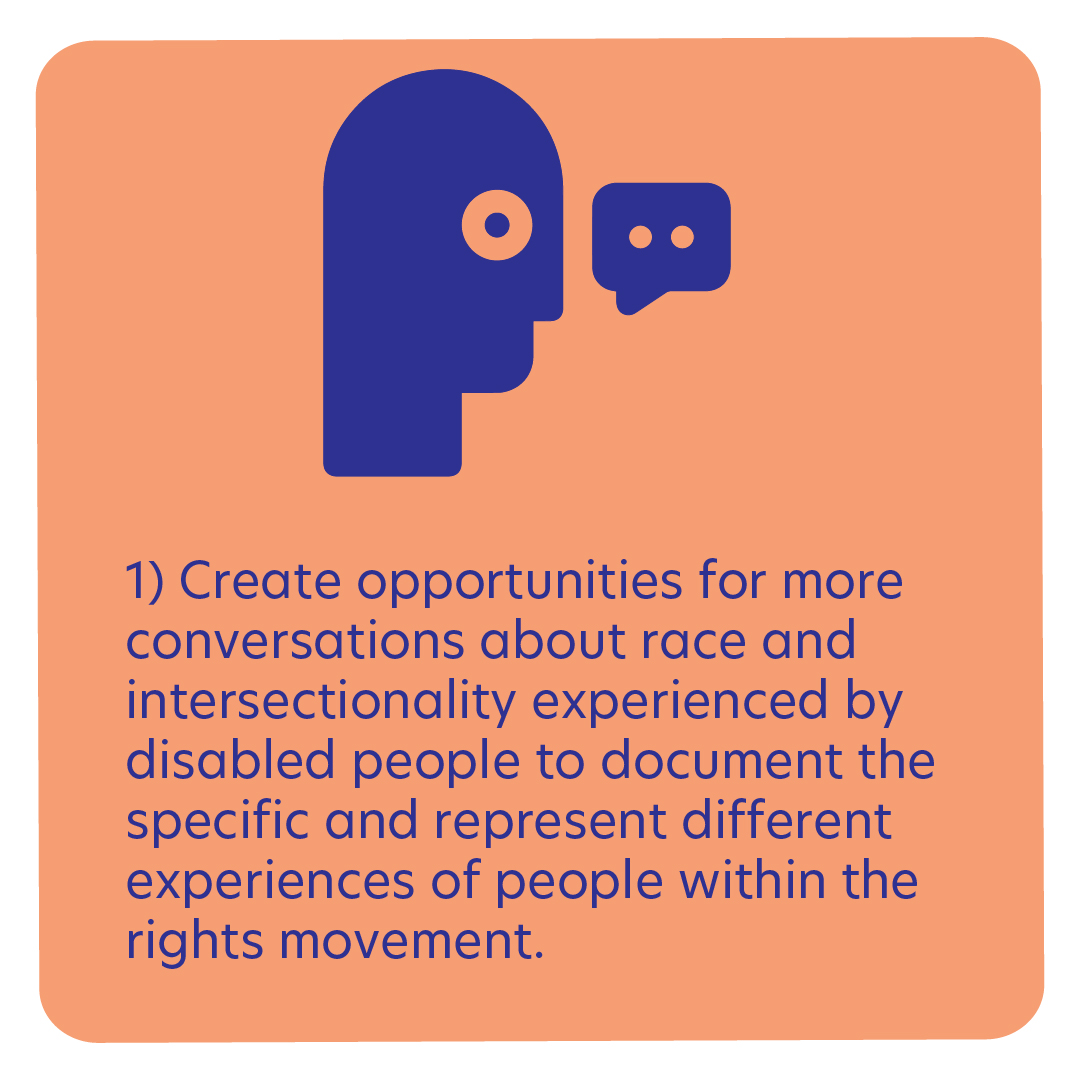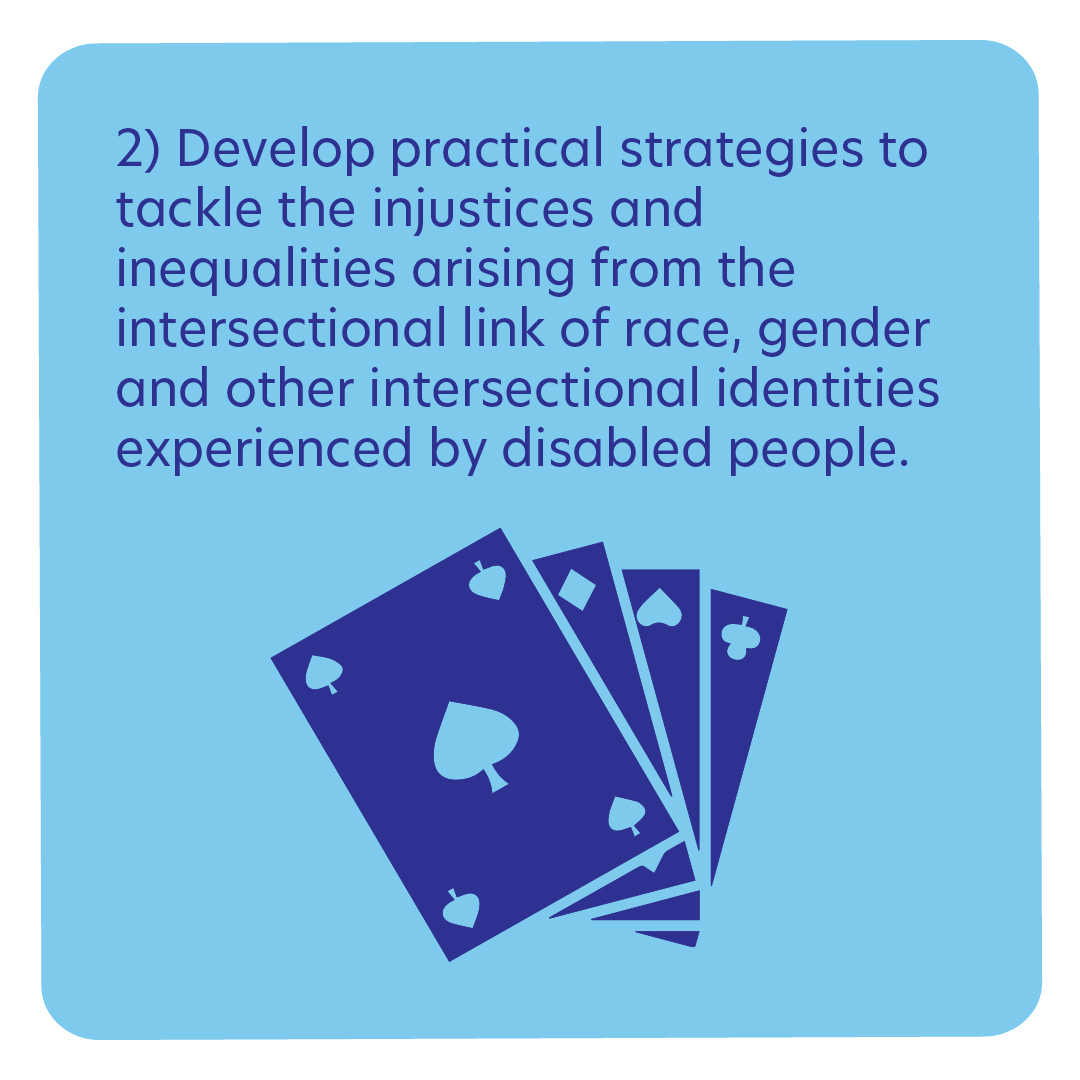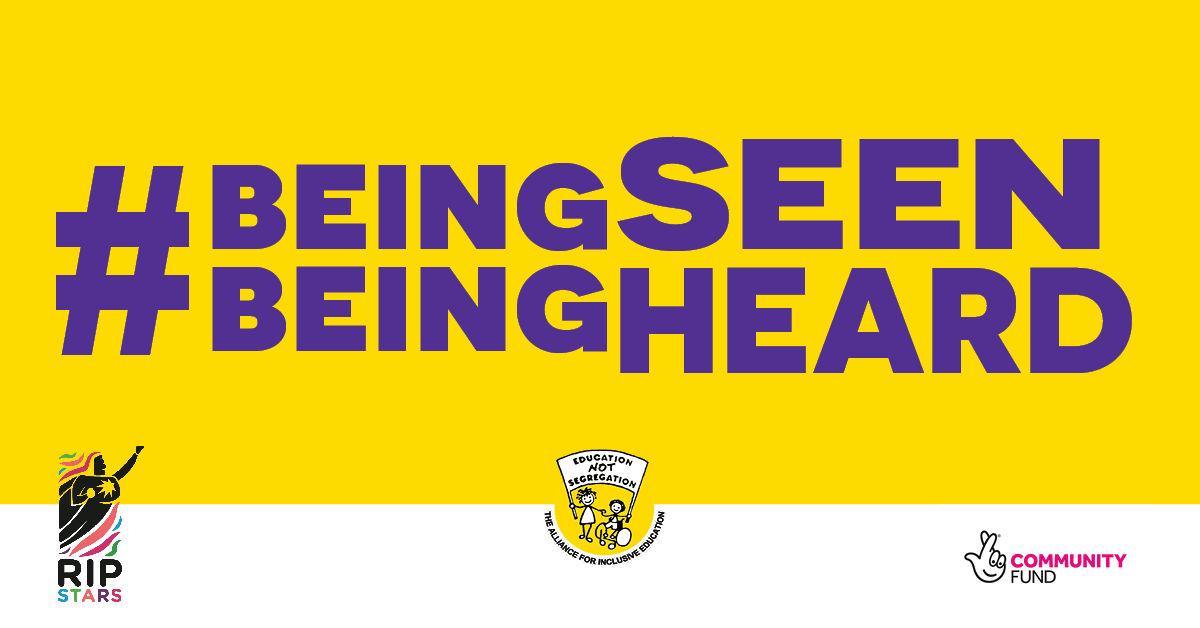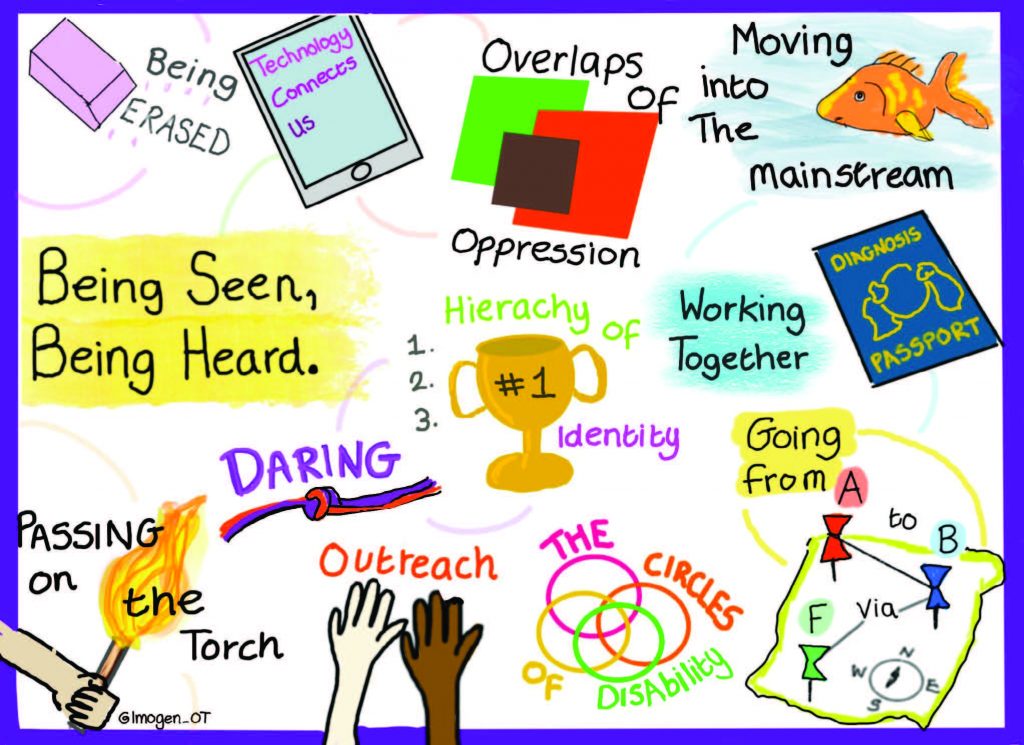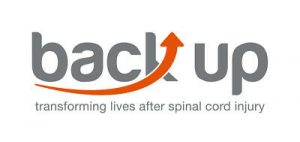Manifesto 2024: Inclusive Education for All
ALLFIE’s manifesto seeks to promote the realisation of the equity, equality and the right to inclusive education for ALL Disabled people, through the necessary supports in mainstream settings. It sets out six demands of the government, to create an inclusive education system and achieve justice in action.

We urge you to Sign our Manifesto and add your comments. Our Manifesto 2024 is also available to download in various formats, including Easy Read:
- Full Manifesto (PDF)
- Full Manifesto (Text only – Word)
- Easy Read Manifesto (PDF)
- Summary Manifesto (PDF)
Our Demands
ALLFIE’s manifesto seeks to promote the realisation of the equity, equality and the right to inclusive education for ALL Disabled people, through the provision of necessary supports and adjustments in mainstream settings. This manifesto sets out six demands for creating an inclusive education system:
- Adopt an Inclusive Education legislation in the UK
- End all forms of segregated education
- Redirect government SEND funding towards supporting and improving mainstream services
- End all forms of Curriculum and Assessment systemic injustice
- Make Inclusive Education Training mandatory nationwide
- Combat Social Injustice in Education
About ALLFIE
We are a Disabled People’s Organisation (DPO), led by and for Disabled people, campaigning to abolish all systemic barriers to our participation in mainstream education. For over 30 years, ALLFIE has demanded equality and equity in education for Disabled people, and their families. We know inclusion works. We believe that an inclusive education system that meets the needs of all Disabled people from childhood, and supports life-long learning, is the foundation to an inclusive society.
We campaign for the realisation of Disabled people’s right to inclusive education, in line with Article 24 of the United Nations Convention on the Rights of Persons with Disabilities (UNCRPD). This Article states that Disabled people have the right to inclusive education and to participate in mainstream education with appropriate support.
Our work is underpinned by the Social Model of Disability, which states that we are “disabled” not by our impairments (such as blindness or autism) but by society’s failure to take our different needs into account. Within education, this includes systems, structures and practices that lead to our marginalisation and exclusion from mainstream educational settings and society at large. We believe that this is oppressive and a social injustice.
What we do
Our work is centred on the lived experiences of Disabled people as a process to understand and initiate ideas for our campaigns. We aim to redress power imbalances and promote Disabled people’s full and effective participation in decision-making, to bring about radical change in law and policy relating to inclusive education.
Our practice takes account of intersectionality to respond to the diverse experiences of Disabled people including other protected characteristics such as gender, race, religion, and sexual orientation as well as different socioeconomic backgrounds.
The UNCRPD and the Right to Inclusive Education
Our manifesto demands are framed within the provisions of the UNCRPD, in particular Article 24, which states:
“States Parties recognise the right of persons with disabilities to education. With a view to realising this right without discrimination and on the basis of equal opportunity, States Parties shall ensure an inclusive, education system at all levels, and life-long learning.” (UNCRPD 2006)
In 2017, its committee concluded that the UK Government is making insufficient progress in realising inclusive education, and that its present education and Special Education Needs and Disabilities (SEND) frameworks are inadequate and discriminatory. It recommended that the UK Government should:
“Develop a comprehensive and coordinated legislative and policy framework for inclusive education and a timeframe to ensure that mainstream schools foster real inclusion of children with disabilities in the school environment and that teachers and all other professionals and persons in contact with children understand the concept of inclusion and are able to enhance inclusive education.” (UNCRPD Committee 2017).
UK law and policy on inclusive education should be guided by this recommendation so that there is confidence that inclusive education settings will welcome everyone. A parent of a Disabled pupil said:
“We need to be speaking about a system that is for all, regardless of ability. In an inclusive world there wouldn’t be mainstream – there would just be education that included all.” (ALLFIE 2019)
What is inclusive education, and do you know why it is a social justice issue?
“Inclusive education isn’t just about dreaming about the future. We don’t just want you to plan for the next generation. We want justice and liberation for those currently in segregated education” (ALLFIE’s Our Voice Young Disabled people, 2024)
Inclusive educational settings are those where non-disabled and Disabled people (including pupils/students labelled with “special educational needs”) learn together in mainstream nurseries, schools, colleges, universities and adult learning in the same classrooms, attending the same classes, lectures and seminars. This means the education system must adapt to include Disabled people and should not require Disabled people to adapt to the education system. Thus, inclusive education involves the removal of the structural and systemic barriers Disabled people encounter in mainstream education settings. It also involves addressing the systemic oppression of Disabled people in mainstream education settings. As articulated by the UNCRPD Committee:
“Inclusion involves a process of systemic reform embodying changes and modifications in content, teaching methods, approaches, structures and strategies in education to overcome barriers with a vision serving to provide all students of the relevant age range with an equitable and participatory learning experience and environment that best corresponds to their requirements and preferences.” (UNCRPD General Comment no. 4 on Article 24).
Inclusive education is a social justice issue because it is about confronting the underlying systemic barriers that perpetuate the marginalisation and discrimination of Disabled people within the education system and wider society. This includes tackling issues such as inadequate funding for inclusive education (especially in under-resourced neighbourhoods), discriminatory policies and practices, disproportionate disciplinary actions, and barriers to higher education for Disabled people. It also includes tackling the barriers that hinder Disabled children and Young people labelled with “complex needs” from accessing mainstream schooling, both in the classroom and in extracurricular activities. In the words of Gray Group International (2024):
“Social justice aims to counter these challenges by ensuring equitable resource distribution, dismantling systemic obstacles, and fostering environments where all individuals can thrive.”
We recognise that it will take time to move from the current education system to one that is inclusive, and it will require radical changes in thinking, policy and practice. As part of a transition process, separate special education settings can be repurposed and used as community resource centres that offer outreach services to support Disabled people in inclusive mainstream education settings and provide community access to resources and equipment.
How Disabled people are being failed by the current education system
Throughout history successive Governments have carried out various reforms to the education of Disabled people and its provisions. Current provisions are based on the Children and Families Act 2014, which sets out a presumption that children should be in mainstream education. Despite this, Disabled Children and Young people, especially those of us who are labelled with “complex needs”, encounter barriers to accessing mainstream education. Barriers are experienced both in the classroom and in extracurricular activities.
In March 2023, the Government launched the Special Education Needs and Disabilities (SEND) and Alternative Provision (AP) Improvement Plan: Right Support, Right Place, Right Time. This plan reiterates the Government’s commitment to invest £2.6 billion for local authorities to open 133 new free special schools between 2022 and 2025. This goes against the intention of Children and Families Act (2014) ‘presumption of mainstream education’ and of achieving inclusive education for ALL Disabled people in mainstream settings.
Meanwhile, schools and local authorities are not adequately resourced to support, or make adjustments, for Disabled children and young people in mainstream settings. Some local authorities are failing to give pupils the support that is recommended in their EHC plans. This is driving Disabled children and young people into special schools or substandard alternative provisions such as PRU (pupil referral unit) and EOTAS (education otherwise than at school) and is denying them the opportunity to access and experience mainstream schooling.
Most local authorities have financial deficits in their overall education budgets – known as Dedicated Schools Grant (DSG) – because the budget for SEND provisions has not increased since 2015 when the government extended the age range of young people who qualify for SEND Support. The Department for Education (DfE) has provided additional funding and support for local authorities with the largest DSG deficits through the Safety Valve and the Delivering Better Value (DBV) programmes.
However, parents have expressed concerns that children and young people are at risk of being denied the SEND Support that they are entitled to by local authorities on the Safety Valve programme since they make a commitment to contain spending on SEND provisions in exchange for this financial assistance. There have also been press reports suggesting that local authorities participating in the DBV programme may face targets to reduce the number of EHC plans. The Government’s response to the latter concerns has not reassured the disability community, parents and other stakeholders that this will not be the case.
The Government plans to replace A levels and T levels with a Baccalaureate-style qualification called the Advanced British Standard in England in the next 10 years. This qualification will combine A levels and T levels into a single qualification, including compulsory study of English and Maths to age 18. Students will also be required to study five subjects instead of the usual three and have more teaching hours in the classroom.
High absenteeism in schools has been a major challenge during the post-pandemic period, with Disabled pupils registering higher absenteeism rates compared to non-disabled pupils. The Government response is to introduce a plan for new ‘attendance hubs’ run by schools with low absenteeism records. The Government also plans to introduce legislation that requires schools to share their daily school registers. We fear that these measures will make schools less welcoming to Disabled children. Current schools that welcome Disabled children, will become more reluctant to continue doing so, as it will be another factor that will impact their school ratings.
Disabled people are overrepresented among those who are in segregated education, not in employment or not in training. Too many Young Disabled people are labelled as NEET. Young Disabled people are also disadvantaged in transition from school to employment workplace training opportunities, with the Supported Internship being exploitative. This is a cause and consequence of marginalisation.
Our Demands – Justice In Action
The following is a list of ALLFIE’s demands in relation to what needs to be done to achieve the vision of an inclusive education system.
1. Adopt an Inclusive Education Legislation in the UK
We demand the recognition of inclusive education as an inherent right for ALL people, and for the voices of Disabled people to be heard and respected on matters of inclusive education.
To achieve this, the Government should:
- Adopt legislation that domesticates the UNCRPD and recognises inclusive education in mainstream settings as a right for ALL Disabled people in line with Article 24 of the UNCRPD. This legislation should:
- Secure Disabled people’s right to equal access to education and learning in mainstream settings at all levels of education and promote life-long education for Disabled people.
- Prohibit all forms of discrimination and systemic injustices against Disabled people in education provision.
- Have measures to address the systemic exclusionary barriers that result in Disabled people being denied equal access to education and learning in mainstream settings.
- Aim to end all forms of segregated education and dual registered provisions in recognition that inclusive education is the foundation to an inclusive society.
- Withdraw all reservations to Article 24 of the UNCRPD and follow the EHRC position with the recognition of a just and equitable inclusive education system for everyone.
- Engage Disabled people and Disabled People’s Organisations (DPOs) as equal partners from the formulation through to the implementation and evaluation of all legislation on inclusive education. This should be done in line with the principles of co-production and collective work, embedding the slogan of the Disabled People’s Movement: Nothing about us without us.
2. End all forms of Segregated Education
We demand clear goals to systematically phase out special nurseries/schools/ colleges/units and other segregated educational settings, prioritising inclusive learning environments for everyone.
To achieve this, the Government should:
- Learn from the good practice and success of other countries (such as Australia) in systematically phasing out segregated schools/colleges/ units, as tools to move forward on making inclusive education a human rights matter for everyone.
- Stop all initiatives to build new special schools and redirect resources towards achieving inclusive education for all Disabled people in mainstream settings.
- End all segregated post-16 programmes such as Supported Internships because these are exploitative.
- Develop a plan to systematically phase out special nurseries/schools/ colleges/units and other segregated educational settings while at the same time ensuring that all Disabled people achieve their right to inclusive education in mainstream settings with appropriate support and resourcing. This will be a move towards the progressive realisation and implementation of the right to inclusive education, in line with the UNCRPD.
- Provide sufficient resources to ensure the accessibility and provision of adjustments for Disabled people at all mainstream educational settings. Ensure that all mainstream educational settings are equipped and resourced to address the support needs of all Disabled people.
- Adopt a unified and better coordinated approach to addressing Disabled people’s educational, health and care needs.
- Support Disabled people in building relationships with peers in mainstream settings. At the same time, ensure that Disabled people are protected from all forms of violence, abuse, torture, bullying, humiliation, and degrading treatment in education settings.
Inclusive education should be achieved within and across the entire education system. All segregated educational institutions, classrooms and programmes should be systematically phased out including at institutions of higher education. Disabled people should be given meaningful and equitable opportunities to participate in apprenticeships, internships and other work-based learning programmes. This should be realised by providing the support that Disabled people require to do so.
3. Redirect government SEND funding towards supporting and improving mainstream services
We demand that inequalities in SEN provisions and disability services are immediately addressed, aiming to dismantle barriers to mainstream education for ALL Disabled people and ensuring provision of consistent and accessible services.
To achieve this, the Government should:
- Establish robust and efficient systems and procedures for delivery of SEN support and disability services that enable Disabled people to enrol and remain in mainstream settings, with the aim of phasing out all segregated schools and units.
- Establish and implement policies and guidelines that are guided by inclusive education principles to ensure consistency and equality within and across the education system.
- Appropriately fund and resource educational settings to ensure Disabled people are not denied admission, excluded or placed at a disadvantage compared to other students.
- Remove all targets that would place Disabled people at a disadvantage within the education system such as Safety Valve and the Delivering Better Value programmes.
- Develop and implement accountability systems for assessing and determining good practices of inclusive education within mainstream settings.
4. End all forms of Curriculum and Assessment systematic injustice
We demand action to address systematic injustice by changing both the curriculum design and the administration of assessment systems, ensuring just and equitable outcomes for all students.
To achieve this, the Government should:
- Develop more dynamic curriculum and assessment systems that do not disadvantage Disabled people on account of their impairments and the lack of appropriate support.
- Re-evaluate the objectives of education and learning to ensure that they are not discriminatory to Disabled people.
- Adopt inclusive teaching practices and stop teaching practices that are discriminatory to Disabled people.
- Address intersectional biases within the curriculum design and teaching practices.
- Adopt flexible assessment and examination practices that do not disadvantage Disabled people.
- Provide adequate resources and support for Disabled people in examinations and assessments.
- End parallel programmes and curriculums designed for Disabled people only.
- Engage Disabled people with the relevant skills and experience on how to make the curriculum and assessment system inclusive.
- Ensure that the introduction of the British Advanced Standard does not disadvantage Disabled people, reducing their chances of progressing to further-, higher-education and employment.
5. Make Inclusive Education Training mandatory nationwide
We demand comprehensive inclusive education training for all teachers and administrators.
To achieve this, the Government should:
- Make training and professional development on inclusive education compulsory in teacher training and have systems for measuring performance.
- Develop and implement in-service training, professional development and capacity building programmes for teachers and administrators to ensure that they are aware of Disabled people’s right to inclusive education and address attitudinal barriers (including stereotypes and misconceptions).
- Ensure shared accountability of addressing and supporting the delivery of SEND provisions and disability services within and across educational settings.
- Provide the required resources and support to effectively teach and support Disabled people in achieving inclusive education.
6. Combat Social Injustice in Education
We demand action to address all forms of social injustice in education, including intersecting disadvantages.
To achieve this, the Government should:
- Adopt educational policies and practices that address all forms of social injustice in education, recognising the diversity of Disabled people’s lived experience and the intersectional disadvantages that some Disabled people experience due to their gender, race, ethnicity, sexual orientation, and socio-economic background. For example, a Black Disabled girl might face discrimination due to a combination of the two or more of her separate protected characteristics (race, disability and gender) as well as other intersecting experiences.
- Give due recognition to the intersection of segregated education provisions, poverty, poor housing, and social capital and put in place appropriate policies and measures to achieve more equitable outcomes in the education system.
- Ensure that the education system responds to the needs of Disabled people from different cultural backgrounds and fosters respect for this diversity.
- Increase representation of Disabled people from different backgrounds in teaching staff and administration.
Glossary
Accessible – a product, service or building that is designed, or has been modified, in a way that allows Disabled people to use it or access it without encountering accessibility barriers. Accessibility is about ensuring that everyone can access information, products, services, and environments in a way that is inclusive and equal.
Advanced British Standard – a new educational framework that will combine A-levels and T-levels into a single qualification for 16- to 19-year-olds in England. Under this qualification students will be able to take a mix of technical and academic subjects.
A-Levels – subject-based qualifications that can lead to university, further study, training, or work. You normally study three or more A levels over two years.
Alternative Provision (AP) – education outside of mainstream settings, arranged by local authorities or schools.
Attendance hubs – government initiative aimed at reducing school absences. These will not address the wider issues of school non-attendance.
Dedicated School Grant – a ring-fenced specific grant that supports local authorities’ Schools budgets.
Delivering Better Value (DBV) programme – a Department for Education (DfE) initiative focused on local authorities reducing spend on EHC plans.
Disabled People’s Organisation (DPO) – an organisation run and controlled by Disabled people.
Education other than at school (EOTAS) – the education or special educational provision of children or young people outside of a formal educational setting.
Education, Health and Care plan (EHC plan) – a legal document describing the special educational needs of a child or young person’s aged up to 25 as well as the support they need, and the outcomes they would like to achieve.
Intersectionality – people’s different experiences based on protected characteristics such as age, gender, race, religion or sexual orientation and socioeconomic background.
Marginalisation – Marginalisation means to treat a person or social group as though they are of less value than others. This can happen when individuals are treated differently from the majority and experience exclusion and segregation.
NEET – Young people (aged 16 to 24 years) not in education, employment or training (NEET).
Oppression – being treated cruelly or prevented from having the same opportunities, freedom, and benefits as others.
Safety Valve programme – a Department for Education (DfE) initiative focused on local authorities reducing spend on SEND provisions.
Segregation – Disabled people are placed away from ordinary experiences with others. For example, Disabled children placed in special schools are given an inferior education to non-disabled people, such as EOTAS.
SEND – Special Educational Needs and Disabilities.
Social Model – The social model of disability is a way of viewing the world that was developed by Disabled people. The model says that people are Disabled by barriers in society, not by their impairment or difference.
Socioeconomic background – A person’s socioeconomic background is measured through specific factors such as income, education, class and occupation. It refers to the background you are from, including the class and education status of your parents.
Systemic barriers – established policies, procedures or practices that discriminate against people and prevent them from participating fully in education, employment and other areas of life.
Teacher – anyone who performs a teaching role in a nursery, school, college, university or adult learning setting.
T-Levels – a two-year qualification for 16 to 19-year-olds designed in collaboration with employers. Each T Level is equivalent to 3 A Levels, with the aim to support the young person to develop their skills, knowledge and to thrive in the workplace.
Lived Experience of Black/Global Majority Disabled Pupils and their Families in Mainstream Education
ALLFIE’s research project about the lived experiences of Black/Global Majority Disabled pupils and their parents about schooling. It explores experiences of mainstream school placement, participation, support and attitudes of school staff, and makes important recommendations to address issues.
- Download full report (pdf): Lived Experiences of BGM Disabled Pupils in Mainstream Education
- Easy-read pdf: EASY-READ Lived Experience of BGM Disabled Pupils in Mainstream Education
- Summary pdf: SUMMARY Lived Experience of BGM Disabled Pupils in Mainstream Education
Summary
This research is about the lived experiences of Black/Global Majority Disabled pupils, aged 11-16 and their parents about schooling. It explores experiences of mainstream school placement, participation, support and attitudes of school staff.
The research found that there is inadequate support for Black/Global Majority Disabled pupils and their families in terms of advocacy, peer support to share information and provide clarity on entitlement, help to empower them and protect children’s right to mainstream education.
Children and young people told us that they would like;
- To have better choice and control over their support, so as to be better able to join in and participate in the range of school activities and opportunities.
- An end to the separation of Black/Global Majority Disabled pupils and recognition of their proud intersectional experiences, not ones based on deficit.
- To have a say in writing school rules and policy, to coproduce practice and build a sense of belonging.
Parents highlighted their concerns to us in terms of;
- That they feel they have little support and limited or no choice about where and how their children are educated.
- An excessive use of disciplinary procedures and practices of surveillance towards Disabled pupils and Black children that result in negative consequences or exclusion.
- Difficulties navigating an education system that is complex and often overlooks intersectional experiences of disability and race.
The current lack of support makes it hard to address any tensions around the intersections between disability and race when navigating the education system. To address these issues, we make the following six recommendations.
Recommendations
- Improve understanding and recognition of intersectional experiences.
Increase the representation of Black/Global Majority Disabled pupils within the education setting and social justice work. - Tackle the trauma experienced through grouping and separation.
Encourage work in schools to address the effects and trauma caused by segregation on all pupils. - Promote independence, choice and control in EHCPs.
Develop advocacy support to ensure EHCPs achieve independent living and human rights of Black/Global Majority Disabled pupils. - Challenge negative attitudes and promote positive representation.
Diversify the teaching workforce, profile more diverse experiences in school and promote learning about intersections of disability and racial justice. - Expose harmful disciplinary procedures and surveillance.
Build a campaign between disability and racial justice organisations to highlight and end disciplinary procedures that lead to exclusion and discrimination of young people. - Challenge segregation, promote participation.
Highlight school intake discriminatory practices affecting Black/Global Majority Disabled pupils, showcase practical and applied solutions that demonstrate how inclusive education can and does work elsewhere.
Acknowledgements
The Alliance for Inclusive Education (ALLFIE) Research Steering Group would like to thank the Runnymede Trust for commissioning a research study which explored the educational experiences of Black/Global Majority Disabled pupils (aged 11-16) and their parents. Your support has been instrumental in driving this project forward, and your commitment to advancing research in this area is appreciated.
We also thank Disabled Black Lives Matter (DBLM)[1] for offering their expertise, support, time and commitment to engage in conversations about this research. They have provided direction and offered a critical voice and meaningful debate about research questions and emerging issues. We wish to extend our gratitude to note-takers and Karima Ali (a former project researcher).
We want to express our sincere gratitude to all stakeholders and research participants (Disabled pupils and their parents) within the London region. This research would not have been possible without their support, and we hope that the issues raised in this report show that their lives matter. We are sincerely grateful for their participation.
Finally, we acknowledge the context in which the issues raised in this report reflect the broader struggles for disability justice by Disabled Activists, campaigners and scholars and the continuing battle for inclusive education.
ALLFIE Research Steering Group
- Dr. Navin Kikabhai, Chairperson of ALLFIE, (University of Bristol)
- Dr. Themesa Y Neckles, DBLM member, (University of Sheffield)
- Tasnim Hassan, Trustee of ALLFIE and PhD Student/Researcher (Durham University)
- Michelle Daley, Director of ALLFIE
- Saâdia Neilson, Disability Justice Consultant and DBLM member
- Iyiola Olafimihan, Disability Justice Consultant and DBLM member
- Okha Walcott-Johnson, Disabled Children and Parent Advocate and DBLM member
[1] Disabled Black Lives Matter is a group of people that campaign to address racial and intersectional inequality of Black Disabled people. DBLM, who situated themselves alongside Black Lives Matter, aim to encourage other Disabled People’s Organisations (DPOs)/movements to aim for racial and intersectional equality.
List of Abbreviations
ALLFIE: Alliance for Inclusive Education
AP: Alternative Provision
DBLM: Disabled Black Lives Matter
DPO: Disabled People’s Organisation
EHCP: Education, Health and Care Plan
ESN: Educationally Subnormal
ITE: Initial Teacher Education
PRU: Pupil Referral Unit
SEN: Special Educational Needs
SENDCo: Special Educational Needs Disability Coordinator
SEND: Special Education Needs Disability
TA: Teaching Assistant
UNCRPD: United Nations Convention on the Rights of Persons with Disabilities
Glossary of Terms
Ableism is based on a hierarchy of ability through notions of able-bodiedness (and able-mindedness); favouring, valuing and normalising the standards of non-disabled people.
Black/Global Majority Rosemary Campbell-Stephens coined the term to promote a sense of collective belonging while addressing the inappropriateness of terms like BAME/BME. Black/Global Majority serves as a unifying term to change understanding and language regarding individuals from Black, Asian, Brown, dual-heritage, indigenous to the global south, and those racialised as ‘ethnic minorities’ (source: https://www.leedsbeckett.ac.uk/-/media/files/schools/school-of-education/final-leeds-beckett-1102-global-majority.pdf).
Disability is often understood as a problem, a tragedy, and often about something that is ‘wrong’ with a Disabled individual. It is a consequence of society’s failure to accommodate the entitlements and rights of Disabled people. The social model of disability interprets disability as discrimination, exclusion and social restriction. Disability as discrimination involves identifying barriers and oppression and recognising power relations.
Disabled people/persons/pupils is an identifying and collective term for a group of people with impairments who identify as Disabled people.
Disabled People Organisation (DPO) is an organisation which is run and controlled by and for Disabled people, and centres lived experiences, uses the social model of disability to address disablism and ableism and applies the UNCRPD.
Disablism is a consequence of disability discrimination—oppressive or abusive behaviour based on the belief that Disabled people are inferior to non-Disabled people (source: https://demos.co.uk/wp-content/uploads/files/disablism.pdf, p.9).
Education Health and Care Plan (EHCP) covers individuals from birth to age 25. This legal document outlines the educational needs and arrangements necessary for a child to enable children/young people to access education and achieve their goals.
Inclusive Education, also called ‘inclusion’, embraces the idea of education that includes everyone, promoting a learning environment where non-disabled and Disabled individuals, including those labelled with ‘Special Educational Needs,’ learn together in mainstream schools, colleges, and universities (source: https://www.allfie.org.uk/definitions/what-is-inclusive-education/).
Independent Living Disabled people are in control and can choose how they care for themselves.
Intersectionality is the idea that different social categories, such as race, class, gender, and disability, interact to produce various experiences.
Learning Support Assistants are individuals allocated to support the learning that takes place in classrooms. This support can be provided in one-to-one situations or small groups. Their role may also involve assistance with tasks such as reading, feeding at lunchtime, or attending to medical needs. These tasks vary and depend on the individual pupil’s needs.
The Medical Model of Disability typically views Disabled people as a problem and tends to label individuals by using medical and pseudo-scientific terms. Disabled people are viewed as disabled by their impairments (e.g., blindness, deafness, wheelchair-user or autism). An objective of the medical model of disability is to cure a person’s impairment, often through medical interventions. When using the medical model of disability, the question of how a Disabled person fits into society would disappear. This approach suggests that society does not need to change to accommodate Disabled people, reinforcing discriminatory attitudes and behaviours. https://www.allfie.org.uk/definitions/models-of-disability/medical-model-disability/
A Personal Assistant (PA) is a person employed by a Disabled individual to assist with tasks, including getting dressed, socialising with friends; enabling the person to achieve independent living and live in their community.
Pupil Referral Units (PRU) / Units / Alternative provisions are segregated provisions designed outside the mainstream schooling system and intended to not place pupils in mainstream schools.
Racism happens when others treat people negatively because of their skin colour, ethnicity or nationality. There are different types of racism, such as institutional, direct and indirect racism. For example, direct racism could be calling someone horrible and hurtful names based on the colour of their skin. Institutional racism creates systemic barriers that disadvantage others because of the colour of their skin, ethnicity or nationality. Indirect racism (discrimination) can occur, for example, when there are policies that apply to everyone but disadvantage a group of individuals because of their skin colour, ethnicity or nationality.
Social justice concerns systemic and structural societal inequalities, addressing equity, equality, inclusion, access, quality, rules, and values and promoting difference and well-being for all people.
Social Model of Disability, a term coined by Mike Oliver in the 1980s, provided the understanding that Disabled people are seen as disabled not by their impairments (such as blindness or autism) but by society’s failure to take their needs into account. (source https://www.allfie.org.uk/definitions/models-of-disability/social-model-disability/).
Special Educational Needs and Disability, ALLFIE defines Special Educational Needs as relating to Disabled individuals regarding the requirements and arrangements for additional educational support.
Special Educational Needs and Disability, in legislative terms, is defined as that which calls for ‘special educational provision’ and a young person is said to have ‘learning difficulties’ if they have a ‘greater difficulties than the majority of children of the same age’ or ‘has a disability which either prevents of hinders the child from making use of educational facilities of a kind provided for children of the same age’. Disability is defined as ‘physical or mental impairment which has a substantial and long-term adverse effect on a person’s ability to carry out normal day-to-day activities. For Disabled people, these definitions are inconsistent and problematic and typically place the ‘problem’ of disability within the individual. (refer to Disability above)
A Teaching Assistant (TA), sometimes referred to as a Learning Support Assistant, is a person who usually assists with all elements within the class and works more closely with the classroom teacher. Their role may also involve reading, assisting with feeding at lunchtime or attending to medical needs. These tasks vary and depend on the individual pupil’s needs.
Territorialised boundaries are associated with the theorisation of space and can be of multiple forms (for example, cultural, of the body, identities). Territorialised boundaries and spaces, related to geopolitics and globalisation, often involve disputes (sometimes violent) and arguments which reflect power struggles. It can affect the role of states and sovereign power. Segregated educational spaces are routinely territorialised, involving vested interests and issues of subordination and power.
Velcro support is a term which describes the possible adverse effect of the role of a TA or LSA who has been assigned to an individual. In this situation, an adult TA or LSA often becomes a barrier, preventing the young person from making friendships with their peers or engaging in everyday interactions by being ‘stuck together’ and not giving space. Velcro support often prohibits more natural peer–support relationships occurring in and outside of schools amongst their peers.
Introduction
This small-scale qualitative research aimed to critically examine the lived experiences of Black/ Global Majority Disabled pupils in the mainstream education system. ALLFIE, a DPO, conducted this research, and its members formed a research steering group of Black/Global Majority Disabled people with lived experience. We intended to understand the disproportionate impact of a failing education system on the often-ignored lives of Black/Global Majority Disabled pupils through their intersectional experiences. Our positionality centred on ALLFIE’s social justice approaches to the social model of disability, disability, lived experience, the United Nations Convention on the Rights of Persons with Disability (UNCRPD) (on Inclusive Education, Article 24) and intersectionality.
The report encompassed focus group interviews with parents and Black/Global Majority Disabled school-aged children. Through participants’ lived experiences of attending a mainstream school setting, this report acknowledges how their lives are directly affected by systems of disablism and racism. It adds to the current inclusive education debates, challenges existing inequalities within the education system and seeks to improve outcomes for Black/Global Majority Disabled pupils.
Given the issues raised in this report, it is essential to acknowledge how disability is framed. For example, in the field of inclusive education, there is an overarching focus on how the ‘requirements’ and ‘needs’ of Disabled pupils are met to enable them to achieve their potential. According to Runswick-Cole (2008) and Beckett (2009), these discussions are framed within an ongoing discourse between a medical model (which focuses on the individual’s impairment and is deficit-driven) and a social model (which prioritises the removal of barriers). This report adopts the position that ‘disability’ is ideologically constructed (Kikabhai, 2022) and that it is the organisation of society that disables people. As Oliver (2009) articulated, over two decades ago:
… the barriers disabled people encounter include inaccessible education systems, working environments, inadequate disability benefits, discriminatory health and social support services, inaccessible transport, houses and public buildings and amenities and the devaluation of disabled people through negative images in the media – films, television and newspapers (Oliver, 2009, p.47).
This report recognises that currently, how various stakeholders seek to improve school life, educational environments and the way multi-agencies work together (e.g., parents, local authorities, health and social care services, Integrated Care Boards [ICBs]) to accommodate various ‘differences’ (Naraian and Schlessinger, 2017) is contested. Indeed, as the literature review highlights, there is increasing segregation under the guise of so-called ‘Alternative’ provision (HMSO, 2023).
Alongside critically examining the lived experiences of Black/Global Majority Disabled pupils’ schooling, the research investigates the intersection of disability and race within this context. This report aims to understand how Black/Global Majority Disabled pupils and relevant stakeholders navigate their educational experiences by identifying connections and themes to enhance the inclusive education movement.
The remaining section of this report focuses on a review of related literature; the methodological approach adopted, key findings and a discussion of the data and recommendations.
Literature Review
This literature review explores the importance of school placement, Education, Health and Care plans and raises critical questions about the continued and persistent inequalities in the education system. In this sense, the Special Educational Needs Disabilities (SEND) system has become even more adversarial and bureaucratic. The review also explores the issue of teachers’ attitudes towards racial equality and draws attention to the problem of representation, or lack thereof, within the teaching profession. The review explores disciplinary procedures and surveillance of behavioural policies and their connection to Disabled people’s experiences of restraints. Finally, this literature review refers to social participation and its relationship to how Disabled people are perceived.
School Placement and Intake
Since the start of modern mass state schooling, school placement for Disabled People and those currently described as having Special Educational Needs has a long history of segregation (Humphries and Gordon, 1992), often in the guise of treatment (Kikabhai, 2014), which later shifted to a discourse of needs (Borsay, 2005; Haines and Ruebain, 2011). Research related to school placement tends to focus on parental choice (parental preference in legal terms) between special educational provision and mainstream settings (Satherley and Norwich, 2021; Bagley et al., 2001; Bajwa-Patel and Devecchi. 2012). There are several vital factors framing this dualistic debate. These include a school’s willingness to accommodate a child’s educational needs, the availability of resources, the special educational teaching (pedagogy), class size, quality of parents-school communication, parents’ and teachers’ attitudes, the proximity of the school to home, and the well-being of the child (Rix and Sheehy, 2014; Mawene and Bal, 2018).
Being a signatory (and ratifier) to the UNCRPD (United Nations, 2006), the United Kingdom has placed a Reservation on Article 24, which primarily means that ‘special’ education is part of its offer. Of course, this contradicts the United Nations’ requirement for Member States to demonstrate the progressive realisation of inclusive education. The UNCRPD (United Nations, 2006) states that Disabled students participate in mainstream settings and have equal access to private and public educational institutions.
Nevertheless, persistent educational barriers exist, including unfair assessments of children’s abilities, exclusion, and inadequate resource allocation, impeding children’s access to mainstream education (Runswick-Cole, 2008; Soorenian, 2019). Moreover, as stressed by Kikabhai (2022), a recent United Nations observation drew concerns about the continued dual education system that segregates Disabled pupils based on parental choice. Compounding the issue of resource allocation, funding for mainstream schools has also been heavily influenced by performance-based criteria and meritocracy.
Research by Leckie and Goldstein (2018, p.22) highlighted that ‘the higher the proportion of disadvantaged pupils in a school, the more [the school] will effectively be punished for the national underperformance of pupil groups.’
Alongside the concern about the UK’s Reservation on Article 24, the number of Disabled pupils in so-called ‘special’, ‘alternative’ and ‘free’ schools has increased as thousands of new special school places were confirmed (Dept for Education and Coutinho, 2023). For example, the UK Government’s (UK GOV, 2023) latest figures for 2022/23 indicate that in England there has been an increase of 87,000 pupils said to have SEN, the percentage of pupils with an EHC plan increased to 4.3% from 4.0%, the percentage of pupils with SEN but no EHC plan has increased to 13% from 2.6%.
Arguably, the increasing number of segregated provisions deprives Disabled pupils of their right to a fully resourced inclusive education system. There is a disproportionate number of Disabled and Black pupils enrolled in segregated school environments. The early work of Coard (1971) identified this trend, using the notion of ‘educationally subnormality’ and how Black Caribbean children were disproportionately placed in ESN settings during the 1960s-70s.
This trend continues in a modified form known as SEND (Skiba et al., 2008; Wallace and Joseph-Salisbury, 2022). In addition, the recent SEND and Alternative Provision Improvement Plan (HMSO, 2023, p.9) introduces National Standards as an approach to delivering funding bands and tariffs.
These standards suggest that Disabled pupils labelled with complex needs are more likely to be placed in a segregated ‘special’ school as a result of these new funding bands and tariffs. A pressing concern arises around how this approach to schooling inadvertently perpetuates racism and ableism. This is because the evaluation of children for admission to special schools is linked to schools’ subjective assessment of pupil’s behaviour, emotions, and communication levels.
Experiences of Education, Health, and Care (EHC) Plan
An Education, Health, and Care (EHC) Plan is “a legal document which describes a child or young person aged up to 25 special educational needs, the support they need, and the outcomes they would like to achieve” (Council for Disabled Children, 2023, p.1). Cochrane and Soni (2020) examine the experiences of implementing and using the Education, Health, and Care (EHC) Plan, emphasising the growth of multi-agency working, which remains complicated and disjointed. This captures many positive experiences and challenges, including parental involvement. Whether the processes genuinely centre children and young people, evaluate the role and knowledge of school staff, and recognise disparities in experiences based on age and different educational stages is still debatable.
Despite aspirations to adopt a holistic approach with the EHC plan, it has been criticised for its reductionist and deficit-oriented characteristics, with a notable omission of the environmental aspect (Hunter et al., 2019). The implementation of the EHC plan faces challenges. For example, families’ access to a Personal Budget from Local Authorities to meet their child’s needs lacks transparency, and schools are expected to grapple with this process unsupported (Adams et al., 2017; Blatchford and Webster, 2018; Cochrane and Soni, 2020).
Given the significance of the Government’s SEND and Alternative Provisions Improvement plan, it is disappointing that the report failed to take an intersectional approach. However, it is noted that the report did ‘highlight some disparities concerning certain characteristics such as place, gender and race’ (HMSO, 2023, p.43). The report notes their absence in these areas. It fails to point out the consequences of homogenising Disabled people and their families to a singular characteristic and social background, as well as the way this report is implemented.
The report has committed to using the Regional Expert Partnerships to engage ‘… the voices of all children and young people with SEND or in alternative provision and their families are effectively heard, and no group is disadvantaged …’ (HMSO, 2003, p.43). This is particularly disconcerting, especially given that as of June 2023, ‘Travellers of Irish heritage’ and ‘Black Caribbean’ students had the highest prevalence of individuals with EHCPs.
There has also been a constant increase in appeals challenging EHCP-related decisions. A consistent trend emerges when examining the outcomes of SEN/D tribunal appeals, as 96% of the outcomes in the 2021/22 period were in favour of the appellant (same as the previous year). Notably, this does not make any reference to race or ethnicity.
Teachers’ attitudes, competence, and workforce
Research indicates that teachers in mainstream educational settings generally have a positive, inclusive attitude. However, its implementation needs to be revised. For instance, Center and Ward (2006) highlight that there is a lack of confidence in being able to provide support, and Avramidis and Norwich (2002, p.129) emphasise that there is ‘no evidence of acceptance of a total inclusion or ‘zero reject’ approach’, finding that this is selective. About diversifying the curriculum and supporting diverse needs, there has been a notable surge in the desire to promote racial equality (Klein, 1993; Hall, 2021; Batty et al., 2021). However, despite this increased interest, it has become increasingly evident that educators lack the confidence and training to implement more diverse content effectively (Petitions Committee, 2021; Joseph-Salisbury, 2020). Perhaps even more ignored, references to disability remain relatively minor and not given appropriate consideration, as pointed out by Beckett (2009).
Further, Kikabhai (2022) suggests that within diversity work, not only is disability intentionally ignored, but it is also silenced and erased. It has been felt that staff have had limited training to support inclusion – particularly in universal learning design (Dolmage, 2017). This highlights teachers’ considerable challenges, including time and training limitations and insufficient guidance in addressing ‘challenging’ or ‘sensitive’ subjects. In light of this, the University of Manchester and Runneymede Trust’s Making History Teachers briefing (Lidher et al., 2023) highlights the urgent requirement for the Department of Education to establish structures enabling extensive professional development for all educators.
Enhancing teacher training is crucial to prepare and support teachers adequately. For example, Lidher et al. (2023) underscore the necessity to update both the Teachers’ Standards and Initial Teaching Education (ITE) with a more substantial commitment to addressing anti-racism, inclusion, and diversity issues. It is known that there are significant tensions with ITE when it comes to Disabled people and so-called ‘Fitness to Teach’ standards that often act as a barrier rather than an enabler to the teaching profession, particularly for individuals who identify as having mental health difficulties (differences), experience distress, identify as neurodivergent individuals, and/or are survivors/users of mental health/psychiatric services (Pattinson and Kikabhai, forthcoming).
There exists poor representation within the teaching workforce, which is linked to lowered expectations for Black/Global Majority Disabled pupils. For example, there is a ratio of one white teacher for every 13 white pupils. In contrast, a stark imbalance exists of one Black teacher to every 42 Black students, exacerbated in other domains and senior roles (Hillman, 2021; Wallace and Joseph-Salisbury, 2022). It is necessary to question that both of these datasets lack intersectional overlap and knowledge regarding whether teachers are Black/Global Majority Disabled people. There is also an omission of disability data obtained for teachers (Office for Statistics Regulation, 2023). Hence, it can be strongly inferred that there is a significant lack of educators with diverse and intersecting experience.
Disciplinary procedures and surveillance
There are other inequalities in behavioural policy. There are three specific groups of children and young people who are disproportionately affected by behavioural policies in schools, namely, those identified as having SEND, individuals from racially diverse communities (including Black students and those from Gypsy, Roma, and Traveller backgrounds) and students from under-resourced backgrounds (Gillborn et al., 2013). Between 2018 and 2022, in England and Wales, data from the Children’s Commissioner revealed at least 2,847 documented strip-searches of children conducted in schools and outside schools before arrest under stop and search powers, with the report highlighting a significant six-fold over-representation as 38% of the strip-searched children were Black, a group constituting 5.9% of the population (Dodd, 2023). This is compounded by the Child Q scandal and the perpetuation of negative stereotypes through Prevent Duty (Home Office, 2023; Runnymede, 2023; Zempi and Tripli, 2022). Additionally, law enforcement has been assigned to areas ‘with higher numbers of pupils eligible for free school meals, which correlates with higher numbers of Black and ethnic minority students’ (Runnymede, 2023, p.2).
Disabled students have a higher probability of being subjected to restraint or seclusion in school, as indicated by recent reports indicating that 88% of reported incidents involved children or young people, including students identified as having SEN/D (The Challenging Behaviour Foundation, 2019; Hodgkiss and Harding, 2023). Regarding monitoring the use of restraints in schools, the Equality and Human Rights Commission inquiry (Equality and Human Rights Commission, 2021) highlighted confusion and inconsistency in school restraint policies; schools varied in how they record restraint incidents, especially in distinguishing between types.
Many are uncertain about specific forms of restraint, and some do not promote categorising incidents by protected characteristics. Additionally, as Worth (2013) highlighted, Disabled students can be heavily monitored by supporting [sic] staff in controlled environments. Interestingly, Ktenidis (2023, p.1) contends that some problems associated with TA support relate to structural inequalities that recreate exclusion. Further still, Ktenidis (2023), drawing upon the experiences of Disabled students in secondary school, makes the point that TAs carry out their duties ‘under the guise of support’ and often aim for normalisation. It has been known that there are disadvantages to using TA support. For example, Gerschel (2005, p.71) referred to the ‘velcro’ model in terms of recognising the possibility of students becoming emotionally dependent on the TA.
Social Participation
A crucial aspect of school life involves social inclusion, as frequently depicted in literature through attitudes, approval, a sense of belonging, and the formation of friendships (Carter and Hughes, 2005; Petry, 2018). Attitudes towards disability significantly shape whether Disabled students receive more positive or negative experiences (Freer, 2023). Research tends to be more skewed in highlighting persistent barriers, irrespective of the type of education setting, such as challenges developing meaningful friendships, experiencing bullying and exclusion due to being perceived as different, non-disabled peers reluctant to befriend Disabled people and those labelled as having SEN, feelings of isolation, and a lack of opportunity (Shah, 2007; Edwards et al., 2019; Woodgate et al., 2020; Helman, 2009; Batorowicz et al., 2014).
Despite this dominant narrative, researchers such as Avrandis (2012) and Shah (2007) evidence some positive experiences. A recurring message emphasises the significant role that inclusivity-focused environmental elements, such as school staff and resources, can play in mitigating marginalisation (Baker and Donnelly, 2010; Anaby et al., 2012; Avranidis, 2012).
In summary, while it is evident that additional efforts are needed to address the educational barriers experienced by Black/Global Majority Disabled pupils, young people and their parents, this review aimed to highlight emerging issues that could provide insights into their experiences.
Multiple layers contribute to shaping the experiences and narratives relevant to this group. Institutionally, neoliberal, pursuing profits, and systemic deficit-driven inclinations affect the availability of support and the procedures for obtaining it and, consequently, shape student placements and intake and entitlements under the EHC plan.
This influence extends to the teaching workforce and various agencies, characterised by punitive and controlling practices aimed at achieving ‘normalcy,’ a lack of confidence, and enforceable legislation in supporting diverse student requirements and limited literacy regarding issues of race and disability. These factors collectively contribute to a societal narrative that detrimentally affects Disabled students’ overall sense of belonging within mainstream educational settings.
Methodology
This section explains the methodological approach that was adopted during the research. It presents its conceptual frame, which primarily describes how knowledge is gained. It also discusses online focus group interviews, the analytical approach, and research ethics issues. We were interested in critically examining the lived experiences of schooling for a small group of Black/Global Majority Disabled pupils in the mainstream education system.
Conceptual Framework
The research adopted an interpretivist perspective within a philosophical and conceptual framework of social constructionism (Burr, 1995), using focus group interviews as the sole method of data collection. We were particularly interested in gathering qualitative data to understand the lived experiences of Black/Global Majority Disabled pupils and their parents about mainstream schooling.
We were interested in challenging taken-for-granted ideas about schooling, seeking to understand the daily interactions of pupils and parents with schooling staff, recognising that these are socially, culturally, and historically situated. In Berger and Luckaman’s (1991) terms, we are interested in the social construction of everyday life, and in this context, with an analysis of schooling, particularly about how the lives of Black/Global Majority Disabled pupils and their parents are constructed.
Focus Group Interviews
Fitting within adopting social constructionism, focus group interviews allow participants to ‘… articulate those normally unarticulated normative assumptions’ (Bloor et al., 2001, p.5). As such, we were keen to understand the barriers, challenges, strategies and participation experiences of the individual participants and their collective experience.
The two online focus group interviews were arranged with four (4) Black Disabled young people/children aged 11-16 years of age and three (3) parents of Black Disabled pupils/young people. Initially, potential participants were recruited through social media and parent networks. Greenbaum (1998) said these focus group interviews would be more accurately termed mini groups. Uniquely, each of the online focus group interviews, mini groups, were facilitated by four members of the research team; this included an interviewer (moderator), a safeguarding lead who was available if any of the participants felt they wanted time-out and somebody to talk to, a timekeeper, a coordinator who provided technical support and a notetaker.
All participants were sent a focus group interview schedule (Appendix D). Both online focus group interviews lasted approximately 60 minutes and were digitally recorded and transcribed. The digital recordings were sent to a professional transcription service for verbatim transcripts. All focus group participant names were anonymised, we recognised the cultural sensitivity around using appropriate pseudonyms rather than engaging in acts of cultural and identity (agency) erasure.
Analysis
Once verbatim transcripts were available, key themes were identified across and within each of the transcripts. The research adopted critical discourse analysis to focus the group on topics, ‘… tapping into group life …’ (Bloor et al., 2001, p.50), searching for similarities, noting differences, and particularly interested in analysing social and political inequalities.
Ethical Considerations
Participants were provided with an Information Sheet (Appendix B) which described the purpose of the research, what the participation would mean, how participant data would be protected and stored, reassurance about the confidentiality and anonymity of the data, and participants’ right to withdraw without having to provide a reason.
All focus group participants were sent a consent form (Appendix C) before participating in the research. Online focus group interviews were recorded via Zoom and stored in password-protected folders on ALLFIE’s server. Issues of confidentiality were particularly stressed during online focus group interviews.
During focus group introductions, the interviewer stressed this particular point; the specific focus Group interview extract is:
Extract: FG160623
11 … In terms of confidentiality, I’m sure you
12 would appreciate that, given that we’re going to be talking as a group,
13 we may not know each other. And so, therefore, after the focus group,
14 we would ask you to refrain from talking about the contents of this
15 particular interviews with other people. And I’m sure you’ll be close to
16 other people and it’ll probably be very tempting to talk to somebody
17 and if you needed to talk to somebody, please reach out to us again
18 if you just needed to debrief or anything like that. …
Another ethical consideration was the late arrival of one of the pupils and their parents, who had connected via their mobile phone network during their focus group interview.
This caused some intermittent network failure and delays in re-connectivity. Fortunately, technical support was available to assist and facilitate reconnection.
Findings, Analysis and Discussion
The main priority of the findings, analysis, and discussion is to develop knowledge about the experiences of Black/Global Majority Disabled pupils and their parents in mainstream education to inform campaigns and advocacy that take a social justice approach. This section focuses on five issues drawn from the findings and offers a discussion and analysis in conjunction with the previous literature. The five issues relate to school placement, experiences of EHCP, teacher attitudes, disciplinary procedures and surveillance, and social participation.
School placement and setting
Pupils provided insightful reflections on what it is like to study alongside non-disabled peers within a mainstream setting. Noeline made a notable observation that highlighted the importance of how she conveyed her findings about the separation of Black/Global Majority Disabled pupils and their exclusion from the larger school community.
To illustrate this point, Noeline raised the following:
… there’s a person in year seven uses a wheelchair, but I don’t see them around that much.
(Noeline, Focus Group Interview, 2023)
Noeline continued to elaborate on the extent of separation between the pupils, with some of the Disabled pupils being placed in different parts of the school building, with required authorisation, explaining that:
[There’s] a place where wheelchair and Disabled pupils go there, and nobody’s allowed there, it’s locked… Like only there’s, there’s not a buzzer. The teacher has to get the card.
(Noeline, Focus Group interview, 2023)
This is worrying, as Kikabhai (2023) noted. These territorialised boundaries, part of the landscape of social power, maintain social order and control. It seems that the effect of this practice creates internalised oppression that reinforces the marginalisation of racialised and non-racialised Disabled people.
Our discussions with parents largely revolved around the parents’ decision-making process and their experiences throughout the school journey. Parents’ experiences primarily presented the main barrier to admission to mainstream school was compounded with them having to position a more impairment-specific priority, disregarding the intersections of disability, race, gender and other experiences of their Black/Global Majority Disabled pupils.
This is highlighted in parents’ decisions in determining an appropriate school for their children based on the school’s SEND services and support (Rix and Sheehy, 2014; Mawene and Bal, 2018).
This point was notably clear from Omnira’s experience:
I went through a process of choosing the school, so I contacted the schools I thought would be good for them, and what I looked for was their SEND and Provision Department. So, what does their special needs department look like? What do they do? How educated are they in terms of SEND? So, I contacted the schools on my list, and I did like a process of elimination. I chose what I feel is the best of the worst. I don’t feel any school really encompasses what it is to be a disabled child because I don’t think that it’s personalised and it’s just based on their systems. (Omnira, Focus Group interview, 2023)
It is also noted that parents’ attempt was not to negate considerations pertaining to their child’s race, gender and social class background in their search for a school. Omnira explained it this way:
… I didn’t look at their experience in terms of ‘race’. I looked at it in terms of practice in the school practice because I couldn’t look at it as ‘race’ because there’s no commonality between us, there’s no education between us, so I couldn’t, and I didn’t know any other disabled children that were Black that was in that school. (Omnira, Focus Group interview, 2023)
This indicates that these parents’ experience navigating the SEND system defaulted to suit White Disabled pupils.
This was also compounded by a lack of peer support for Black parents of Disabled pupils, as highlighted by Njoki:
I think at the time, what I didn’t have was a good network in terms of other parents who had additional needs, and for me, I think that was probably the biggest thing because, actually, that is a really good indicator when you talk to people about the actual experiences.
(Njoki, Focus Group interview, 2023)
Zina’s strategy involved searching online and tapping into social networks, and what is particularly significant is hearing from shared experiences of the support received that ultimately helped inform their decision:
Once I’d had my eyes set on that started looking at their SEND programme and what their SEND legislations they had at that school. I also have a friend who’s a Social Worker, and she recommended the same school to me. She said, ‘ One thing I can say about that school is their SEND team is amazing’. And then, when I went and spoke to them as well, I experienced the same. I felt like, based on what they were telling me, based on what they said, that they had and what they could offer, it was a great school, and this was all before my son even had his diagnosis, but I was like pretty sure he was [going to] get it. (Zina, Focus Group interview, 2023)
It was also important for some parents that their children enrolled in a school that was also attended by other family members, which plays a vital part in reinforcing a social sense of belonging and relationships, as mentioned by Zina:
I saw one of my cousin’s sons … he had just started Year 7 when my son was in Year 6, and he was going to a school that he really, really liked and he and my son are quite similar, even though he’s not autistic, they have similar interests and quirks, so to speak.
(Zina, Focus Group interview, 2023)
None of the parents in the focus group had considered the idea of placing their children in special schools: their first choice gravitated towards choosing mainstream education, as demonstrated by multiple parents:
I’ve never considered anything outside of a mainstream school. (Zina, Focus Group interview, 2023)
… my son’s never been to anything other than a mainstream school. (Njoki, Focus Group interview, 2023)
I wanted them [twins] to be in mainstream school because I didn’t believe that being in a special school was going to be adequate for them based on how their needs were present. (Omnira, Focus Group interview, 2023)
In conclusion, the findings reveal distinct perspectives on the issue at hand. From the pupils’ point of view, a noticeable sense of separation and differential treatment emerged as significant themes. When considering the parents’ experiences, it became evident that their primary criterion for choosing a school for their Black/Global Majority Disabled pupils was the school’s SEND services, often overlooking the complex intersections of disability, race, gender, and other experiences.
It was also noteworthy that the experiences of Black/Global Majority parents of Disabled pupils were faced with limited choices available to parents, whether this was from lack of information or peer support networks. From this, the evidence demonstrates that schools often dictate the selection of the child, rather than parents having a say in choosing the school, a point articulated almost two decades ago (Tomlinson, 2004).
Experiences of EHCP and receiving support
Out of the four pupils, it was noted that 3 of them had EHCPs with access to a Teaching Assistant (TA) and other support services. Notably, all three pupils raised concerns about the implementation of their EHCPs. One of the concerns echoed the principles of the Independent Living Movement, which emphasises the ability to choose and control your support. It also became evident through the focus group interview with pupils that their support staff needed to share their experiences, particularly regarding shared backgrounds and interests. For example, Iskander spoke about the issues that led to the breakdown in the relationship between them and their TA. For Iskander, it appeared that the breakdown of the TA support extended to supporting a different football team; he said:
Basically, I would just like [choose Teaching Assistant]. I would. … like him to be that I would like him to support Liverpool. (Iskander, Focus Group Interview, 2023)
There were also concerns that the TA did not fully understand the support needs of pupils. For Iskander, it was particularly annoying when they did not get their entitlement to the support they needed; he specifically said:
Yeah, [I was] really annoyed … he would help me with my work. Like what I found with recent TAs is that they don’t like every time I want, like, every time I ask them for a walk, they always… And I and I don’t really like that. That’s one of the main reasons why I didn’t get along, obviously.
(Iskander, Focus Group Interview, 2023)
Iskander’s experiences with his TA aligns with the point raised by Whitburn (cited by Ktendis, 2023, p.4) that TAs ‘perpetuate the special education traditions in inclusive education’, highlighting limited agency and lack of centring the student’s voices in their support.
Interestingly, Whitburn (2013, p.158), from an Australian context, found that one of the significant shortfalls of TA support (paraprofessionals) is that school cultures tend to adopt discourses of deficit and that ‘educators’ tend to rely on TAs because their own ‘shortcomings in non-inclusive pedagogical practices’.
Additional concerns were the frustration of getting a teaching assistant and sharing this provision with other pupils, which impacted their support.
Iskander articulates the issues this way:
So basically, yeah, they [the TA] wouldn’t give you space. They would always like. They would always be on to you, and they would never like… if you ask for help, they’ll cut you off. And then and then they’ll go. And then they’ll go to another student. (Iskander, Focus Group Interview 2023)
Eta, who did not have an EHCP, shared her experiences of the barriers and challenges that they were experiencing at school. When asked about the ideal person to support them in school, Eta said that they would like:
Someone who listens and understands what you say and tries to explain things in different ways is kind and funny and doesn’t keep us behind [during the] break [period]. (Eta, Focus Group Interview, 2023)
Regarding parents’ involvement and experience with the EHCP planning, experiences were varied. For example, not all of the parents’ children had an EHCP; some were currently going through the process, and another parent was assessing the situation to help decide the appropriate action to take. Zina shared that:
… We’ve recently had a… handover meeting with the person that assessed my son and his school SEND team and his Head of Year. And we had a meeting about what he needs and what I’m asking for, etcetera, and they were very helpful. They seem very open, and they already suggested things there, and then they’ve really put certain things in place. He doesn’t have a plan. I do think we will go for that eventually, but he’s doing okay. He’s doing okay. (Zina, Focus Group Interview, 2023)
Njoki, another parent, recounted their journey of implementing their child’s EHCP and conveyed, “My son has an EHCP, and that has been helpful, and it was perfect for him.”.
Njoki elaborated on their experiences, highlighting the complexities involved in this process. She particularly emphasised the challenges encountered during the transition from primary to secondary school, which introduced distinct structures, mechanisms, and considerations related to the EHCP implementation.
Njoki disclosed that:
So, because he was at [primary] school, that was already well built and suited to his needs, if that makes sense. So yeah, they had a really good, you know, ethos across the school, in terms of, you know, supporting children of additional needs. … It’s a very nurturing environment. His teacher is, I think she’s trained as a SENCO … So, for example … [it] wasn’t articulated in the EHCP that he needed one-to-one … I realised when he transitioned…he needed one-to-one … but then when we moved to school, certain issues would start to arise. Even though we’d had a transition meeting with this one, had articulated that these are the provisions that were in place, then the school actually hearing that and doing that because of course, we know that, you know, so the section I say we not everyone does. But what I’ve learned is that section F is really crucial to pinning down some of those things that, you know, your child may need, and I think in terms of that transition process when you’re moving to a school, that. The reality is you don’t know how your child is going to respond… You can do as much research as you can on all of those things, but actually, when they move into that setting, you know they’re then faced with changing lessons every 50 minutes. You know, and all of these different factors. It’s a completely different setting, and so, therefore, what you’ve got in the EHCP is really important… And anyway, that was my experience. (Njoki, Focus Group Interview, 2023)
In summary, the preceding sections have delved into the experiences of both pupils and parents as they navigate the educational system, particularly concerning the practical aspects of EHCPs. In the context of pupils’ experiences, the significance of having a choice and control over their support staff has been highlighted. However, it is noteworthy that the actual implementation of TAs tends to be more aligned with special educational practices.
Turning to the parents’ perspective in this section, many nuances have been observed in their decision-making processes, particularly during the transitions from primary to secondary school. It also highlighted instances of intersectional erasure, such as race, disability and other background characteristics within the education system. This showed up in the way parents considered the type of support they anticipated that their child would be receiving while at school. This differentiation manifests in numerous ways; it would require consideration of factors such as class sizes, subject-specific variations, alterations in the learning environment, adjustments to timetables, and more – all of which collectively influence a student’s daily schooling experience.
Teachers’ attitudes, competence, and workforce
Pupils extensively discussed their perceptions of teachers’ attitudes and the curriculum and consistently believed their voices went unheard. When asked about what kind of teacher would be preferred, Nyima expressed that:
And maybe a teacher that would actually listen to students and, erm, give in to students’ needs. Someone that listens and actually cares about their work and my education. (Nyima: Focus Group Interview, 2023)
Iskander reiterated the feeling and expressed the desire to have teachers listen to him and be more relatable:
Like someone who listens, like someone who can actually understand what you mean and… relate to your feelings, and someone who actually like gives you time to talk because a lot of teachers cut you off. Yeah. (Iskander, Focus Group Interview, 2023)
Hillman (2021) and Wallace and Joseph-Salisbury (2022) highlighted the issue of underrepresentation within the teaching workforce. Eta expressed a sense of detachment and lack of enthusiasm in their interactions with teachers, characterising their experiences with educators as ‘boring’.
Pupils had diverse experiences regarding the curriculum’s presentation, especially when learning about different cultures, history, and related topics. To illustrate, Eta shared her perspective on a lesson that was part of Mental Health Awareness and how she felt about the school’s delivery of the topic; she expressed that “it was very helpful” (Eta, Focus Group Interview, 2023) to understand people’s different and various experiences. During this conversation, it became evident that this lesson for Eta helped facilitate a discussion with some of her friends. Asking Eta about these discussions with her friends, she replied by noting that there was nothing ‘weird’ about discussing differences or feelings with her friends, when it came to mental health needs/support. Specifically, Eta replied:
A little bit [a conversations with friends], but not in a weird way. (Eta, Focus Group Interview, 2023)
When asked about whether and how difference was taught in school, Nyima was not able to account for this being done well, she replied:
No, not really, but like the history about women, I think I learned that in citizenship [lesson] sometimes (Nyima: Focus Group Interview, 2023)
It was apparent that none of the pupils were able to share school experiences when they received a lesson that had examples of Black/Global Majority Disabled people.
As pointed out by Lidher et al. (2023) it has been demonstrated that when pupils encounter depictions of individuals like themselves (whether through the teaching workforce or curriculum), it significantly influences their perception of their role in the world. Although pupils mentioned a few instances of diversity, these seemed extremely rare, raising concerns about representing intersecting experience.
Regarding parents’ perspectives, their responses varied when discussing diversity, support, and the representation of teachers and the workforce. For Zina, diversity within the school was significant in that:
When he [was] diagnosed… I said I specifically want[ed] a male Black mentor, and they [were] able to do that at the drop of the hat. They had a male Black, they had a few, you know, Black mentors in the school that do like physical education with them, etcetera, etcetera, they have. (Zina, Focus Group Interview, 2023)
When questioned about the presence of Disabled teachers, Zina could not identify any, emphasising the one-dimensional nature of representation and diversity in this context. Njoki also reflected on the role of representation in that:
… I think it’s really important and I know I haven’t really spoke about it that much, … around representation and how actually, particularly for Black children and Black boys. You know, just really how important it is to have that because that has been a challenge that wasn’t a part of the challenge when telling him about his diagnosis, how he was able to process them. (Zina, Focus Group Interview, 2023)
These discussions revealed that disability was not given priority when considering diversity. Indeed, according to Kikabhai (2018), discussions of diversity cut across educational sectors.
Interestingly, parents placed a greater emphasis on meeting specific needs when selecting schools, but when it came to the workforce and the teaching and learning environment, the focus leaned more toward racial considerations, often without considering both aspects with an intersectional approach.
Disciplinary procedures and surveillance
The matter of disciplinary procedures and surveillance was linked to pupils’ perceptions of what makes a teacher ‘bad’, with much of it stemming from a sense of rigid rules and approaches that lead to a lack of fair and respectful treatment and a feeling of not being understood. Eta described a poor teacher as:
Someone who keeps us behind at the break, someone who doesn’t listen or like, pay attention, or like help out – I guess. But, like, they don’t really teach; they say off the board. (Eta, Focus Group Interview, 2023)
Iskander reflected on ow the TA treated him, how the TA would ‘touch’, ‘push’ and ‘poke’ him, and interestingly connected this to wanting to be believed by referring to his peers, a friend and his classmates, who were witnesses to the TA’s questionable behaviour. Iskander also made a further plea to ‘check the CCTV’, he explained it this way:
My teaching assistant, I told him never to touch me again from start touching a lot like it’s like, like, just like pushing me out of the way and then he started poking me on my shoulders, and it really hurt. And then, even my friend [friends name], my best friend, [they] said that [they] saw as well and all of my other classmates and we saw as well, and then when they check the CCTV. (Iskander, Focus Group Interview, 2023)
It was clear from Iskander’s comment how the TA’s behaviour significantly undermined any sense of respect, and how this took away his agency. What Iskander highlighted was the TA’s approach, which involved exerting substantial control and misusing their authority while claiming to offer support: This situation becomes noteworthy because it emphasises Iskander’s need to support this encounter by having evidence. Continuing this, Noeline talked about her experience with teachers who labelled her fidgeting as a distraction and how teachers assumed she was not paying attention.
There is a frustration that teachers do not believe her and do not take her word seriously:
… like, sometimes, like most of the teachers do this well, I’m like playing something in my hand something or like a pen, and they’re like, “Oh, you’re not listening”. But I am listening, right, I’m actually listening. So I’m too confused cause I’m saying I’m listening to them, but they don’t even listen to me. (Noeline, Focus Group Interview, 2023)
It becomes evident that the nuances of pupils’ impairments, such as differences in communication styles or movement habits, were overlooked. Consequently, these nuances, dynamics of power, often get misinterpreted as misbehaviour, leading to a significant sense of misunderstanding and frustration. This, in turn, frequently prompts the disciplinary measures taken against pupils and increased surveillance.
The persisting issues of racial and disability injustice within school disciplinary procedures and surveillance are a concern to the parents. Their concerns are supported by the constant reporting of school exclusion, which is disproportionately high for Disabled pupils and Black boys (Gillborn et al., 2013; Runnymede, 2023; Ktendis, 2023; DfE, 2019). There was also a sense of over-controlling in some schools used to manage children’s behaviour to fit into a particular socially constructed idea. When asked about the feeling of a controlling element within school regulation, Njoki shared that:
… a lot of the time, these secondary schools tend to be when they’re faced with particular behaviours that they either don’t understand, don’t want to understand, or don’t want to have to deal with. It can be very sanction-heavy. (Njoki, Focus Group Interview, 2023)
Njoki went on to provide more insight, emphasising the concerns her son had regarding his behavioural issues at school:
… some of the behaviours that he has, he was anxious and distressed or whatever the case is, would be difficult to manage and then they’re responded to by staff in ways that are not always ideal. You know the number of times he comes home and things that have been said, and I’ve had to raise him at the school. And all sorts of different things about how, you know, he’s responded to. (Njoki, Focus Group Interview, 2023)
The transition between primary to secondary school settings and their accompanying rules can present a challenge for some Black/Global Majority Disabled pupils. This aspect of adapting to new rules and environments has often been overlooked, especially in the context of disciplinary procedures and surveillance.
Njoki highlighted:
… I think especially when the secondary, there’s this expectation that children move from primary where it was a much more nurturing environment, you know. Things are much more sort of friendly, and then they’re immediately immersed into a system that is, but that can sometimes be very rigid in expectation … It becomes evident you engage with it. (Njoki, Focus Group Interview, 2023)
What is evident from the experiences of both pupils and parents regarding disciplinary and surveillance methods is the use of a standardised approach to disciplinary procedures and regulations, which neglects the nuances of impairments. The treatment pupils receive also results in substantial distress, ultimately undermining the school’s role as a safe, respectful, and genuinely understanding environment.
Social participation
Regarding social participation in school, pupils discussed their experiences from interactions with other pupils, a sense of well-being and peer acceptance. Friendship responses varied, with one student highlighting a positive relationship and shared interests with their TA. They found the new TA to be more compatible, leading to improved working:
OK, so how [does] my teaching assistant work? It’s basically I do all my (inaudible) things, but he’s with me in the class. Basically, I meet him at first period, and then I do my phone and everything, but on Monday mornings, I have this thing called Enrichment. And I played football … with all my friends, like basically, so I played football. A team, so I got chosen (inaudible). Like, he likes everything that I like, he likes football. Fine. And then all my friends get along with them [teaching assistant] as well, so it’s fun to have them [teaching assistant] around. And he’s one as well. Like he’s like, he’s funny as well. (Iskander, Focus Group Interview, 2023)
Pupils also recognised the reciprocal nature of meaningful relationships rather than the often-perceived notion that they are the sole recipients of care/support. It was equally important to be able to give and receive support. When asked how they support another student, Noeline responded, “… with their work” (Noeline, Focus Group Interview, 2023).
None of the pupils referred to having role models or were aware of any Black/Global Majority Disabled individuals they could recognise as sources of positive support for their values and identity, both within and outside school. This observation aligns with the earlier discussions on the importance of representation and perception.
Parents had varied responses when it came to their children’s social participation. They particularly emphasised friendship, using it as a gauge to assess their child’s sense of belonging and acceptance among their peers. Some parents shared their children’s friendship experiences, drawing from conversations or information their children provided. These reflections shed light on how the parents interpreted their child’s relationships:
His issue is … making friends and sustaining friendships. (Zina, Focus Group Interview, 2023)
So, he has a wide network of people he socialises with at school. Everyone is his friend. What that looks like in practice is a slightly, you know, might be quite up for questioning. But, he generally gets on quite well with lots of different children. (Njoki, Focus Group Interview, 2023)
I didn’t realise that until we were invited to a party in year five. Normally, their party is like everyone else’s, mainly maybe two or three friends; the rest are cousins, cousins, cousins, and friends. So, I never really got to see interactions outside of that until we went to a party, and I felt so bad for her. I just assumed that you know, interact with everyone else kind of how she does when she’s with the family, and she didn’t. She really, really didn’t. Her sister was more, children more go to her sister and adults go to her. (Omnira, Focus Group Interview, 2023)
Once again, drawing a connection to the curriculum and the diversity of content also contributes to establishing friendships and developing more meaningful social participation. It becomes crucial for parents when their child can identify with individuals who have a shared experiences, as mentioned by Omnira:
… there was nobody at school that she could identify with… And so I would search for books and programmes but again, there are not many programmes that are targeted to Black children with these conditions …. (Omnira, Focus Group Interview, 2023).
Pupils and parents provided valuable insights into friendships, belonging, and acceptance dynamics. Pupils conveyed the diverse nature of their experiences, with some highlighting positive and compatible relationships with individuals. Acknowledging reciprocity in meaningful relationships emphasised the importance of giving and receiving support. Notably, the absence of recognised role models from Black/Global Majority Disabled communities was a notable observation. Parents, in turn, emphasised the significance of friendships as a measure of their children’s sense of belonging and acceptance. Furthermore, the vital role of curriculum diversity in fostering friendships and meaningful social participation became evident.
In summary, this section has highlighted the perspective of pupils and parents on the intersections of race and disability within the school life and education system. It dealt with five key areas directly related to how well schools accommodate differences, driving practices responding to racial and disability injustices, which are part of legal obligation and align to principles of inclusive education.
Conclusion
This small-scale research project focused on the lived experiences of Black/Global Majority Disabled pupils and their parents about schooling. The research objective, through the use of focus group interviews, was to gain an insight into the perspective and challenges of Black/Global Majority Disabled pupils and their parents about their experiences of mainstream school placement, levels of participation, support received (or lack thereof), attitudes of the school staff.
The report found that five critical areas emerged from this group of individuals related to barriers, challenges, structural inequalities, and participation in terms of teachers and support staff. There is inadequate support for Black/Global Majority Disabled pupils and their families in terms of advocacy, forums, and peer support to share information and provide clarity on entitlement, help to empower them and protect children’s right to mainstream education.
There are also very few social justice organisations interested in these areas of activism or who have created intersectional practice. The absence of advocacy support makes it hard for Black/Global Majority Disabled pupils and their families to obtain knowledge, make informed decisions, and address any tensions around the intersections of ‘race’ and disability, which often gets overlooked in the experiences of Black/Global Majority Disabled pupils and their families when navigating the education system.
In summary, the findings showed that the priority for children and young people was to have choice and control over their support; this was important to them, particularly in terms of their social participation. They want an end to the separation of Black/Global Majority Disabled pupils because this reinforces stereotypes, stigma and discriminatory behaviour towards Disabled pupils. To be afforded recognition of their intersectional experiences, to have a say in writing school rules and policy, and to feel a sense of belonging.
From the perspectives of the parents, they revealed a disproportionate use of disciplinary procedures and practices of surveillance towards Disabled pupils and Black children, resulting in negative consequences, school exclusion or removal to alternative settings. For these parents, it is essential to note that none chose to place their children in a Special school. However, there was an active process of searching and navigating through the education system, which often resulted in explicit intersectional erasure of either race or disability.
The research has shown that inequalities in the educational system are not silo; it intersects with other social justice issues and international treaties of which the UK government is a signature. The obligation of the UNCRPD places a duty on our government to make progressive realisation for inclusive education (Article 24) as a right for all Disabled people. Also, with the Children and Families Act (2014), there is a presumption to mainstream education. However, the government is actively constructing a divided society, a system that is perpetuating segregation, within which specific impairment groups are being placed in alternative and segregated settings. This is far from eradicating educational systemic and structural oppression, which perpetuates ableism, racism and other forms of discrimination. Inclusive education is a human rights issue; it requires the removal of barriers and the recognition of intersectionality and cross-movement working. We have found systemic and structural barriers and injustice in the educational system.
It is the lived experiences of the Black/Global Majority Disabled pupils and their parents that this report set out to gain insights. From the identification of the emerging five areas, several recommendations are suggested, calling for a cross-movement approach for further research, capacity building on campaigns to support the shift towards inclusive education within which all children, irrespective of their intersecting identities, socioeconomic status, are not stigmatised or face discrimination.
Full Recommendations
1. Recognition of intersectional experiences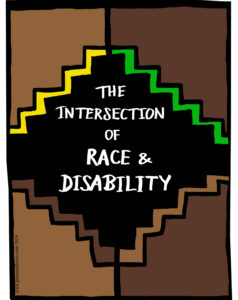
The primary concern for Black/Global Majority Disabled Children and their families is often reduced to disability only. The systemic and structural systems of discrimination (actively) ignore their racial and disability identities and neglect their other characteristics. It was evident that Black/Global Majority Disabled pupils and their families are not provided with disability justice or culturally sensitive support. The education system has poor practice on centring an intersectional approach to the curriculum and workforce, leaving many Black/Global Majority Disabled pupils without recognition and positive representation, which could help improve confidence and overall well-being.
The report recommends changes by the social justice movement, advocacy services, policy and decision-makers. These changes must ensure our campaigns embrace the global Disabled People’s Movement mantra of “Nothing About Us Without Us”.
2. Grouping and separation
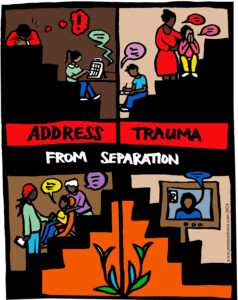 Trauma experienced through grouping and separation based on race and impairment often goes unaddressed. While some mainstream school settings have adopted this practice as acceptable, and there is an expansion across the London boroughs, there is an urgent need to address its effect on student emotions and well-being. This practice is reinforcing further social stigma towards Disabled people and internalised oppression.
Trauma experienced through grouping and separation based on race and impairment often goes unaddressed. While some mainstream school settings have adopted this practice as acceptable, and there is an expansion across the London boroughs, there is an urgent need to address its effect on student emotions and well-being. This practice is reinforcing further social stigma towards Disabled people and internalised oppression.
Response: Advocacy groups working in schools and on education issues should be encouraged to address the effects and trauma caused by segregation on all pupils.
3. Choice and Control
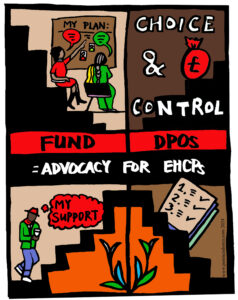 Too many Disabled pupils are denied choice and control over their support. Disabled pupils in school should have a right to have a say over who supports them and when. There are further concerns around pooling support with other pupils, directly impacting the Disabled pupil. It was evident that this creates barriers to getting the proper support. There is a lack of advocacy support for children and families, with very few services offered by DPOs. It is worth noting that Kingston Centre for Independent Living is one of the very few London DPOs that offer an advocacy service on EHCP.
Too many Disabled pupils are denied choice and control over their support. Disabled pupils in school should have a right to have a say over who supports them and when. There are further concerns around pooling support with other pupils, directly impacting the Disabled pupil. It was evident that this creates barriers to getting the proper support. There is a lack of advocacy support for children and families, with very few services offered by DPOs. It is worth noting that Kingston Centre for Independent Living is one of the very few London DPOs that offer an advocacy service on EHCP.
Response: Local DPOs must be funded to provide advocacy support for children and families with EHCPs and their implementations to ensure it centres principles of Independent Living. This also involves developing frameworks for intersectional advocacy that stop creating hierarchies of identity to get support. This could also include working more closely with children and young people’s services.
4. Attitude and representation
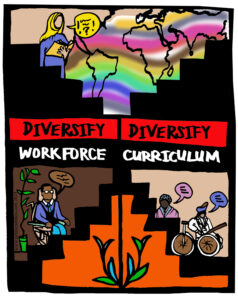 The lack of representation in the workforce and the school curriculum perpetuates negative attitudes and ignorance.
The lack of representation in the workforce and the school curriculum perpetuates negative attitudes and ignorance.
Response: There is a long overdue need to diversify the teaching workforce to broaden and enrich the school curriculum. There must be a commitment to recognition for the diversification of the school curriculum that embraces both Black and Disability history. Schools should be incentivised to enable their pupils to learn about intersections of racial and disability justice. This should involve actively working with DPOs and racial justice movements. Pupils from diverse backgrounds and identities must be seen and heard in their lessons and curricula.
5. Disciplinary procedures and surveillance
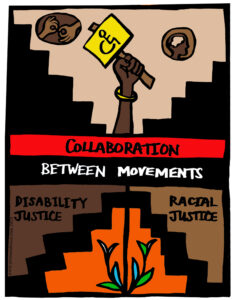 The widespread use of disciplinary procedures and surveillance, which Disabled pupils and Black pupils disproportionately experience, has led to the use of restraints, being placed in seclusion, being subjected to school exclusion, being placed in alternative provision, special schools or Pupil Referral Units. There are significant numbers of Disabled pupils out of school, not accessing learning and being denied their human right to education.
The widespread use of disciplinary procedures and surveillance, which Disabled pupils and Black pupils disproportionately experience, has led to the use of restraints, being placed in seclusion, being subjected to school exclusion, being placed in alternative provision, special schools or Pupil Referral Units. There are significant numbers of Disabled pupils out of school, not accessing learning and being denied their human right to education.
Response: There is a need for collaborative working between DPOs and racial justice movements to strengthen campaigns to end disciplinary procedures and acts of surveillance that lead to exclusion and discrimination. Often, such discriminatory systemic procedures have been passed off as behavioural management strategies to control young people.
6. Social Participation
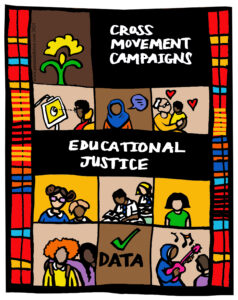 There continues to be a stigma about disability and the denial to include Disabled pupils in mainstream schools. There is resistance by many schools, particularly those rated as ‘outstanding’ because they are less likely to enrol Disabled pupils and children from under-resourced families, which disproportionately impacts Black/Global Majority communities. Many other issues affect pupils’ social participation around the level of support, attitude of support staff, grouping of pupils and removing pupils from some classes. This practice impacts inclusive school development and does not ensure full social participation, social acceptance, and the building of friendships amongst peers. There continue to be acts and practices of social avoidance, bullying and teasing behaviour against young disabled people because this is often perpetuated by a lack of understanding, ill-informed teacher education, and a reluctance for a diverse student intake. Having positive social participation within the life of a school and with the other agencies connected to supporting the pupils is critical to making inclusive education work. It is also necessary to influence positive social, educational, and learning experiences beyond the school’s life.
There continues to be a stigma about disability and the denial to include Disabled pupils in mainstream schools. There is resistance by many schools, particularly those rated as ‘outstanding’ because they are less likely to enrol Disabled pupils and children from under-resourced families, which disproportionately impacts Black/Global Majority communities. Many other issues affect pupils’ social participation around the level of support, attitude of support staff, grouping of pupils and removing pupils from some classes. This practice impacts inclusive school development and does not ensure full social participation, social acceptance, and the building of friendships amongst peers. There continue to be acts and practices of social avoidance, bullying and teasing behaviour against young disabled people because this is often perpetuated by a lack of understanding, ill-informed teacher education, and a reluctance for a diverse student intake. Having positive social participation within the life of a school and with the other agencies connected to supporting the pupils is critical to making inclusive education work. It is also necessary to influence positive social, educational, and learning experiences beyond the school’s life.
Response: Cross-movement campaigns to end school intake discriminatory practice, which is disproportionately affecting Disabled pupils and young people, and in particular Black children and young people from under-resourced communities. Campaigns focused on linking full social participation to educational justice and ensuring the inclusion of all Disabled pupils in mainstream settings to promote the importance of nurturing a sense of belonging, friendship, and valuing others. Further research data is needed to enhance our understanding and contribute to developing practical solutions and practices to realise inclusive education.
References
- Adams, L., Tindle, A., Basran, S., Dobbie, S., Thomson, D., Robinson, D. and Shepherd, C. (2017). Experiences of education, health and care plans: a survey of parents and young people. London: DfE.
- Anaby, D., Hand, C., Bradley, L., DiRezze, B., Forhan, M., DiGiacomo, A. and Law, M. (2013). ‘The effect of the environment on participation of children and youth with disabilities: a scoping review’. Disability and Rehabilitation, 35(19), pp.1589–1598.
- Avramidis, E. (2013). ‘Self-concept, social position and social participation of pupils with SEN in mainstream primary schools’. Research Papers in Education, 28(4), pp.421–442.
- Avramidis, E. and Norwich, B. (2002) ‘Teachers’ attitudes towards integration/inclusion: a review of the literature’. European Journal of Special Needs Education, 17(2). pp.129-147.
- Bagley, C., Woods, P.A. and Woods, G. (2001). ‘Implementation of School Choice Policy: Interpretation and response by parents of students with special educational needs’. British Educational Research Journal, 27(3), pp.287–311.
- Bajwa-Patel, M. and Devecchi, C. (2014). ‘‘Nowhere that fits’: the dilemmas of school choice for parents of children with Statements of special educational needs (SEN) in England’. Support for Learning, 29(2), pp.117–135.
- Baker, K. and Donelly, M. (2001). ‘The Social Experiences of Children with Disability and the Influence of Environment: A framework for intervention’. Disability & Society, 16(1), pp.71–85.
- Batorowicz, B., Campbell, F., von Tetzchner, S., King, G. and Missiuna, C. (2014). ‘Social Participation of School-aged Children Who Use Communication Aids: The Views of Children and Parents’. Augmentative and Alternative Communication, 30(3), pp.237–251.
- Batty, D., Parveen, N. and Thomas, T. (2021). ‘Hundreds of schools in England sign up for anti-racist curriculum’. The Guardian. 26 Mar. [Available at:] https://www.theguardian.com/education/2021/mar/26/schools-england-anti-racist-curriculum.
- Beckett, A.E. (2009). ‘‘Challenging disabling attitudes, building an inclusive society’: considering the role of education in encouraging non‐disabled children to develop positive attitudes towards disabled people’. British Journal of Sociology of Education, 30(3), pp.317–329.
- Berger, P. and Luckmann, T. (1991). The Social Construction of Reality: a treatise in the sociology of knowledge. London: Penguin Books.
- Blatchford, P. and Webster, R. (2018). ‘Classroom contexts for learning at primary and secondary school: class size, groupings, interactions and special educational needs’. British Educational Research Journal, 44(4), pp.681–703.
- Bloor, M., Frankland, J., Thomas, M. and Robson, K. (2001). Focus Groups in Social Research, London: Sage.
- Borsay, A. (2005). Disability and Social Policy in Britain since 1750: a history of exclusion, Basingstoke: Palgrave Macmillan.
- Burr, V. (1995). An Introduction to social constructionism, London: Routledge.
- Carter, E.W. and Hughes, C. (2005). ‘Increasing social Interaction among adolescents with intellectual disabilities and their general education peers: effective interventions’. Research and Practice for Persons with Severe Disabilities, 30(4), pp.179 – 193.
- Center, Y. and Ward, J. (1987). ‘Teachers’ Attitudes Towards the Integration of Disabled Children into Regular Schools’. The Exceptional Child, 34(1), pp.41–56.
- Coard, B. (1971). How the West Indian child is made educationally subnormal in the British school system: the scandal of the black child in schools in Britain. London: New Beacon for The Caribbean Education And Community Workers’ Association.
- Cochrane, H. and Soni, A. (2020). ‘Education, health and care plans: What do we know so far?’ Support for Learning, 35(3), pp.372–388.
- Council for Disabled Children (2023). What is an Education Health and Care Plan? Council for Disabled Children. [Available at:] https://councilfordisabledchildren.org.uk/about-us-0/networks/information-advice-and-support-programme/useful-resources-publications/what-2.
- Department for Education and Coutinho, C. (2023). More support for children with special educational needs. Gov.uk. [Available at:] https://www.gov.uk/government/news/more-support-for-children-with-special-educational-needs.
- Department for Education. (2019). Timpson Review of School Exclusion. London: DfE.
- Dodd, V. (2023) ‘Black children 11 times more likely to be strip-searched in England and Wales than white peers’, The Guardian, 26 March. [Available:] https://www.theguardian.com/uk-news/2023/mar/26/race-disparity-police-strip-searches-of-children-england-and-wales
- Dolmage, J. (2017). Academic ableism: disability and higher education. Ann Arbor: University Of Michigan Press.
- Edwards, B.M., Cameron, D., King, G. and McPherson, A.C. (2019). ‘How Students without Special Needs Perceive Social Inclusion of Children with Physical Impairments in Mainstream Schools: A Scoping Review’. International Journal of Disability, Development and Education, 66(3), pp.298–324.
- Equality and Human Rights Commission (2021). Restraint in schools inquiry: using meaningful data to protect children’s rights. Manchester: Equality and Human Rights Commission. [Available at:] https://www.equalityhumanrights.com/sites/default/files/inquiry-restraint-in-schools-report.pdf.
- Freer, J.R.R. (2023). ‘Students’ attitudes toward disability: a systematic literature review (2012–2019)’. International Journal of Inclusive Education, 27(5), pp.652 – 670.
- Gerschel, L. (2005). ‘The special educational needs coordinator’s role in managing teaching assistants: the Greenwich perspective’. Support for Learning. 20(2), pp.69 – 76.
- Gillborn, D., Rollock, N., Warmington, P. and Demack, S. (2016). Race, Racism and Education: inequality, resilience and reform in policy & practice. Birmingham: University of Birmingham. [Available at:] https://soc-for-ed-studies.org.uk/wp-content/uploads/2019/02/GillbornD-et-al_Race-Racism-and-Education.pdf.
- Greenbaum, T.L. (1998). The Handbook for Focus Group Research, (2nd edition). London: Sage Publications.
- Haines, S. and Ruebain, D. (Eds.) (2011). Education, disability and social policy, Bristol: The Policy Press.
- Hall, R., Ansley, L., Connolly, P., Loonat, S., Patel, K. and Whitham, B. (2021). ‘Struggling for the anti-racist university: learning from an institution-wide response to curriculum decolonisation’. Teaching in Higher Education, 26(7-8), pp.902–919.
- Heiman, T. (2000). ‘Friendship quality among children in three educational settings’. Journal of Intellectual & Developmental Disability, 25(1), pp.1–12.
- Hillman, A. (2021). ‘Exclusive: Black And Asian Pupils Three Times Less Likely To Have Teachers Who Look Like Them’. Huffpost. 12 Mar. [Available at:] https://www.huffingtonpost.co.uk/entry/black-asian-teachers-england-state-schools-representation_uk_604a137ac5b672fce4eae9f8.
- HMSO. (2023). Special educational needs and disabilities (SEN/D) and alternative provision (AP) improvement plan, right support, right place, right time. (March 2023), London: HMSO.
- Hodgkiss, B. and Harding, E. (2023). ‘Reducing physical restraint in educational settings: a systematic literature review’. Journal of Research in Special Educational Needs, 23, pp.265–277.
- Home Office (2022). Police powers and procedures: Other PACE powers, England and Wales, year ending 31 March 2022. [online] London: GOV.UK. [Available at:] https://www.gov.uk/government/statistics/police-powers-and-procedures-other-pace-powers-england-and-wales-year-ending-31-march-2022/police-powers-and-procedures-other-pace-powers-england-and-wales-year-ending-31-march-2022.
- Home Office. (2023). Prevent Duty Guidance: England and Wales. HM Government.
- Humphries, S. and Gordon, P. (1992). Out of Sight: The experience of disability 1900-1950, Plymouth: Northcote House.
- Hunter, J., Runswick‐Cole, K., Goodley, D. and Lawthom, R. (2019). ‘Plans That work: Improving Employment Outcomes for Young People with Learning Disabilities’. British Journal of Special Education, 47(2).
- Joseph-Salisbury, R. (2020). Race and Racism in English Secondary Schools. [online] London: Runnymede. [Available at:] https://assets.website-files.com/61488f992b58e687f1108c7c/61bcc0cc2a023368396c03d4_Runnymede%20Secondary%20Schools%20report%20FINAL.pdf.
- Kikabhai, N. (2014). ‘‘Resistance: which way the future?’ A dual-screen installation related to the theme of disability and eugenics’. Disability and Society, 29(1), pp.143 – 158.
- Kikabhai, N. (2018). The Rhetoric of Widening Participation in Higher Education and its Impact: Ending the Barriers Against Disabled People. Cham: Springer International Publishing.
- Kikabhai, N. (2022). ‘How educational systems respond to diversity, inclusion and social justice: disability, power, discipline, territoriality and deterritorialization’. The British Journal of Sociology, 73(8), pp.685 – 698.
- Klein, G. (1993). Education towards race equality, London: Cassell.
- Ktenidis, A. (2023). ‘Stories of Surveillance and Resistance: Young people with dwarfism and teaching assistants in secondary schools in the United Kingdom’. Journal of Disability Studies in Education, pp.1 – 24.
- Leckie, G. and Goldstein, H. (2018). Should we adjust for pupil background in school value-added models? A study of Progress 8 and school accountability in England. Bristol: University of Bristol School of Education. [Available at:] https://www.bristol.ac.uk/media-library/sites/education/documents/FINAL.pdf.
- Lidher, S., Alexander, C., and Bibi, R. (2023). Making History Teachers: The role of teacher training and teacher education. Runnymede Trust and University of Manchester’s Centre on the Dynamics of Ethnicity (CoDE). [Available at:] https://pure.manchester.ac.uk/ws/portalfiles/portal/261547564/Runnymede_CoDE_Briefing_Teacher_Training_FINAL.pdf.
- Mawene, D. and Bal, A. (2018). ‘Factors Influencing Parents’ Selection of Schools for Children with Disabilities: A Systematic Review of the Literature’. International Journal of Special Education, 33(2), pp.313–329.
- Naraian, S. and Schlessinger, S. (2017). ‘When theory meets the “reality of reality”: reviewing the sufficiency of the social model of disability as a foundation’. Teacher Education Quarterly, 44(1), pp.81 – 100.
- Office for Statistics Regulation (2023). School workforce in England. London: GOV.UK. [Available at:] https://explore-education-statistics.service.gov.uk/find-statistics/school-workforce-in-england.
- Oliver, M. (2004). ‘The Social Model in Action: if I had a hammer’. In: C. Barnes and G. Mercer, (Eds). Implementing the Social Model of Disability: Theory and Research. Leeds: The Disability Press, pp.18–31.
- Oliver, M. (2009). Understanding disability: from theory to practice (2nd edition), Basingstoke, Palgrave Macmillan.
- Pattinson, S. and Kikabhai, N. (forthcoming). ‘Mad Studies, Inclusive Education and Higher Education Participation – Critiquing Fitness to Teach’. forthcoming.
- Petitions Committee (2021). Online engagement on Black history and cultural diversity in the curriculum. London: House of Commons. [Available at:] https://committees.parliament.uk/writtenevidence/23085/default/.
- Petry, K. (2018). ‘The relationship between class attitudes towards peers with a disability and peer acceptance, friendships and peer interactions of students with a disability in regular secondary schools’. European Journal of Special Needs Education, 33(2), pp.254–268.
- Rix, J. and Sheehy, K. (2014). ’Nothing special: the everyday pedagogy of teaching’, in Florian, L. (ed.). The Sage Handbook of Special Education (2nd edition), London: Sage. pp.459 – 474.
- Runnymede (2023). Over-policed and under-protected: the road to safer schools. [online] London: Runnymede. [Available at:] https://assets-global.website-files.com/61488f992b58e687f1108c7c/63c027251c4ddb3581daa9fb_Safer%20Schools%20Officers%20Briefing%20-%20FINAL.pdf.
- Runswick-Cole, K. (2008). ‘Between a rock and a hard place: parent’s attitudes to the inclusion of children with SEN in mainstream and special schools’. British Journal of Special Education, 35(3), pp.173 – 180.
- Satherley, D. and Norwich, B. (2021). ‘Parents’ experiences of choosing a special school for their children’. European Journal of Special Needs Education, 37(6), pp.1–15.
- Shah, S. (2007). Special or mainstream? The views of disabled students. Research Papers in Education, 22(4), pp.425–442.
- Skiba, R., Simmons, A., Ritter, S., Gibb, A., Rausch, M., Cuadrado, J. and Chung, C.G. (2008). ‘Achieving equity in special education: history, status and current challenges’. Exceptional Children, 74(3), pp.264-288.
- Soorenian, A. (2020). Accessibility plans as effective tools for inclusion in schools: are they working? [online] The Alliance for Inclusive Education. [Available at:] https://www.allfie.org.uk/wp-content/uploads/2020/02/AccessibityPlans-Report.pdf.
- The Challenging Behaviour Foundation. (2019). Reducing Restrictive Intervention of Children and Young People. [online] Chatham: The Challenging Behaviour Foundation. [Available at:] https://www.challengingbehaviour.org.uk/wp-content/uploads/2021/03/reducingrestrictiveinterventionofchildrenandyoungpeoplereport.pdf.
- Tomlinson, S. (2004). Race and education, in Ware, L. (ed.). Ideology and the politics of (in)exclusion, New York: Peter Lang. pp.76 – 88.
- United Nations. (2006). Convention on the Rights of Persons with Disabilities. Treaty Series, 2515, 3.
- UK GOV. (2023). Special Educational Needs in England (Academic year 2022/23). [Available at:] https://explore-education-statistics.service.gov.uk/find-statistics/special-educational-needs-in-england.
- Wallace, D. and Joseph-Salisbury, R. (2021). ‘How, still, is the black Caribbean child made educationally subnormal in the English school system?’ Ethnic and Racial Studies, 45(8, 1-27).
- Whitburn, B. (2013). ‘The Dissection of paraprofessional support in inclusive education: ‘You’re in mainstream with a Chaperone’. Australasian Journal of Special Education. 37(2), pp.147 – 161.
- Woodgate, R.L., Gonzalez, M., Demczuk, L., Snow, W.M., Barriage, S. and Kirk, S. (2019). ‘How do peers promote social inclusion of children with disabilities? A mixed-methods systematic review’. Disability and Rehabilitation, 42(18), pp.1–27.
- Worth, N. (2013). ‘Making friends and fitting in: a social-relational understanding of disability at school’. Social & Cultural Geography, 14(1), pp.103–123.
- Zempi, I. and Tripli, A. (2022). ‘Listening to muslim students’ voices on the prevent duty in British universities: a qualitative study’. Education, Citizenship and Social Justice, 18(2), pp.230–245.
Copyright Alliance for Inclusive Education (ALLFIE) 2024
Inclusion Champions Project report
‘Inclusive Education, Disabled People’s Organisations and Capacity Building for Change’. This report provides some reflections from an Inclusion Champions Project funded by the City Bridge Trust.
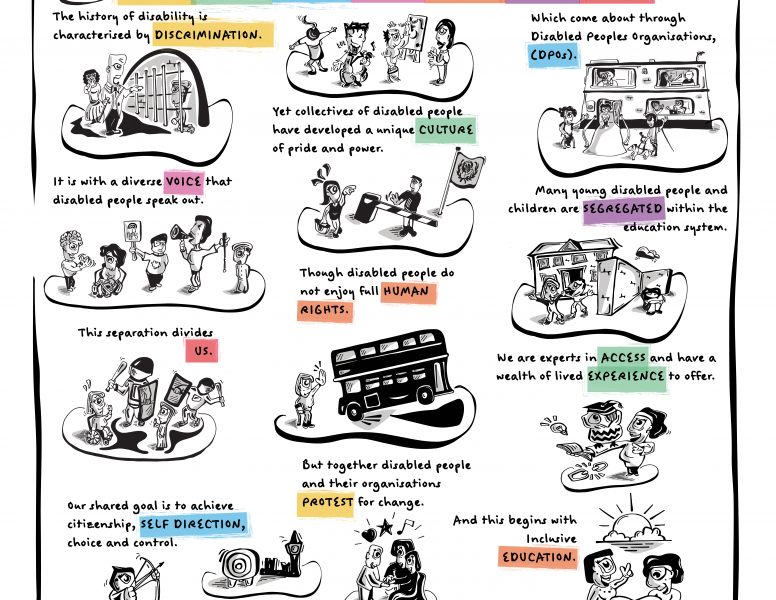
Inclusive Education, Disabled People’s Organisations and Capacity Building for Change.
Download the (pdf) Inclusion Champions Project report
Overview
This report provides some reflections from an Inclusion Champions project funded by the City Bridge Trust. This supported ALLFIE to successfully host the Inclusion Champions Network (ICN) made up of 18 London-based Disabled People’s Organisations (DPOs), working with young people and their families, Local Authorities and other young people’s services.
The focus was to facilitate work around inclusive education and to capacity build DPOs to better engage with young Disabled people. Based on our work, this document will offer here some suggestions to other DPOs considering shared capacity building and campaign work that is about inclusive education and involvement of young Disabled people as assets. This includes both a structure for planning social change activities, along with links to learning resources produced as part of this project. At the end of this document, we also note some ideas for future work that we feel will help us work together with DPOs and young Disabled people to achieve inclusive education.
Contents:
- Introduction
- Disabled People’s Organisations
- Inclusive Education
- Capacity building and building capacity for change
- Recommendations
- Summary
Introduction
Disabled People’s Organisations (DPOs) are unique collectives that provide both peer support services and collective action. We demonstrate solidarity in our drive for inclusion, and connect communities to bring together different experiences and individuals within the Disabled People’s Movement. They represent, both at the same time, a social change movement and a vibrant community sector. While in recent years some progress has been made in inclusive education, there is still a way to go.
Inclusive education is a human right, as set out in Article 24 of the UN Convention on the Rights of Persons with Disabilities (UNCRPD). Being included in society is the key to Disabled people being embraced as equal citizens. Non-Disabled people need to grow up, to learn, play and work with Disabled people as friends, classmates and family members. Though Disabled young people and children have some protections and rights to inclusive education, these do not currently work as they should.
The Alliance for Inclusive Education (ALLFIE) want Disabled People’s Organisations to be part of the campaign for the right of all Disabled people to be fully included in mainstream education, not segregated from our peers, our friends, our families, our communities. ALLFIE’s vision is a fully inclusive education system that welcomes all, with the ultimate goal of ending all forms of segregated education for Disabled pupils and students. ALLFIE believes that DPOs can play an important role in achieving inclusive education by increasing involvement with young Disabled people and children in the movement.
Based on the learning and reflections of the City Bridge Trust project this document presents some information about Disabled People’s Organisations, inclusive education and capacity building for change. This includes an approach to planning and organising for change, as well as a number of links to materials produced as part of this project. It sets out how to involve the right people, how to plan actions and campaigns, and links to wider issues by recognising the intersect of ableism, racism, sexism and classism. A number of ideas for future work are also recommended.
Disabled People’s Organisations (DPOs)
Disabled People’s Organisations (DPOs) are run and controlled by Disabled people, focused on equality and human rights. They work to support Disabled people to achieve inclusion.
A DPO can be defined as an organisation whose constitution requires it to have a membership and managing board with a majority of Disabled people. Its objectives will be the rights and equality of Disabled people. DPOs subscribe to the Social Model of Disability and are committed to the human rights of Disabled people. DPOs work for the empowerment of Disabled people either implicitly or explicitly.
DPOs, have grown and developed since the 1970s. They are unique social change organisations focused on issues relevant to Disabled people through the use of a range of activities. In the 1980s the first UK Centres for Independent Living (CILs) were established in Hampshire, Derbyshire and Greenwich. Run and controlled by Disabled people, CILs are based on a number of principles that if available to Disabled people enable self-determination and personal autonomy, so as to be able to participate equally.
These include, having access to accessible information, advocacy, adequate housing, PA support, equipment, transport etc. The key point is that unless Disabled people are involved in decisions and policies about their lives, nothing changes.
The UK has an ever-increasing number of voluntary sector organisations, ranging from small community groups to international charities with bases in many countries. DPOs represent an important movement within this sector. The impact of DPOs has been huge, furthering a radical social policy agenda and redefining meanings of social care, health, independent living and inclusion.
The added value of DPOs comes through the leadership that emerges from Disabled people coming together, sharing experiences and developing practices of inclusion. This facilitates a unique organisational culture that embraces and values the voices and experiences of Disabled people from the perspective of equality and dignity, rather than that of personal and medical tragedy.
For a recent view on DPOs see the report ‘Understanding the needs of DDPOs in England’. This provides information from 100+ DPOs about current issues and what is needed to strengthen the capacity to tackle the deepening structural inequalities faced by Disabled people in a post Covid world.
Inclusive Education
The right to inclusive education is set out in Article 24 of the UN Convention on the Rights of Persons with Disabilities and Sustainable Development Goals, Target 4. The inclusion of young Disabled people and children is key to them being embraced as equal citizens as they become adults. There are a number of concerns about UK education and equality legislation not following the rules on the international agendas, and how segregated education occurs in practice today.
ALFFIE’s current campaigning work is focused on the government’s anti-inclusive education reforms, which are proving to be disastrous and harmful for Disabled pupils’ and students’ right to inclusive education in mainstream education settings. Local authorities are taking funds from mainstream schools to promote, create and pay for expensive segregated education placements, reducing the capacity of mainstream schools to welcome a wide range of pupils and students from different backgrounds.
An increasing focus on academic attainment in public exams through league performance tables, puts considerable pressure on schools, colleges, and universities to standardise learning and assessment practice. For Disabled people with diverse learning styles, the accessibility of education settings is a concern, as there is now greater segregation and exclusion of Disabled pupils and students from mainstream education.
The Alliance for Inclusive Education (ALLFIE) is keen to support Disabled People’s Organisations to be part of the campaign for the right of all Disabled people to be fully included in mainstream educational settings and learning. It supports educational and learning settings that do not segregate us from our peers, our friends, our families and our communities. DPOs in local communities are well placed to support young Disabled people and children.
Capacity building and building capacity for change
Capacity building and building capacity for change are development activities, sets of resources, or forms of assistance provided to organisations in order to help them improve their effectiveness and boost performance. This usually focuses on management, leadership and governance, and organisational systems, but equally can be about developing campaigns, setting goals and working to achieve those, as we have seen in the #MeToo and Extinction Rebellion movements. Based on our work on the Inclusion Champions Project, below we set out some ideas about how we think DPOs can engage with young Disabled people on the issue of inclusive education. The ICN involved exploring how to involve the right people, planning for action, connecting to wider networks, creating resources and ideas, and being influencers for change.
Involving the right people –
It is important to remember also that it is people that make change happen. To organise and bring about the change you want it is useful to involve different types of insights and experiences. This includes centring people with lived experience of intersectionality, people with ideas, and people with power and influence. Sometimes you may find people hold these experiences and insights at the same time, sometimes only one or two. Additionally, people may not be able to be open with their experiences or may not recognise how valid their expertise is.
The following illustrates how this might be applied to the campaign for Inclusive Education.
- Lived experience – Disabled young people and children who are (or have) experienced segregation in school or college. This might be as a result of being placed in a special school, or being excluded as a result of not being able to attend some lessons within mainstream education. It may also be to do with not being able to access learning materials or socialise with peers because of a lack of accessibility in the learning activity or environment.
- Ideas for change – Disabled people, supporters or allies with knowledge about the social model, intersectionality, human rights and specifically Article 24 of the UNCRPD. Applying these ideas, in an accessible and meaningful way and facilitating those with lived experiences to imagine alternatives.
- Power and influence – Those in influential or decision-making roles who can help to realise and make alternatives happen. This might be those who can articulate the need for change, persuading others of the unquestionable rationale and moral argument. Or it can be those who have decision making powers and who can allocate resources, change structures and reorganise policy and practice.
Planning for action
Understanding what the problem is, being clear about how and why it can be different and knowing what needs to be done in order for it to happen, is key to achieving change. The following maps out some steps, poses some key questions, and gives some useful links for DPOs to consider when planning and organising actions about inclusive education.
- Principles – Building an understanding, by centring the lived experience of segregated education and the arguments against it, is crucial in developing campaigns that look to change it.
What is the impact on people? What harm does it do? Why is it wrong?
Here is a guide to the UNCRPD
Here is an introduction to the Social Model of Disability in the context of inclusive education
- Preparation – With a clear idea about what’s wrong, and why it should be different, change and aspects of it can be imagined and articulated. This does not need to be in detail, rather it can be a shared description of the destination. Change can be both big and small, local and global, for an individual or a wider group. It can be about access in a school, access getting to a school or the standardised delivery and assessment of learning.
What is wrong? What needs to change? How can it be different?
Here is an overview of inclusive education and an account of how inclusion can be achieved in a school
- Action – Identifying how change could be made and framing the message clearly for your audience is important. Knowing what drives and motivates them, and using this to plan an action, can help it be successful. Campaigning actions can be brief or lengthy, they can be a posted letter that spells out what you want, a petition of many, or a demo with placards in the street.
What are we asking for? What exactly do we want? Who needs to hear what we are saying? How do we make them act?
See here for the ‘Educate Don’t Segregate’ and other campaigns by ALLFIE
- Being local and global – Recognising the intersectionality of Disabled people and how their organisations are connected to wider communities across the globe is important for several reasons. Knowing that you are not alone, that you are part of a community that shares your experiences of barriers and struggle, and that has a passion for an inclusive future brings strength. The connections come from sharing experiences, sharing information and knowledge with local peers about human rights and the resistance that is occurring elsewhere.Being local validates shared experiences of barriers and exclusion. It also helps to build communities for an inclusive world. Using the lens of human rights to recognise how social change is both possible and probable for Disabled people and their organisation can be big motivator in the campaign for inclusive education.Here is some information about the ‘European Convention on Human Rights’ and its relevance to inclusive education
Recommendations.
Based on our work, and the feedback of those we engaged with, we present the following as ideas for future work. This, we believe, will assist DPOs to engage with young Disabled people, to ensure their voice is embedded within their work. In turn this will help further the campaign for inclusive education, and bring an end to the circumstances that continue to exclude many young Disabled people and children from experiencing inclusive education.
- Develop a young Disabled people and children’s network – create regular opportunities to provide updates and learning on human rights, Disabled people’s movement issues and social change. Recognise young people as assets, so that they can develop as leaders and initiate and run successful social change campaigns.
- Create opportunities for DPOs and young Disabled people and children to work together – build attendance at the Inclusion Champions Network of DPOs across England. Support young people and DPOs to develop local activities and action.
- Identify current gaps in peer support and advocacy for young Disabled people and children – review the commissioning activity of these services to explore the current and future roles of DPOs.
- Give space to Disabled young people and children to become leaders – profile current issues about intersectional identities, exploring distinct and shared areas of oppression and opportunity, across race, sex, gender, faith, culture, Disability and other areas. https://youtu.be/95Q5g9-Hj5g
- Connect intergenerationally – create opportunities for dialogue between old and young experiences within the Disabled people movement, exploring previous challenges and successes, as well as developing a future manifesto.
https://www.allfie.org.uk/inclusion-resources/being-seen-being-heard-empower-young-people-in-the-disability-rights-movement/
https://www.allfie.org.uk/news/inclusion-now/inclusion-now-55/alliance-for-inclusive-education-manifesto/
Summary.
This report summarises some key reflections and points of learning from the Inclusion Champions Project funded by the City Bridge Trust. Through this we were able to work with Disabled People’s Organisations (DPOs) and young Disabled people.
This enabled us to better understand some of the issues preventing them from engaging more actively on work about inclusive education. Many DPOs want to work with young people, but often are not able to create the opportunities to do so. ALLFIE’s Inclusion Champions work has shown how this is possible, and what benefits it can offer to social change work in this area.
Based on this work we offer here some suggestions to DPOs when considering capacity building and campaign work that is about inclusive education and looks to involve young Disabled people. These include both structure for planning social change activities and links to learning resources produced as part of this project.
Resources.
Here are some resources created by young people:
- Our Voice
https://www.allfie.org.uk/about-us/who-we-work-with/our-voice-project/ - Online University Empowers Disabled Students
https://www.allfie.org.uk/news/inclusion-now/inclusion-now-58/online-university-empowers-disabled-students/ - 50 years since Handicapped Children Act
https://youtu.be/3c4IAt-PNcA - The CripTales and Inclusive Education
https://www.allfie.org.uk/news/inclusion-now/inclusion-now-58/the-criptales-and-inclusive-education/ - ‘Our Voice’ Project Participants interview Baroness Tanni Grey-Thompson
https://www.allfie.org.uk/inclusion-now-60/our-voice-project-participants-interview%e2%80%afbaroness-tanni-grey-thompson/ - Judy Heumann: ‘The battle is so much bigger than we thought it was’
https://www.allfie.org.uk/inclusion-now-60/judy-heumann-the-battle-is-so-much-bigger-than-we-thought-it-was-unless-all-disabled-people-are-liberated-none-of-us-can-be-liberated/ - Returning to School After Lockdown
https://www.allfie.org.uk/news/inclusion-now/inclusion-now-59/learning-in-lockdown/ - Learning in Lockdown
https://www.allfie.org.uk/news/inclusion-now/inclusion-now-59/learning-in-lockdown/ - ‘Like a bird released from a cage, I am free to fly in the open fields’
https://www.allfie.org.uk/news/inclusion-now/inclusion-now-58/like-a-bird-released-from-a-cage-i-am-free-to-fly-in-the-open-fields/
Covid-19 Inclusive Education guide
ALLFIE has co-produced this guide with parents of Disabled students and Inclusion Champions Network members, to help Disabled students and their families navigate mainstream education during the Covid-19 pandemic.
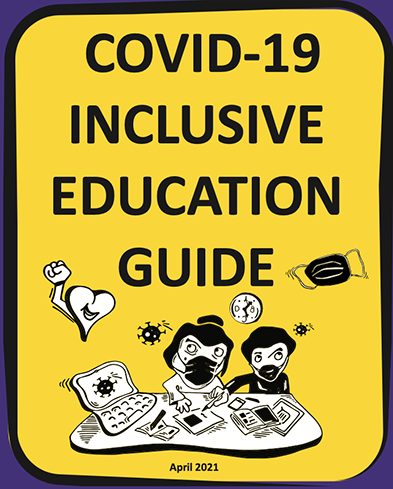
Download full document (pdf): Covid-19 Inclusive Education guide
ALLFIE has co-produced this guide with help from parents of Disabled students and members from our Inclusion Champions Network, to help Disabled students and their families navigate mainstream education during the Covid-19 pandemic and help respond to inquiries. The outbreak has provided us with a rare opportunity to consider what is important in inclusive education.
During lockdown, there has been a need for more contact between parents, schools and colleges. This has provided us with a real opportunity to develop stronger relationships between children, parents and education staff, with positive outcomes. We hope this guide will support the ongoing good relationships between everyone, with the aim of obtaining a greater understanding of Disabled children and young people’s needs and rights.
We have focused on the major Covid-19 issues, highlighted in ALLFIE’s Survey Report: The Impact of Coronavirus on Disabled People’s Education.
Download the Covid-19 Inclusive Education guide.
Contents:
- The Social Model of Disability and inclusive education
- Knowing your rights
- Finding support to exercise your rights
- Making good use of formal assessment procedures
- Returning to school and college
- Blended learning experiences
- Qualification assessments
- Combating social isolation
- Funding sources
Impact of Sexism on Black Disabled Women and Girls
This presentation was originally delivered by Michelle Daley to mark International Women’s Day 2021.
Download full document (pdf): Impact of Sexism on Black Disabled Women and Girls
Discussion points:
- What does Sexism, Disablism, Racism and Intersectionality mean?
- What are the problems Black Disabled Women and Girls in the UK experience?
- What is the Impact of Sexism for Black Disabled Women and Girls?
- What do we need to do to stop intersectional inequality and discrimination?
This resource was first delivered as a presentation by Michelle Daley (ALLFIE Director), to local Labour Party members in Islington, for International Women’s Day March 2021.
Please visit ALLFIE’s Disabled Black Lives Matter (DBLM) pressure group, for more information.
Foreword
“This resource is based on our human rights. We know that the entrance door for many individuals to education and learning is not open, or is layered with complications. It is from this context I will explore the experiences of Black Disabled women and girls, and how different identities determine our treatment, privileges and how we are privileged/disadvantaged within society.
I will begin by presenting some questions for discussion, alongside definitions of key terms, followed by accounts of two important Black Disabled Women in our history and intersectional struggle for equality – Mary Prince and Elizabeth Gertrude Suggs.
Finally, I will discuss the problems for Disabled Black women and girls in the UK today, and what we can do to help eradicate these”
Michelle Daley, Alliance for Inclusive Education (ALLFIE) Director
Download full document (pdf): Impact of Sexism on Black Disabled Women and Girls
Racial and intersectional inequality, and under-representation of people of colour in Disabled People’s Organisations
‘You can’t get rid of one oppression without getting rid of all of them’
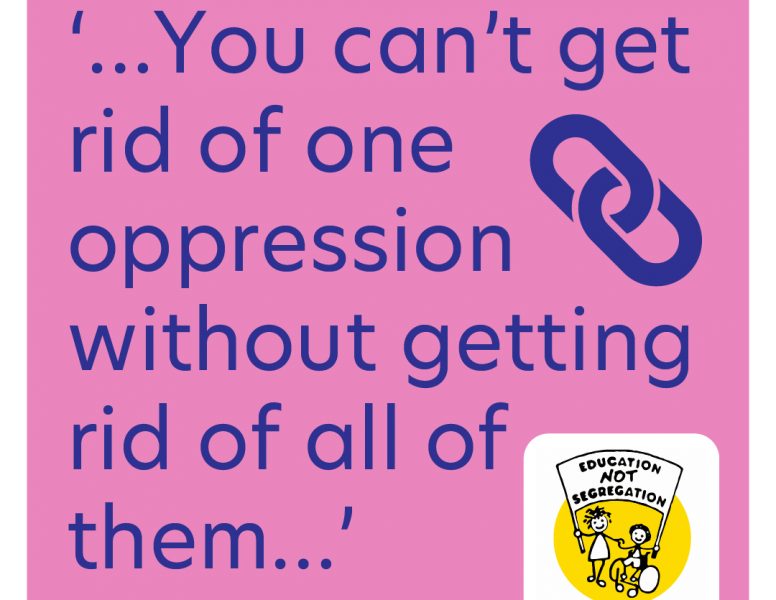
This toolkit includes visual minutes from a series of discussion groups in 2021 by ALLFIE’s Disabled Black Lives Matter pressure group.
Contents
- Key concepts
- Key questions
- Key ideas for change
1. Key concepts
Racism
Oppression, injustice, inequality, abuse, violence against people who share characteristics, because of: skin colour, cultural backgrounds, faith or life style, though definitions are blurry and politically contested.
Disablism
Oppression against disabled people. Disability is often used to indicate a broken, flawed body or mind, though many disabled people assert a social model of disability that identifies social barriers as disabling, not their impairments or medically defined conditions.
Oppression
Discrimination or inequality resulting from different treatment or responses. This can be big and small, fatal and limiting, structural and interactional. Creates exclusion, negative outcomes and prevents individuals and groups from social participation.
White privilege
Having greater access to power and resources than black people in the same situation.
Micro-aggression
Forms of violence and oppression occurring in the everyday towards someone on the basis of their identity or other characteristics. Includes, Micro-assault: explicit discriminatory actions; Microinsult: demeaning a person’s identity, often subtly and unknown by the perpetrator; Micro-invalidation: dismissing the feelings, or experiences of a person belonging to a particular group.
Intersectionality
A way of looking at the combination of a persons’ identities that can result in forms of discrimination that cannot be reduced to single issue understanding. The consequence cannot be understood as not racial injustice plus disability discrimination, but rather oppression multiplied, and as something experienced in isolation.
Kimberlé Crenshaw suggests three types of intersectionality to understand the experience of oppression:
Structural
– society works to combine and interlock oppressions, so that negative consequences are experienced in multiple ways.
Political
– identities are kept separate and maintained as different within politics.
Representational
– imagery that favours single issues, and maintains negative stereotypes.
Interlocking Oppressions
– Histories of oppression interlock and prop each other up. For example, the exploitation of care workers through low pay and the isolation of disabled people are dependent on each other.
2. Key questions.
What are the points of struggle and solidarity?
Power and privilege are gained through the oppression of others. Systems of inequality are interlocked with each other, understanding how these work in context is crucial for resisting them.
How do we understand who is visible and who has the power?
Who is privileged? Who is erased? Whose voice is missing? And how do we enable, share and give power away?
How do we move to achieving social justice for all?
For example, a Black Disabled boy who has an Education, Health and Care plan has a 58% chance of receiving a fixed period exclusion. What does an intersectional approach to making a more inclusive curriculum look like?
3. Key ideas for change
1) Create opportunities for more conversations about race and intersectionality experienced by disabled people to document the specific and represent different experiences of people within the rights movement.
2) Develop practical strategies to tackle the injustices and inequalities arising from the intersectional link of race, gender and other intersectional identities experienced by disabled people
3) Challenge default thinking, combat oppression and microaggression in the everyday life, focusing on inclusion of all people as the goal.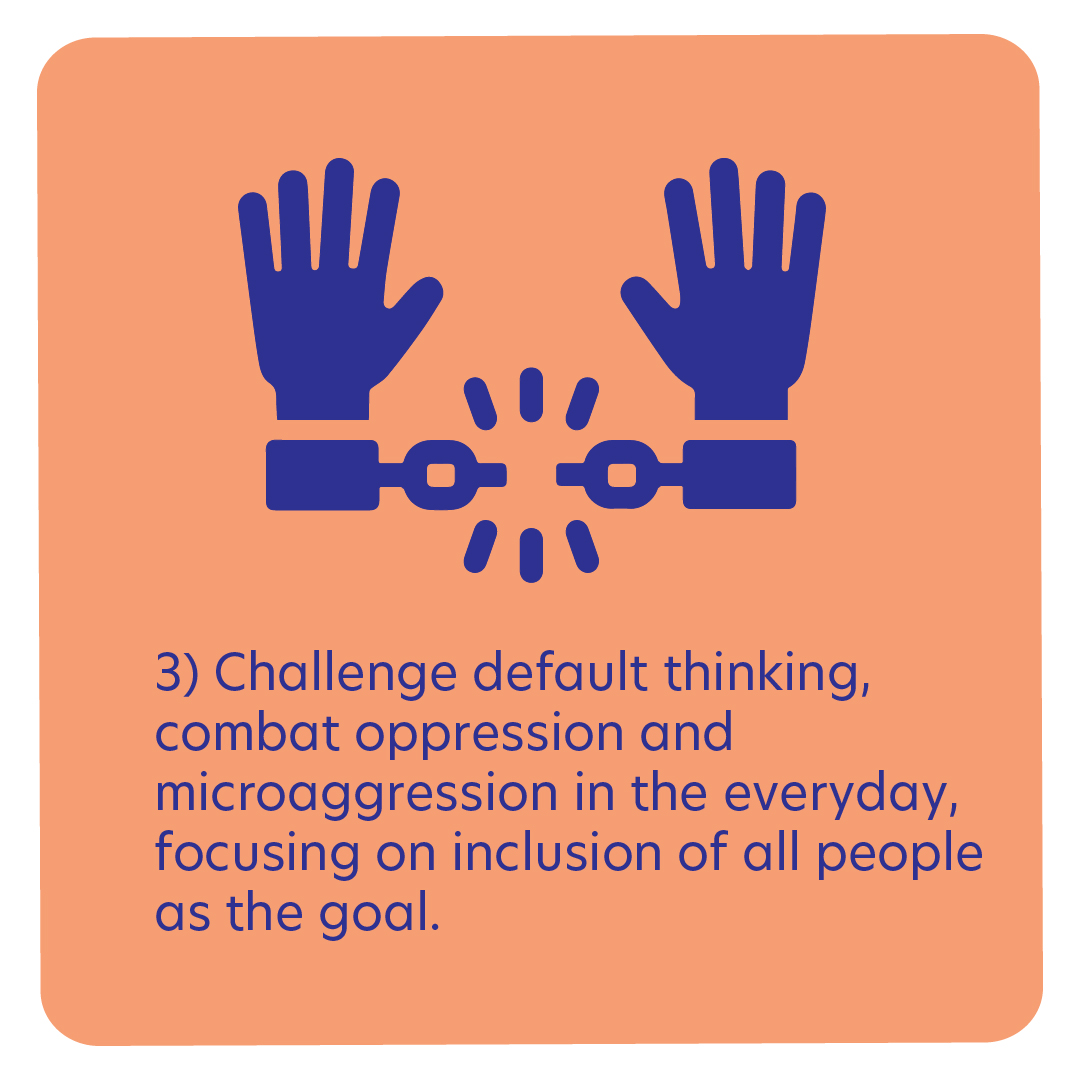
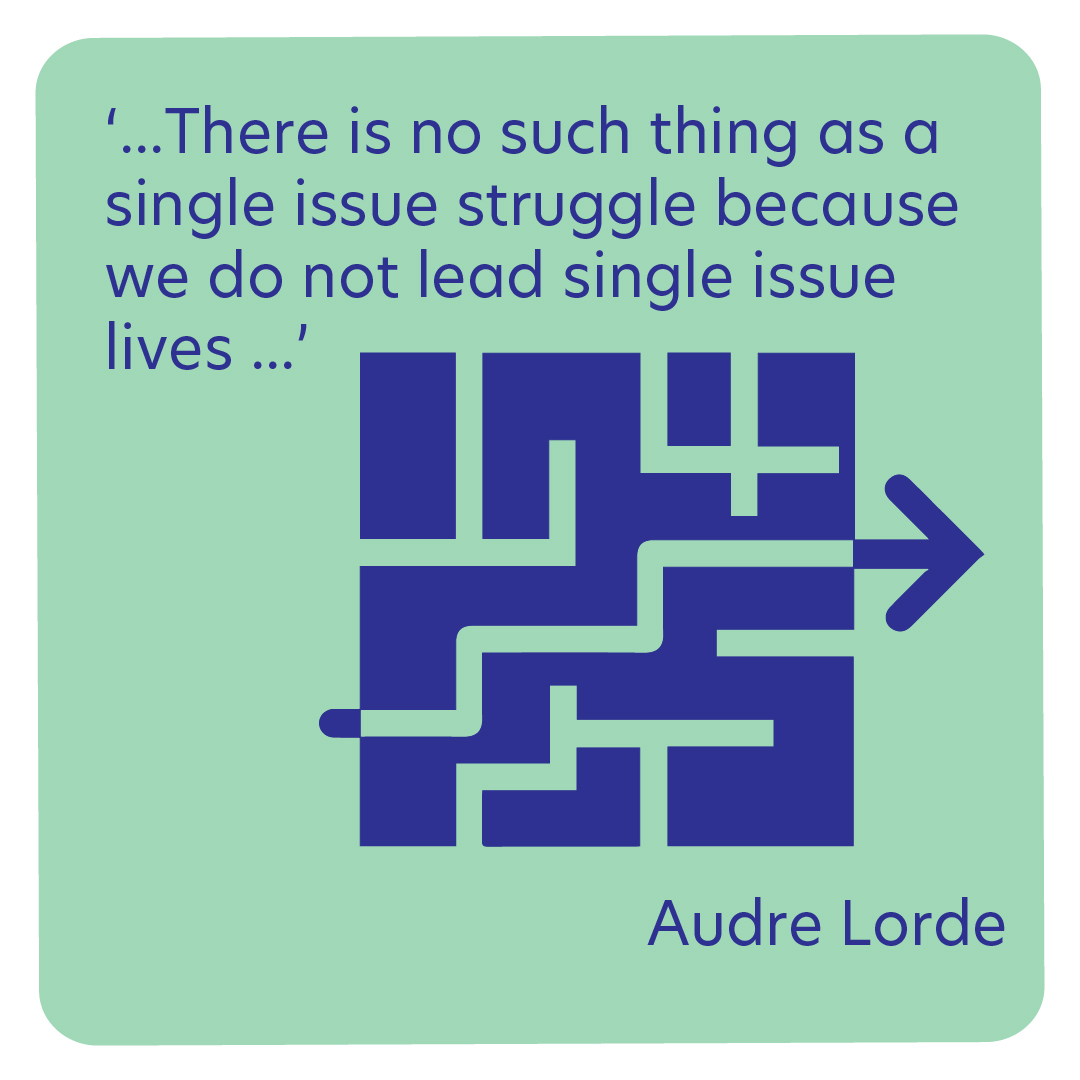
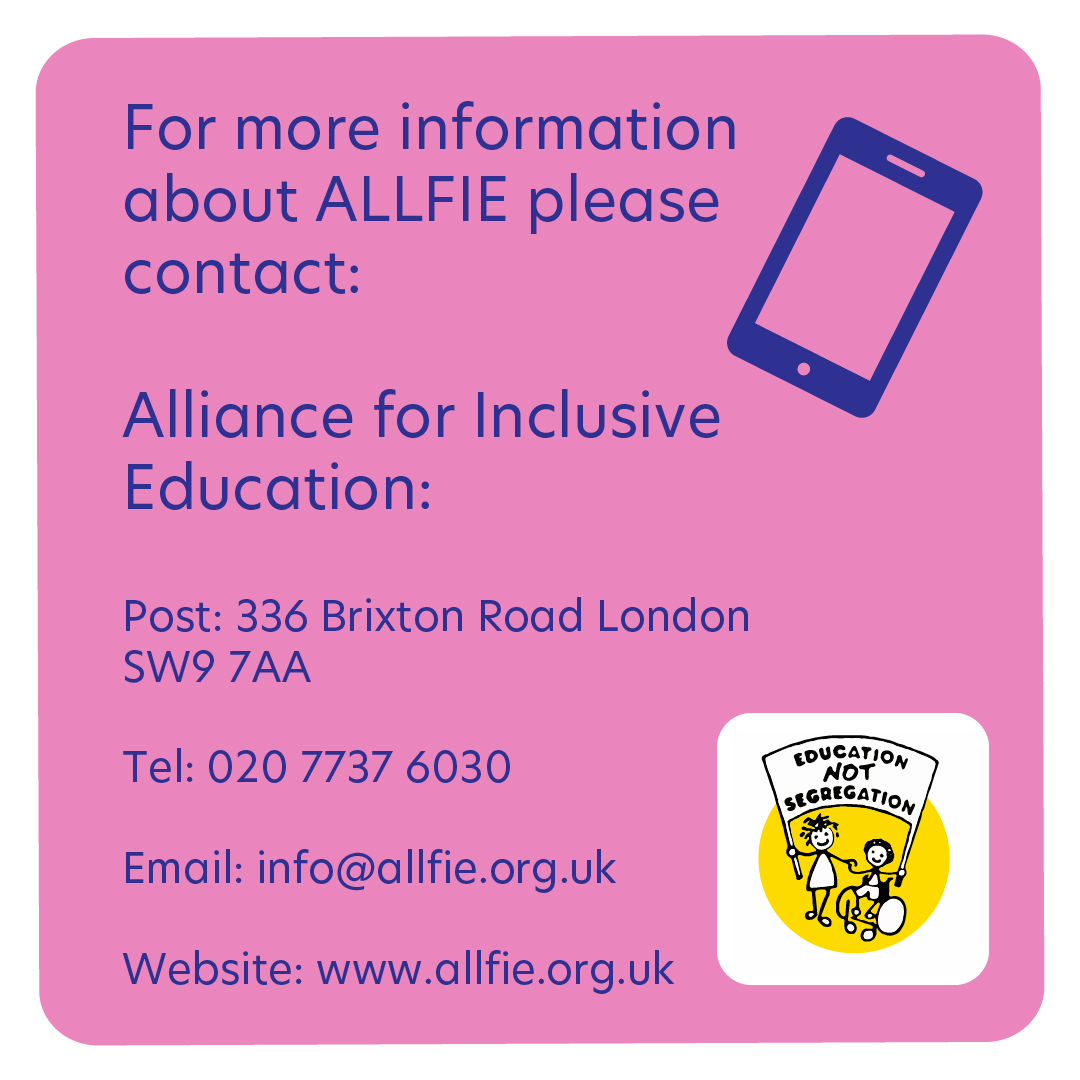
Being Seen, Being Heard: Empower Young People in the Disability Rights Movement
A resource for voice, rights and empowerment of Disabled children and Young people: a guide for activism by the RIPSTARs, co-produced by ALLFIE.
Download full report: ‘Being Seen, Being Heard’ project, April 2021 (pdf)
“This resource is an example of what can be done when generations of Disabled people work together to create change. Together we are stronger.
If you are a Disabled Young person reading this we hope that this resource helps you to see that you are not alone, you are not a ‘problem’ or something to be ‘fixed’ or someone to be ‘excluded’. You have rights, you have a voice and you have allies.” (The RIP:STARS)
Contents
- Foreword
- The Being Seen, Being Heard project
- Discrimination of Disabled people – Why activism is important
- Learning Our History
- Themes:
1 Becoming Aware
2 Building your leadership skills
3 Building a Culture and Making Change
4 Practical steps to bring generations of Disabled people together
Foreword
Hello we are the RIP:STARS, working in partnership with the Alliance for Inclusive Education.
“Being a RIP:STAR has been all about making our voices heard, speaking up, having confidence and becoming empowered as Young Disabled people. If you are a Disabled Young person reading this we hope that this resource helps you to see that you are not alone, you are not a ‘problem’ or something to be ‘fixed’ or someone to be ‘excluded. You have rights, you have a voice and you have allies.“
RIP:STARS stands for Research Into Practice: Skilled Team with Ambition, Rights and Strength. We are all Disabled young people aged 18 to 25 and we are from Coventry, in the West Midlands of England. We started our research group in 2017 because we wanted to try and make a difference to Young people’s lives.
Since then we have tried to change how people view and treat Disabled Young people through our research, training and activism. You can learn about our work on our website
The RIP:STARS work is different because it is research about young disabled people done by young disabled people. We lead everything in our research projects, and we make our own decisions about what we do, and how we do it. We work within the Social Model of Disability and a rights-based approach to challenge any barriers we face as young people, and as disabled young people. We know that we have rights, and that disabled children and young people have to fight for their rights every day.
The RIP:STARS for this project are: Ben, Eva, Jordan and Tom. Learn more about RIP:STARS work
RIP:STARS are supported by:
Anita Franklin (University of Portsmouth) | Geraldine Brady (Nottingham Trent University)
Co-production
ALLFIE (Alliance for Inclusive Education) was set up in 1990, and is an organisation led by Disabled people. ALLFIE campaigns and lobbies for inclusive education within mainstream settings. Over the years ALLFIE has led work to help promote and raise awareness to the wider society about the importance of inclusive education in helping to create inclusive communities.
In this project we partnered with ALLFIE to co-produce this project, it was important to work with a Disabled Peoples organisation because we wanted to learn from Disabled People Led Organisations. We wanted to hear about the history of the Disability Rights Movement. We wanted to learn about how Disabled People have fought for their rights and won rights in some areas but in other areas rights are still denied. We wanted to see if our struggles in education and in life in the year 2020 are the same or different to older generations of disabled people. As disabled young people we are not taught about our history or our rights. We think this is very wrong and believe it should be part of the curriculum.
More information about ALLFIEs work can be found on our website.
Funding
The Being Seen, Being Heard project was funded by Big Lottery (NL Community Fund)
Thanks
We wish to thank the following Disabled activists who have supported us, and who gave their time to us freely:
Seán McGovern, Tara Flood, Michelle Daley, Ruth Bashall, Iyiola Olafimihan, Yewande Omoniyi, Rebecca Yoe, Mark Harrison, Zara Todd, Lani Parker, Justine Jones, Saâdia Neilson, Rachel O’Brien, Peadar Odea, Andrew Lee, Bob Williams-Findlay,Miro Grffiths, John Kelly, Armineh Soorenian and Joseph Whittaker.
We would also like to thank Stephen Hodgkins for his fantastic graphics and to Nic Crosby for his digital notetaking during the workshops.
We would like to dedicate this resource to Seán McGovern who sadly passed away in 2020. Seán shared his experiences of activism with us, he inspired and encouraged us. We are thankful to have met him.
The Being Seen, Being Heard project
- Learn from the past to create future opportunities
- Challenge negative stereotypes about who we are as Disabled people
- Work together across generations to fight for equality, inclusion and our rights.
You might be reading this and wondering who you are, how you fit in, or what your future life might be. You might sometimes feel angry, lonely or that you have experienced injustice and discrimination but you don’t know what to do about it.
This resource has been developed to guide you on your journey and introduce you to a world of possibilities. You know the saying ‘hindsight is a wonderful thing?’
Well, we have asked disabled people to look back and think about their life, their journey, and how they became activists and disabled leaders. We wanted to learn from them. We found out that they also wanted to learn from us.
We brought together disabled people from across generations, with different lives and experiences to talk about the barriers disabled people face and what disabled people have done to challenge discrimination. We also wanted to talk about what still needs to be done, and how young disabled people can fight for their rights.
Disabled activists aged from 18 – 70+ years came together in five workshops during 2019/2020 to create change. We worked with ALLFIE to plan, design and deliver the workshops. We talked about how we can: learn from the past to create future opportunities challenge negative stereotypes about who we are as disabled people work together across generations to fight for equality, inclusion and our rights.
In this guide we hope to offer you some brilliant insights that might inspire and encourage YOU to become an activist, or join a disabled young people’s group or the Disability Rights Movement. And to realise that you are not alone and you have allies all over the world.
Or, as a starting point, to think differently about disability and discrimination. To support you to speak up for your rights, inclusion and independence, and be part of decisions being made about you.
Discrimination of Disabled people – Why activism is important
Despite there being laws to protect disabled people across the world, many disabled people continue to face discrimination and are treated differently or badly. Below are some examples:
- Many disabled children and young people do not receive the support they need in school, college or university.
- Many disabled children and young people do not get opportunities to be part of their local community.
- Many disabled children and young people have to wait a very long time to get help with things like speech and language therapy or physio, many do not have wheelchairs that are the right size for their age.
- Disabled children and young people are much more likely to be bullied than non-disabled children.
- Disabled children and young people are much more likely to be excluded from school, college or university.
- Disabled people are twice as likely to be unemployed as non-disabled people.
These differences are often due to negative and prejudiced attitudes, and barriers such as inaccessible buildings, inaccessible transport or not being given information, all of which stops disabled people’s full inclusion in society.
Many thousands of disabled children and children with Special Education Needs (SEND) are ‘awaiting provision’ which means a place in school or college. Thousands of disabled children and young people end up being educated at home because schools or colleges do not meet their needs.
During the Covid-19 pandemic, many disabled people had a difficult time getting food or medicine and much of the information published by the Government was not made accessible to disabled people. For example, many people campaigned because there were no British Sign Language (BSL) interpreters at Government briefings about Covid-19, leaving disabled people disadvantaged. Many disabled people have said that they felt abandoned during the pandemic, with many having their care and support cut.
The facts above are difficult to learn about, they made us angry and they are the reasons why we need change.
During the Covid-19 pandemic and first lockdown in England (Spring/Summer 2020), ALLFIE distributed a survey to find out about the impact on Disabled children and Young people’s education. The findings showed that:
83% of parents were expected to home school their disabled children, yet 54% of parents had not received any support from either the local authority or school to help with home schooling, and a further 34% of parents had received some (but not a sufficient level of) support to help them.
ALLFIE Survey Report: Coronavirus Impact on Disabled People’s Education
Although the government announced that they have put money into supporting home-schooling and providing laptops, the support is not accessible for many who are disabled. Many children and young people require assistive technology, adaptive hardware and support in order for them to use technology.
The experience of the pandemic for disabled children and young people has been very difficult, with physical distancing and restrictions impacting on the level of support and services that they receive. This has meant a year of loneliness, isolation, mental health needs, and further exclusion from education, friendships and society which we know will take a long time to recover from.
The effect of the Covid-19 pandemic on our research project
After piloting our face-to-face workshops with Disabled leaders, we started to plan more workshops and then the country went into lockdown. This impacted on how we planned to deliver the project, so we agreed to deliver the workshops online. At the time everyone was new to working online so we were concerned with how this would work but we were surprised with the number of Disabled activists that engaged in the project. Initially we expected 12 people but we ended up with 19 leaders. Meeting these people for the first time online was not
easy for us and we would have preferred to have physically met them – but we are grateful to them and the workshops were very successful.
We collected a lot of information.
Learning our History
Learn from history; it is still relevant today and relevant to what we are still fighting for.
There are many Disabled activists around the world fighting for change. Their struggles, stories and their successes have inspired us to fight – however, small or big we can all make a difference. We think it is important to learn about these struggles and successes.
Here is a timeline of important names, events and laws in the history of disability rights in the UK and it was great hearing the Disability leaders mention some of these defining moments in history which they had been a part of, such as the fight for disability discrimination legislation.
Timeline of defining moments in UK Disability Rights history
- 1913 Mental Deficiency Act required children and adults who were identified as ‘defective’ to be institutionalised (separated/locked up away from their community)
- 1939 The Nazi euthanasia programme murdered 240,000 disabled people.
- 1970 The Chronically Sick and Disabled Persons’ Act required local authorities to improve services for disabled people.
- 1972 The Disability Rights Movement is born – Paul Hunt’s letter is published in the Guardian newspaper calling for equality for disabled people and asking others to join him. His letter inspires the start of the struggle against discrimination.
- 1970s Disabled people created the 12 Pillars of Independent Living.
- 1976 Union of Physically Impaired Against Segregation (UPIAS) was set up, the first organisation to argue for a ‘Social Model of Disability’. The social model of disability says that people are disabled by social barriers, not their health issues or impairments. It is the social barriers that disabled people face that restrict them from taking part in society, not their diverse bodies or minds.
- 1978 The British Council of Disabled People’s Organisations was set up to campaign for Disabled people’s rights.
- 1981 International Year of the ‘Disabled’ – An international conference in this year, which attempted to exclude Disabled people from its discussion. This led to the first global network of Disabled people known as ‘Disabled People’s International’ with a slogan ‘Nothing About Us Without Us’.
- 1981 The Education Act paved the way for the inclusion of Disabled children with ‘special needs’ during the United Nations International Year of Disabled People.
- 1991 The UK Government ratified the UN Convention on the Rights of the Child – disabled children are hardly mentioned but it does give children rights to be involved in decisions being made about them.
- 1982–95 There were 17 attempts made to introduce legal civil rights for Disabled people.
- 1995 The Disability Discrimination Act (DDA) made discrimination against disabled people illegal and was an important step forward in the campaign for full civil rights for all disabled people.
- 2000 The Disability Rights Commission was set up with Disabled people forming a majority of its commissioners.
- 2009 The UK Government ratifies the United Nations Convention on the Rights of Persons with Disabilities (UNCRPD).
- 2010 The Equality Act came into force which legally protects people from discrimination in the workplace and in wider society. It sets out the different ways in which it is unlawful to treat someone.
- 2014 The Children and Families Act came into force, introducing Education, Health and Care (EHC) plans for Disabled children & young people 0–25 years. EHCPs outline educational provision to the meet the needs of a child or young person. They are meant to secure the best possible outcomes for children across education, health and social care, and to prepare them for adulthood. Disabled children and young people were given the right to be included in the development and review of their EHCP.
- 2014 The Care Act states that councils need to assign a personal budget to all people who are eligible for support. The personal budget is the amount of money needed to cover the cost of the support for which a person is eligible.
- 2017 UNCRPD Committee published its Concluding Observations based on the first monitoring of the UK Government’s implementation of the UNCRPD. The Committee’s findings were damning and said that the Government’s current approach to disabled people in the UK is causing a ‘human catastrophe’. The Committee also reminded the UK Government that inclusive education is ‘not a choice, it is a human right’.
- 2019 The cross-party Education Select Committee Inquiry on SEND (Special Educational Needs and Disability) was published. It states that a generation of disabled children and young people have been let down by the implementation of the Children and Families Act and that EHCPs and the support they are meant to secure has not been provided to disabled children.
- 2021 We are still waiting for the full government response to the SEND Inquiry… Another generation of disabled people have to fight for inclusion.
The events above are all regarded as significant steps on the way to aiming for the equal treatment and inclusion in society of disabled young people. The rest of this resource describes what the generations of disabled young and older people who came together in our project learnt from each other during their workshop discussions.
Themes
This resource is now divided into four themes which emerged from our workshop sessions.
- Becoming Aware
- Building Your Leadership Skills
- Building a Culture and Making Change
- Practical steps to bring generations of disabled people together
We have used our shared experiences and our words in this resource. We have included the words and ideas of the activists – some of these were new for us but we think it is important to learn these and to use these in our own fight for our rights.
1 Becoming Aware
We started our workshops by asking the leaders:
How did you first become aware that Disabled people could be discriminated against (treated unfairly because they are seen to be ‘different’)?
Many of their memories related to starting school. Some went to mainstream schools and some to special, segregated schools (a school just for disabled pupils). They remembered not being allowed to do the things that other children could do or being told that it was not possible to adapt things just for them.
People in the workshops described how they had been described in negative language such as a ‘walking disaster’ while many spoke about how they gradually came to realise that they were treated as ‘less than’, and as ‘different’. One told us about moving from a special school to a mainstream school and realising that there were suddenly a lot more opportunities available to them.
As RIP:STARS, we also felt that going to school was a defining moment for us too, and often things were really hard. For some of us, the classroom environment just did not work and teachers often did not listen to what might have improved things. We felt lost in the system – a square peg in a round hole, when maybe the hole just needed to change shape a bit.
One of us realised that we needed to go from A to F to get to B, whilst other students seemed to just go straight to B. At this early stage discrimination was often a feeling that did not yet have a name – we just knew we were being treated differently and unfairly. What was being felt was oppression but this is not a familiar term to most young disabled people. It just felt wrong and made us angry and upset, but we did not know what we could do about it.
We wanted to learn how disabled young people can go from being angry and often feeling alone in being discriminated against to feeling that they can change things and make a difference. We were interested to know from the disability leaders:
What or who inspired you to make a difference?
One leader described how they were exposed to the disability rights movement when they became involved in a project for disabled young
researchers similar to the RIPSTARS, finding out that it was possible to make change and meeting inspiring disability activists. Another did not consider themselves disabled at the time of being inspired, but they had learnt about Human Rights and become involved in other rights movements and only later on became a disability activist.
One leader had a mum who was a feminist and was involved in politics through her community work, from an early age this leader was encouraged to think about her own discrimination and also discrimination on a wider perspective. The clear message was that activism in one community overlaps with others. Disablism, racism, sexism, ageism, homophobia are all rights issues.
It doesn’t matter who inspires you, or how you become inspired, just get out there and be part of the fight for rights and for change.
2 Building your leadership skills
We know it is one thing to feel angry and to want to change things but it is not easy to do when you are on your own, or living in the middle of nowhere. So we asked the leaders from the disability movement:
What barriers did you face in becoming a leader/ activist and how did you overcome them?
And very importantly:
What barriers do you think Disabled Young people face in becoming disability rights defenders?
Many of the barriers spoken about were the same barriers that create discrimination against disabled people in society. These included attitudes such as low expectations of what disabled young people can achieve and years of being told, ‘you can’t do something’.
People spoke of the medical model of disability still existing, whereby disabled people are seen just in terms of their impairment, as ‘broken’ and ‘not perfect’ and something to be fixed. This can lead to individual, impairment categorisation and divide disabled people who share oppression and who could fight together.
Some participants at the workshops talked about how we need more collective action but this is a challenge because young people are not
introduced to the social model of disability and do not get taught a political education, they still see disability as an ‘individual deficit’ – as something that is wrong with them, rather than that society needs to change.
When we talked about how young disabled people could join the Disability Rights Movement it was noted that there are a lack of paid opportunities, with few jobs for young people in the disabled people’s movement and no clear route in. Young people needed opportunities to develop the necessary skills and have mentoring opportunities.
Some of the younger leaders spoke about their experiences coming into a rights movement which had been mostly led by ‘white, older men’ and how it was important to also learn about activism of disabled women, disabled women of colour, activism amongst the disabled LGBTQ+ community for example, and recognise multiple, intersecting discrimination.
As RIP:STARS and Young Disabled people we recognised our and others discrimination, but we did not know where to start, and only became involved in activism because of the RIP:STARS project.
We did not know that disabled people-led organisations even existed. We did not know the right language to use, what the culture of an organisation would be, would we be welcome in these spaces? Would we see ourselves fitting into these places? Would we have something to contribute and be listened to? Could we make a difference?
We wanted to see how we could bring the generations together.
3. Building a culture and making a change
We wanted to find out how, together, we could build a culture of change so we asked:
How do you think Disability Leaders and Young people can support each other to develop skills and a culture of activism together?
As disabled young people we want to step into the shoes of the current leaders so we need to know how to take the steps for that to happen. Our conversations with the leaders made us think that to keep the disability rights movement alive and feel real for younger generations maybe a different kind of leadership is now needed, leadership for the times we live in now. Learning from the past but embracing the modern challenges we face.
Leadership that recognises and values the intersectionality of identities and is inclusive to all. We all have multiple identities – our ethnicity, gender, sexuality, class, religion, culture or maybe we do not choose labels at all. We discussed how all disabled people with all identities should be welcomed within the rights movement and collectively fight for rights.
One recent development that can help us to connect with other people globally and create a mechanism of change has been the internet. The internet has revolutionised the possibility for Young Disabled leaders to become ‘influencers’ or ‘game-changers’ with many disabled activists posting and raising awareness of the lives of disabled young people. Through social media, mobilising support and linking with allies, the fight can be a much wider collective action, we can link internationally as well as locally and nationally. As well as raising awareness of oppression and discrimination, we can highlight how society creates barriers, and together we can change attitudes.
To even begin to think about possibilities for leadership we need role models, to see someone who has faced challenges or oppression but is powering through, not showing that they are struggling, looking like they are doing well, that gives a disabled young person a boost, we then think ‘I can do it’. A number of the leaders said how it important it was for them to see disabled people working within a Disabled People-Led Organisations (DPOs).
Sometimes DPO’s involve disabled young people through volunteering or through internships and both of these are important but not the same as seeing a disabled person valued and rewarded in the same way as the rest of the other employees. One of the younger disabled leaders told us that the paid roles were often at management level and not entry level and this needs to change.
Rights were mentioned often so we asked:
What advice would you give Disabled Young people who want to fight for their rights?
We heard the leaders encourage us to have ‘constructive rage’, to feel rightly angry about the injustices that disabled people are subjected to and to use that anger to do something about it. The message was that leaders need to be the change, to be stubborn and to persist in our actions. Most did not just ‘wake up and be a leader’, it took time, growing confidence and small steps.
Disabled leaders told us that activism takes courage and, at times, it can be quite isolating. This is the reason that being in it together is important, so that younger and older disabled people can support each other. Young people can help shape the future by saying this is what we want, this is what our lives should be like, as one of the leaders said:
‘We made change for the people that came after us and you will make change for the people that come after you’.
Knowing that we have an important role to play is inspiring us to take the steps that we can in our own lives and learn from the inter-generational experience.
As one of our RIP:STARS group said:
‘It’s time the older Disabled leaders passed the torch around, it’s time for us to take the reins’.
To end each workshop everyone wrote messages of encouragement, here are a few of them:
- Reach out, connect
- Your experience matters and is valuable
- Embrace your difference, don’t let them define you
- Fall over but get back up
4. Practical steps to bring generations of Disabled people together
These are some of the things we learnt and now want to share with other Disabled Young people:
- Your personal story matters – what you have experienced has shaped who you are.
- Get political, learn about disability activism, learn about current fights being led by disabled people.
- Learn about your rights as a young person and as a disabled person.
- Learn about the social model of disability – it will change your life forever. There are lots of YouTube videos on the social model.
- Get in touch with a disabled person led organisation and find out what they are doing and ask to attend one of their meetings to see what it is about.
- Finally: Don’t let anyone make assumptions about what you can or can’t do.
These are things we think DPOs could do to help build partnerships with Young Disabled people:
- Reach out into schools, colleges and universities (mainstream and special) as we don’t know where to find you. You will find that many young people want to become activists and feel passionate about oppression.
- Allow young people to bring a friend along to one of your meetings and give us trial sessions.
- Show how far Disabled people have come – we do want to learn our history as well as shape the future.
- Share your shared experiences of oppression – we learnt that we share many of the same experiences.
- Be prepared to learn, listen and adapt to empower a young persons’ voice. Please ask us to tell you how things could be done better, we have lots of ideas, creativity and enthusiasm.
- Be prepared to share your power. Nothing about us, without us should include us all.
- Be prepared to consider new ways of inclusion, for example, we may have more social media skills.
- Work in a social model of disability way – identify the barriers that young disabled people might face in joining your organisation, these might be lack of awareness, attitudinal or language barriers.
- Please offer training and support for young people.
Young people can recognise tokenism in an instance, so only involve them if you genuinely are prepared to hear what they have to say, and are prepared to act on it to make change!
This resource is an example of what can be done when generations of Disabled people work together to create change. Together we are stronger. We hope that you have found it useful, inspirational and ask that you please share it far and wide!
Thank you, the RIP:STARS – Eva, Tom, Jordan and Ben, 2021
Co-produced with Alliance for Inclusive Education (ALLFIE) | Funded by National Lottery Community Fund
Making Things Happen Report: Amplifying Young Disabled People’s Voices
Making Things Happen; Young Disabled people; amplifying their voices.
Project summary report, August 2020.
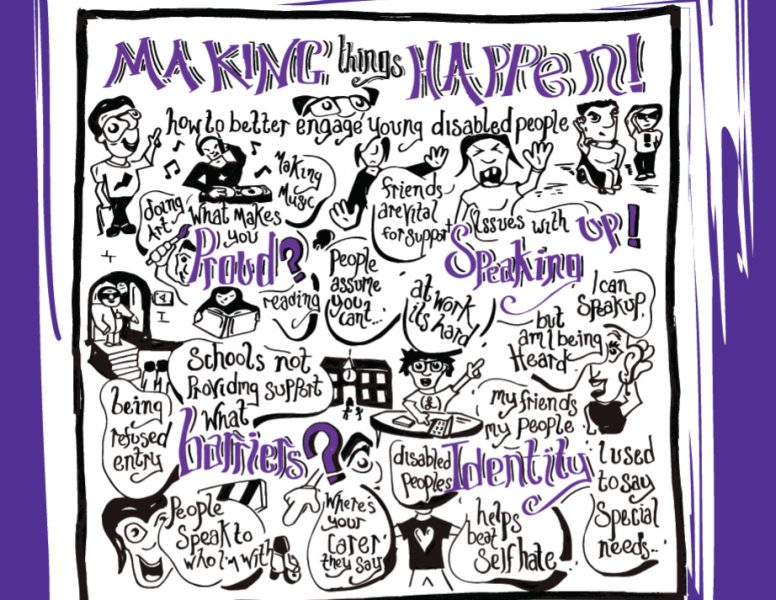
Download full report (pdf): Making Things Happen Project Report
The Making Things Happen project is a 12 month project with a facilitated series of workshops and work experience for Young Disabled People within ALLFIE. The workshops explored how ALLFIE might better engage Young Disabled people in their campaigns work by understanding their current issues and enabling them to work with us to develop initiatives that promote inclusion and that are specifically relevant to Young Disabled people at a grassroots level.
Over August ALLFIE delivered a series of workshops, which presented a range of information covering identity, the social model of disability, understanding barriers and asserting solutions and rights. The purpose of the workshops was to enable Young people to share experiences while providing some key information about inclusion and rights relating to disability.
Due to the Covid-19 pandemic the workshops had to be delivered over Zoom. The five workshops were held during August 2020 and were attended by 8 participants. The project was funded by #iWill. ALLFIE recognised that holding a meeting remotely had advantages and disadvantages in terms of accessibility and digital exclusion.
All workshops were co-designed and co-facilitated with Young people. Young people led on the feedback of the all sessions and the production of this report. This report presents the key themes emerging from the discussions, lessons learnt, a summary of each workshop and some suggested future work initiatives.
ALLFIE Survey Report: Coronavirus Impact on Disabled People’s Education
Read the findings of ALLFIE’s Inclusive Education Survey on the impact of Coronavirus (Covid-19) on education for Disabled pupils and students during lockdown.
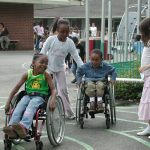 In April 2020 the Alliance for Inclusive Education surveyed Disabled students, their parents and education practitioners, to discover emerging effects of the Covid-19 pandemic following the closure of educational institutions.
In April 2020 the Alliance for Inclusive Education surveyed Disabled students, their parents and education practitioners, to discover emerging effects of the Covid-19 pandemic following the closure of educational institutions.
This report explains our survey findings and covers:
-
- Introduction
- Survey findings
- Conclusion
- References
Introduction
Who is ALLFIE?
The Alliance for Inclusive Education (ALLFIE) is the only national organisation led by disabled people working on educational issues and, in particular, working to promote the rights of disabled students (including those with SEND) to be included in mainstream education, as set out in Article 24 of the UN’s Convention on the Rights of Persons with Disabilities (UNCRPD).
ALLFIE uses the term ‘disabled children and young people’ because many will fall under the definition of disabled persons in the Equality Act 2010.[i]
Why has ALLFIE undertaken this research?
ALLFIE wanted to know how disabled students’ education has been affected as a result of the Covid-19 pandemic after the closure of educational institutions. Whilst statutory education-related services are facing an unprecedented time, we wanted to find out whether decision makers and staff are working within the spirit of the law to ensure that, as far as possible, disabled students’ rights to mainstream education are upheld during lockdown.
The survey
ALLFIE’s survey encompassed three individual surveys: one for disabled students, one for parents and one for education practitioners. We wanted to identify:
- To what extent that schools expected parents to home school their disabled children.
- What support parents received in supporting their disabled children access mainstream education.
- The accessibility and inclusivity of the online platforms.
- Alternative provision for children unable to participate in online learning.
- Disabled students’ experiences of remote education, alternative curriculum and support during closures of universities.
Coronavirus Act 2020
The Coronavirus Act 2020[ii] temporarily modified the Children and Families Act 2014[iii] in the following ways:
- The Secretary of State for Education can issue a notice permitting local authorities to use their reasonable endeavours to secure the education, health and care (EHC) provision as set out in the child or young person’s Education, Health and Care Plan (EHCP).
- Local authorities are permitted to complete the child or young person’s EHC assessment and plan process in any timescales required in the regulations set by the Secretary of State for Education.
For many disabled students (over the age of 18), there have been temporary modifications to the Care Act 2014[iv] around securing care provision that might be needed to access mainstream education.
- The Care Act 2014 allowed local authorities to only provide community care at a level that does not severely interfere with the basic human rights of those needing that care.
Equality Act 2010 duties
The Equality Act 2010 duties remain in place without temporary modifications by the Coronavirus Act 2020. As such, education institutions are still under public sector equality, general anticipatory and individual duties to make reasonable adjustments for disabled students. Furthermore, schools are also required to publish an accessibility plan covering increasing accessibility of the curriculum and information for disabled students.
Remote education and specific legislation
The Public Sector Bodies (Websites and Mobile Applications) (No. 2) Accessibility Regulations 2018[v] requires uploaded content on the websites and mobile applications of publicly funded education institutions to comply with European accessibility standards such as Web Content Accessibility Guidelines (WCAG) 2.1 between September 2020 and June 2021. Education institutions ought to be well on their way to having accessible online learning platforms and as such the Coronavirus Act 2020 would have no impact because the Public Sector Bodies (Websites and Mobile Applications) (No. 2) Accessibility Regulations 2018 remain in place.
UNCRPD Article 24
The Coronavirus Act 2020 does not allow the Government to put aside disabled students’ human rights under their international treaty obligations. The Government is under a positive duty to develop a fully inclusive education system that welcomes all regardless of impairment, health condition or ability under UNCRPD Article 24 and Comment 4.[vi] The UNCRPD Monitoring Committee has published Covid-19 and the Rights of Persons with Disabilities Guidance[vii] with a specific emphasis on remote education.
Disabled pupils and families denied access to mainstream education
Disabled pupils and their families have been particularly adversely affected by the lack of education provision during the closure of schools.
- 83% of parents are expected to home school their disabled children.
- 54% of parents have not received any support from either the local authority or school to help with home schooling.
- 34% of parents have received some (but not a sufficient level of) support to help with home schooling.
Survey findings
ALLFIE has surveyed its members and invited Facebook posts to enlist disabled pupils, university students, parents and educational professionals’ experiences of the provision of education services throughout the Covid-19 pandemic. Survey respondents identified online learning and assistive technology, accessibility of virtual platforms, in-person support and coursework assessment arrangements as being major barriers that disabled students experienced in participating in mainstream education during lockdown.
Online devices and assistive technology
During lockdown, our survey revealed to what extent disabled students have access to the technology and internet access required to complete school, college and university work. Whilst some parents reported that they had the necessary online devices and internet connection to enable their disabled children to engage in remote education, we were informed this is not the case for all, especially for those with a lower socioeconomic status, as this specialist teacher observes:
“Many of [our] learners are without the equipment needed to access Microsoft Teams which is where [the] school is currently setting work. We’ve got 400 laptops in the ICT suite sitting [there] idle. Let’s give them to the children. Let’s give them whatever they need so they can access learning.” (Specialist Teacher ALLFIE Professional Survey April 2020)
Many disabled students are only able to use computer facilities involving expensive assistive technology and hardware provided on-site by the education institutions, as reported by Disabled Students UK:
“A large proportion of disabled students report to us that they have not been given the same tools, software or adapted furniture which they had used and relied on at university…”
The ownership and expense involved in having the same ICT set up at home and on-site has become a real barrier for both disabled students’ ability to learn and complete coursework after the closure of many education institution facilities, including access to computer rooms and labs.
Accessibility of virtual platforms including curriculum
We found that most schools are using virtual remote education platforms so that students can continue with their course learning and work during lockdown. A few disabled students and parents told us of education institutions that have been working tirelessly to make the remote learning experience as inclusive as possible.
“We have a means of video contact with Communication Support staff for planned contact time using BSL [British Sign Language]. Work is set online and accessed daily via an app…Fortunately we have not had any problem so far as my child has good literacy skills and I am also a fluent BSL signer so can explain things if required. School have been good; work set has been realistic and there is [a] means of contacting subject teachers and specialist staff if needed.”
However, for the overwhelming majority of families and disabled students their experience of remote education has been one of exclusion. Some parents have generally commented that the “online learning materials are for neurotypical children only” or “online activities are for other rather than their own disabled children”. These parents share similar views of those articulated by disabled students’ experiences of remote education:
“[There are] Virtual Learning Environments (Blackboard) but the content isn’t accessible 90% of the time. Curriculum content and learning platforms haven’t been changed except more material added – the average accessibility of that online content has actually decreased as speed/readily available content has been prioritised above access.” (ALLFIE Disabled Student May 2020)
Some respondents provided us with examples of their uploaded curriculum. Study materials and lessons are inaccessible for disabled students:
“Many of the core readings for my modules are unavailable online, which adds even more worry to this particularly difficult time. I fear that the university will fail to understand why the quality of my assignments will not be equal to that of my previous work. Circumstances have changed drastically, however, the university does not seem to have grasped this.” (Disabled Student Survey, April 2020)
“The challenge for us is accessing online resources, lots of content isn’t captioned and there is very little in BSL. Tried using BBC Bitesize today and had [the] same problem with clips not being captioned which is frustrating.” (ALLFIE Parents Survey, April 2020)
Aside from the accessibility of online materials, parents have reported that the course curriculum and schoolwork is not inclusive of disabled pupils, as articulated by this parent:
“Every two or three days, a teaching assistant sends us five or six maths worksheets and her art teacher sets work for the whole art class but not [work that is] differentiated for my daughter. Pretty much, that is all that’s being sent..” (Parent Survey, April 2020)
Parents have said that the Oak Academy online lessons and content does not include accessibility features such as BSL interpretation.
Rather than differentiation, schools with remote education facilities have decided to create a segregated curriculum, targeted at disabled pupils with profound learning difficulties.
“The Oak Academy has developed a segregated curriculum for disabled children with profound learning difficulties which [is] not a good example of inclusive remote education. This is not a solution for many disabled children who have benefited from the differentiation of the mainstream curriculum. Parents have told us that they have to source the curriculum themselves without assistance from their school’s teachers and SENCOs.”[viii]
Parents’ experience of remote education is that it will not work for all disabled students because they prefer to learn in a more tactile manner. Whilst most education institutions provide no alternatives, a couple of parents reported how schools are helping to set appropriate school work for their disabled pupils. For example, this parent explains:
“Learning grid with some ideas for simpler learning tasks at home, some actual sums and spelling especially for him. Simpler learning tasks and sent home materials such as cubes, number board and reading books [the] day before lockdown. Not doing online learning, [his] teacher thinks of tasks for me to do with him at home and I submit them through Microsoft Teams.” (ALLFIE Parent Survey May 2020)
Disabled students reported that Higher Education institutions have not undertaken an Equality Act’s Public Sector Equality Duty equality impact assessment around the impact of remote education upon disabled students’ ability to complete their courses. Disabled students reported that higher education online learning platforms have been designed with non-disabled learners in mind, with little consideration paid to the accessibility of the curriculum, study materials and lessons. Similar sentiments have been made by parents who are reliant on individual schools to decide for themselves if and how remote education will be delivered for their pupils within the spirit of Government legislation and policy.
“Parents are at the mercy of individual interpretation of Department for Education advice by headteachers. Some local authorities are more equipped to support schools than others due to austerity cuts. This leads to variable provision.”
Whilst some schools are delivering inclusive remote education, this is not the case for all. Despite the Public Sector Website Accessibility regulations being in place, universities are still failing to make their virtual platforms accessible for disabled students. We have found that virtual platform providers may not be complying with making their online learning opportunities inclusive of all. Whilst virtual platform providers cannot take full responsibility for differentiating the curriculum without prior knowledge of individual students, education institutions have nevertheless failed in their duty to complete this work as required under the Equality Act’s reasonable adjustment duties.
In-person support
The Government permitted NHS England (NHSE) staff to be deployed from their NHSE day-to-day jobs to administrative and health care assistance roles needed to staff the Covid-19 wards. To facilitate this, the Government modified the Children and Families Act s(42) so that local authorities are required to use their reasonable endeavours to secure the SEND provision. The Department for Education are aware that the social distancing guidance could leave disabled students without any support at home during the closures of schools. Consequently, the Department for Education published guidance providing education providers with an extensive list of ideas on how SEND provision can still be arranged remotely for many disabled students.
Research respondents have reported concern over the support that disabled students received during lockdown. Education professionals are aware that families will be at home without any guidance as to how to support their children with their education.
“I am very concerned about young people and families not being supported in relation to [their] emotional, social, and cognitive development.” (ALLFIE Professional Survey May 2020)
“Braille materials [have been] provided for key subjects for [my] eldest child, although this may be withdrawn due to staff redeployment. Currently had no contact regarding [my] youngest child.” (ALLFIE Parent Survey May 2020)
Parents are telling us that they are not in receipt of therapy because therapists have been deployed from working with disabled children in schools to working in support roles on NHSE Covid-19 wards.
Whilst virtual therapy works for some disabled students, this may not be the case for all of them. Education practitioners, parents and disabled students highlight the importance of the continuation of in-person assistance during the Covid-19 pandemic.
“I think the Department for Education comment that education practitioners can be delivering therapy online is far removed from the reality of what we are being asked to do and it is not helpful. We should be ‘out there’ virtually helping parents and schools manage the situation.”
“Non-Medical Help support has become non-existent, with very little left being distanced [including] ‘Skype’ like calls and support which does not really work.” (ALLFIE Disabled Student Survey, April 2020)
“I have to sit with him the whole time he is learning to keep him on task, rather than Google Classroom some kind of FaceTime with an learning support assistant or teacher would help, we need proper support to teach new concepts.” (ALLFIE Professional Survey May 2020)
For various disabled students, there is no replacement for the quality of in-person support provided on-site. Some disabled students learn better face-to-face where the practitioners are providing assistance on-site either within the school or home environment.
“Very much responding to our needs and capacity. Online eye gaze via Zoom and Skype from Speech and Language Therapist Same for physiotherapy [and] mental health support via Zoom, i.e. we meet up with the rest of the class.” (ALLFIE Parent Survey May 2020)
“Online support and contact newsletters, with additional resources and ideas. Much more practical ideas for learning, and Occupational Therapist, Speech and Language Therapist ideas etc. Mental health [and] well-being has been at the forefront of the thinking of our school.” (ALLFIE Parent Survey May 2020)
Strong emotional support comes from the development of personal relationships between practitioners and families or disabled students. Negative impact of social isolation during lockdown has taken its toll on disabled students, as highlighted by these parents:
“Students are finding it difficult at home, lack of motivation, [not] understanding the work being set and not being with their friends. Seeing high levels of anxiety and there [has] been a rise in some of our very vulnerable students self-harming.” (ALLFIE Parents Survey May 2020)
“Being isolated in lockdown during the final months of a university degree is difficult for most but [for] those with disabilities, in particular [those] on the autism spectrum, this has been a massive barrier to learning and has severely affected their mental health.” (ALLFIE Disabled Students Survey 2020)
Education aside, education professionals and families have expressed concern over the social isolation their disabled children are experiencing without school intervention. Schools have failed to set up WhatsApp groups as a way of reducing the social isolation experienced by disabled pupils, particularly if they are not in any school friendship groups.
Education practitioners and parents have expressed concern over the lack of appropriate schoolwork, SEND provision and school routine for prolonged periods of time and its impact upon disabled pupils. Education practitioners have warned that five months without formal education will have a profound impact upon the education progression and attainment gap between non-disabled and disabled pupils and their life chances. Indeed, practitioners have warned:
“I am Speech, Communication and Language Therapist -based within a mainstream junior school. My pupils are not in school and some are struggling to access online learning opportunities. [I am] concerned that [the] existing gap will widen further and that pupils will need an extended period of readjustment on [their] return to school.” (ALLFIE Education Professional Survey April 2020)
Despite local authorities being required to use their reasonable endeavours to secure SEND provision, we have found that the majority of disabled children are at home without any assistance that would enable engagement in remote education and completing schoolwork.
Local authority assistance
Local authorities are still under a duty to arrange both SEND provision and educational placement for all young people up to the age of 25 completing courses up to A Level (Level 3) course standards. Apart from social care provision, local authorities have no duty to provide educational provision for young disabled people completing higher education courses.
School attendance
Schools that remained open during lockdown have been expected to prioritise providing education for disabled children with EHCPs alongside the children of key workers. During this period of time, many parents accepted that their disabled children will be educated at home.
“The focus needs to be on keeping children and young people safe, but far more could be done to support families. Systems, including in my own service, have been too reliant on families’ [schooling]. There needs to be much more holistic support for families with better communication across agencies. Services need to fit families flexibly rather than the other way round. This is particularly so for support for social, emotional and mental health – fixed pathways and venues are not what is needed.”
There are parents who felt that sending their disabled children to school would be too risky.
“Local authorities should have [provided] full support during [lockdown] and not force us to send my child to school while my husband and I are in the at risk category.” (ALLFIE Parents Survey May 2020)
Similarly, some parents decided it was in the best interests of their disabled child to attend school.
“I have fought for her to go back to school and can only send her in two half days because they say the teaching assistants have to have five days in between working with her. The other kids are in school every day though.” (ALLFIE Parents Survey May 2020)
Families reported that, in general, there has been either none or insufficient engagement between themselves and the local authority’s SEND department, who have a responsibility to arrange therapy, mental health and social care services and the provision of specialist equipment such as play equipment. From many families’ perspectives, it appears that local authorities have interpreted the “reasonable endeavours” to mean no endeavours to secure the SEND provision for disabled pupils with EHCPs.
“Plans have been modified to ensure reasonable endeavours are legally shown but the reality is if they’re not in school [then] we’re relying on parents delivering mostly, not a lot.” (ALLFIE Practitioner Survey 2020)
“The local authority is appalling. Social care support and the behaviour of the leadership of the SEND department is an utter disgrace. A national scandal.” (ALLFIE Parents Survey 2020)
Except for a few, families experiences have been that the local authorities are not working in the spirit of the Children and Families Act modified s(42) duties.
Conclusion
Whilst a few disabled students have been well-supported in continuing with their mainstream education at home, this has not been the case for the overwhelming majority. There has been little-to-no forward planning of the continuation of disabled children’s education at home. The Children and Families Act’s easements and school closures have meant that the majority of disabled children and young people have been without SEND, Health and Social Care provision and a curriculum for over five months.
Moreover, the majority of schools have not provided any differentiated online or alternative off-line curriculum for disabled pupils, despite NHSE and school staff remaining on the payroll. This is not helped by school online platform providers failing to consider the incorporation of accessibility features into their virtual lessons and uploaded curriculum.
Disabled university students’ experiences are similar to those of disabled school students; they have reported being unable to continue with their courses online because of the inaccessibility of the curriculum and alternative provision to remote education. Whilst the non-availability of non-medical support and assistance is not such an issue, disabled students have expressed their preference of support provided on site rather than remotely.
Similarly to schools, higher education disabled students’ services have not been available for disabled students. Whilst families and disabled students and practitioners know that providing education provision for disabled students during lockdown will be challenging, what has surprised us is the thorough lack of any education being arranged for disabled students, leaving them with no or very limited access to mainstream education despite the Department for Education’s Covid-19 SEND guidance and the Equality Act 2010 still being in place.
The Coronavirus Act 2020 and subsequent education and social distancing guidance have not only provided insufficient protection against disabled students being denied mainstream education, but we also believe that the Government are in breach of their UNCRPD Article 24 obligations in arranging inclusive education provision even during lockdown.
“It is without [a] doubt a travesty of our time that non-disabled people are struggling to make adjustments to [their] everyday life due to Covid-19. And yet for far too long disabled people have been denied equal rights to mainstream education. No other group has been systematically excluded from mainstream education because of their personal characteristics, i.e., their impairment.” (ALLFIE Practitioner Survey 2020)
References
[i] Equality Act. (2010). Retrieved from https://www.legislation.gov.uk/ukpga/2010/15/contents
[ii] Coronavirus Act. (2020). Retrieved from https://www.legislation.gov.uk/ukpga/2020/7/contents/enacted
[iii] Children and Families Act. (2014). Retrieved from https://www.legislation.gov.uk/ukpga/2014/6/contents/enacted
[iv] Care Act. (2014). Retrieved from https://www.legislation.gov.uk/ukpga/2014/23/contents/enacted
[v] The Public Sector Bodies (Websites and Mobile Applications) Accessibility Regulations. (2018). Retrieved from https://www.legislation.gov.uk/uksi/2018/852/contents/made
[vi] Convention on the Rights of Persons with Disabilities. (2008). Retrieved from https://www.un.org/development/desa/disabilities/convention-on-the-rights-of-persons-with-disabilities/article-24-education.html
[vii] United Nations. (2020). Covid-19 and the Rights of Persons with Disabilities: Guidance. Retrieved from https://www.ohchr.org/Documents/Issues/Disability/Covid-19_and_The_Rights_of_Persons_with_Disabilities.pdf
[viii] Special Needs Jungle. (2020, May 4). What’s wrong with Oak Academy’s specialist curriculum? Retrieved from https://www.specialneedsjungle.com/whats-wrong-oak-academy-specialist-curriculum/
Accessibility Plans as Effective Tools for Inclusion in Schools: Are They Working?
ALLFIE’s ground-breaking research project report, authored by Dr Armineh Soorenian and funded by Disability Research on Independent Living and Learning (DRILL).
You can read or download the pdf report here.
You can read or download the easy-read version of the report here.
This project draws on focus groups, surveys and interviews with Disabled secondary school pupils and their parents and with education professionals across England. It was overseen by the Alliance for Inclusive Education (ALLFIE).
The law, Accessibility Plans and Disability in schools
Since 2002 all schools have been required by law to publish and implement Accessibility Plans. These plans are meant to set out how, over time, schools will improve:
- the supply of information to parents of Disabled children and young people
- physical access
- teaching and assessment to meet individual need.
By failing to publicise and implementing their Accessibility Plans, schools might be breaching the Special Educational Needs and Disability Act (SENDA) 2001 and the Equality Act 2010 – as well as breaching our international legal obligations.
Under the Equality Act and the 2015 Code of Practice for the Act, schools must not directly or indirectly discriminate against, harass or bully Disabled children and young people. They must make reasonable adjustments – including in teaching and assessment to ensure that Disabled pupils are not at a substantial disadvantage compared with their peers.
Our surveys and focus groups suggest many schools fail to meet these requirements.
Parents participating in the project were confused about their legal rights and wanted to know more about how they could challenge unlawful disabling practices.
Recommendations
- Unlawful and disabling practices must be challenged, primarily by councils. Parents and Disabled young people need a statutory route to challenge schools in the courts.
The UN Convention on the Rights of Persons with Disabilities (UNCRPD)
The UK government signed the UNCRPD in 2009. Article 24 guarantees all Disabled pupils and students a right to participate in all forms of mainstream education. However, the UK placed ‘reservations’ on this when it signed the convention. The UK remains out of step internationally on equal access to education.
Disabled pupils’ individual requirements and needs are often not considered and they are unable to reach their full potential, which again breaches Article 24.
The Disabled young participants are frequently discriminated against due to their impairments – in contravention of Article 5 of the Convention – and had no equal and effective legal protection against discrimination. Limited access to information and poor physical access contravenes Article 9 of the convention.
Disabled pupils are also not able to fully enjoy all human rights and freedoms on an equal basis to other children. They are often denied opportunities to learn and play with their friends which amounts to segregation – contravening Article 7.
Accessibility Plans – a well-hidden secret
Some 17 years after the requirement to produce Accessibility Plans was introduced, schools are failing in their legal duty. Most Disabled young people are facing more barriers than ever.
This has a shocking impact on disabled children and their families.
Disabled young people and their parents are given little or no information – even around the existence of Accessibility Plans. Often parents take 30-40 minutes to find the plans on the school website – with many only looking after we told them they existed. It is therefore unsurprising that few have been involved in their production, development or review. Just 7% of parents had been invited to participate in developing the plans for their child’s school.
None of the parents we spoke to knew anyone who had used an Accessibility Plan to appeal against disabling practices. Many parents did not even know that schools are legally required to provide lifts, ramps or other reasonable adjustments.
Accessibility Plans – fine words but the reality is often very different
Those parents who found their school’s plan felt it was a tick-box exercise. Their promises around access and support are unfulfilled and the fine words are meaningless in practice. Parents agreed that the culture and ethos of a school would determine if the plans were embedded in everyday school life and decisions.
Disabled young people and their parents across England told us they feel let down by their schools and the negative attitudes and lack of understanding from staff the encountered.
One parent suggested schools can use Accessibility Plans to avoid putting reasonable adjustments in place: “The plan can say, ‘We’re not going to do anything’.”
Parents’ scepticism was reinforced by one professional, who told us: “Generally there are quite a few schools that have the documents, but only a limited number of schools embed (them) into practice, and therefore there are very few schools where it actually functions.”
Only 20% of parents in the online survey felt the plans had improved the opportunity for their child to take part in activities, while 23% felt they had improved access. Amongst professionals the figures were 48% and 51% respectively.
Accessibility Plans are supposed to improve the delivery of written information but Disabled pupils generally felt provision in this area is poor. The professional participants recognised that their schools tended to only respond to requests rather than provide information in alternative formats as standard practice. Rather than seeing this as a shortcoming on their part or that of their schools, they blamed funding or low uptake by pupils.
ALLFIE is calling for comprehensive national guidelines to support schools in producing robust Accessibility Plans. They are looking to work with young Disabled people to produce an Accessibility Plans Toolkit for schools. We need more research on the quality of Accessibility Plans and how they are implemented.
Disabled young participants and parents suggested that teachers, headteachers and senior managers should receive regular impairment-specific disability and inclusion training.
Local authorities, Ofsted and the Department for Education are failing to hold schools to account for the quality, visibility and implementation of their Accessibility Plans – which are a legal requirement. Many schools are failing in their duties and new legislation is needed. Almost two-thirds of the 127 LAs who responded to our Freedom of Information Act request did not even know if their schools had Accessibility Plans in place.
Recommendations
- The Department for Education needs to monitor, promote and enforce the positive and continuous development and implementation of Accessibility Plans.
- Schools and councils need to fully involve parents, Disabled children and professionals in the production, development and review of Accessibility Plans.
- OFSTED should have a legal duty to routinely monitor the impact and implementation of Accessibility Plans, and to include their findings in school inspection reports.
- Accessibility plans should include compulsory training packages for teachers, headteachers and senior management teams, with regular mandatory updates.
Admissions
In choosing a school for their Disabled child, parents want the same choices and opportunities as other parents – with the clear opportunity to choose a mainstream school. To do so, they need transparent information and reliable support from schools and local authorities – which all too often they are denied.
Instead they face prejudicial and negative attitudes from staff during the admissions process. This prevents many Disabled children and young people from attending their preferred school.
A school rated outstanding by Ofsted told one mother that they ‘just couldn’t take’ her son.
Yet professionals involved in our focus groups and surveys did not recognise these barriers, believing their school’s admission process was no different for Disabled pupils.
We found parents are sometimes forced to choose a special school or home schooling due to fears about inadequate support levels for their child’s educational and other needs. This separation from friends led to mental health problems for some children.
Despite legal protection, the percentage of SEND pupils in mainstream schools has fallen by 24% since 2012 while the number in special schools has risen by nearly a third.
However, instead of funding inclusive and improved provision in mainstream education, the Government is planning costly new special schools.
Accessibility Plans must focus not only on the removal of physical barriers in schools, but on challenging attitudinal, physical, systemic, and other obstacles within the admissions process so Disabled learners can attend their preferred school.
Access
Parents of Disabled young people were generally critical of schools’ physical structures and barriers to access, enjoyment and participation. These include noise and lighting as well as physical obstacles. Children with neurological conditions or autism could be affected by the fluorescent lighting or large groups of children moving around the school at regular intervals.
Disabled children and young people and parents complained about heavy doors, steps and the absence of ramps and lifts/broken lifts. Parents said many accessibility problems arose from the small size of classrooms. Sometimes wheelchair users sit in a corner or by the door where they cannot interact with other children or participate properly in the class.
In schools without lifts disabled children of all ages would be in one classroom with their lessons handed to them on paper. One parent observed: ‘It’s not even teaching. It was just literally giving them paper and saying, “This is your lesson. This is what you’re expected to do today,” and that was it. I don’t even think it was a qualified teacher in there. I honestly think it was a TA. It’s shocking, absolutely shocking.”
Asked in our survey if they thought their child’s school was accessible, 42% of parents of Disabled children and young people said yes, 27% no and 31% said ‘sometimes’. Staff showed bias and inflexibility when asked by parents to address barriers. Clearly, legal duties are often not being met.
Teaching, Learning and Assessment
Teaching/learning methods and assessment procedures should be inclusive and flexible.
Parents often encountered insensitive and discriminatory responses to requests for reasonable adjustments in teaching and assessment to meet their children’s impairment-related needs. Some worried that the various pressures and discrimination around access and learning could ‘break’ their children socially – and possibly emotionally.
Disabled young participants feel the playing field is not level in terms of their ability to participate in classroom activities and the school curriculum – particularly in assessment.
Programmes should be put in place to adequately support Disabled young people, ensuring a consistent and rights-based approach to education. Teaching and assessment procedures must be responsive to – and support – each child’s needs.
British Sign Language should be taught as a modern language while the English curriculum should include emotionally accessible content.
Some rents are told their child is ‘difficult’ and the school refuses to teach them fulltime. Some children only attend school 2-3 days per week under a ‘part-time contract.’ Disabled children make up around 45% of all exclusions. One parent spoke of his child being described by the school as ‘ineducable’ but after home schooling he is doing a chemistry GCSE a year early.
The education professionals who participated in our focus group or survey felt that an effective Accessibility Plan would help schools prepare classroom support for individual students, whether through new use of resources or by adjusting teaching methods. They felt that Disabled pupils would then be able to access their lessons and improve outcomes.
Recommendation
- Teaching staff must structure their teaching around a commitment to maximising all students’ learning experiences by using methods such as multi-level instruction, co-operative learning, individualised learning modules, activity-based learning and peer tutoring.
Social Inclusion
The Disabled young participants feel many barriers prevent them fully participating in their school community. These include prejudice, poor transport facilities, few trained staff during social time, and inaccessible school activities. This led many to feel isolated – which affects their confidence and self-esteem.
Some of the children report spending break and lunch by themselves to avoid bullying. Others don’t go on school trips – particularly longer ones – for resource or support reasons.
Social inclusion in schools should be a key part of any Accessibility Plan – not an add-on.
Although Accessibility Plans are not required to address social inclusion, it is clear that schools should be required to work towards full social inclusion and participation.
Recommendation
- For schools to create more opportunities for Disabled pupils to socialise with Disabled and non-disabled children in fully accessible settings, including accessible playgrounds and outdoor activities. Accessibility Plans should include anti-bullying strategies.
Inclusion Now 54 Autumn 2019
Intersectionality, UN Sustainable Development Goals, Disability History Month and more.
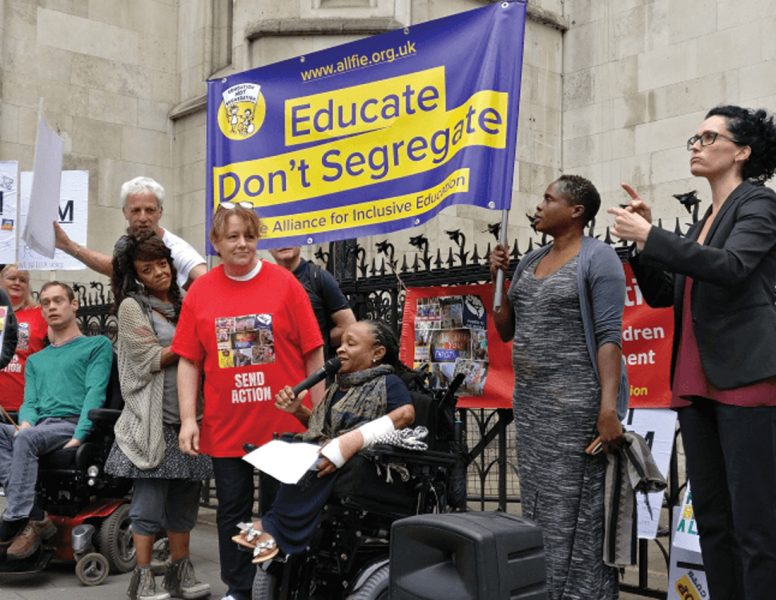
Inclusion Now magazine | published by disabled people, for disabled people
a unique voice for disability rights in UK education
Welcome to the 54th edition of Inclusion Now. Audio and text versions are below or you can read it in magazine format on Issuu
- Sign up for ALLFIE membership for a printed copy of Inclusion Now 54
- Subscribe to our email list get it hot off the press in accessible digital formats including audio
Your ongoing support is fundamental to our charity’s work and greatly appreciated.
ALLFIE campaigns for children and young people to be supported to manage disability within the UK education system.
Inclusion Now is produced in collaboration with World of Inclusion and Inclusive Solutions
Back Up’s inclusion toolkit
The Back Up Trust have produced an education toolkit aimed at young people with spinal cord injuries, their parents, teachers and health care professionals. Much of it is applicable to young people with other impairments.
![Allfie [logo]](https://www.allfie.org.uk/wp-content/themes/allfie-base-theme/assets/img/allfie-logo-original.svg)
